Ontario
Helen K. Warner
Helen K. Warner, “Ontario,” in Canadian Mormons: History of the Church of Jesus Christ of Latter-Day Saints in Canada, ed. Roy A. and Carma T. Prete (Provo, UT: Religious Studies Center; Salt Lake City: Deseret Book, 2017), 360-411.
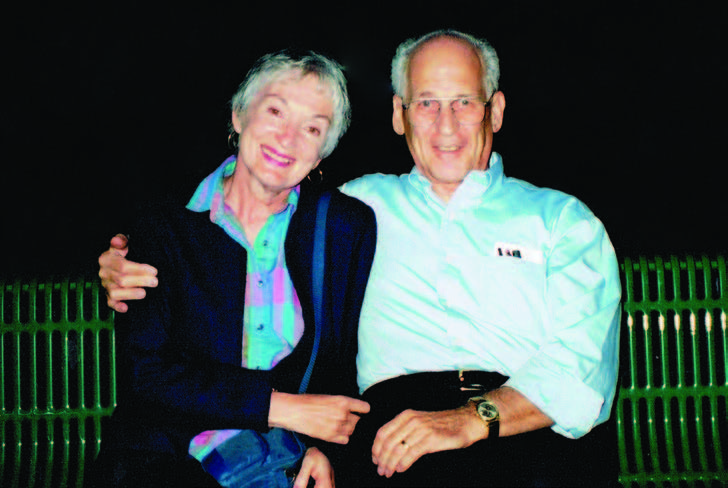
Helen K. Warner graduated from the University of Waterloo, was a researcher and docent at the Church History Museum in Salt Lake City, Utah, and has served on the Board of Directors of the Layton Heritage Museum (Utah) and on the Brampton Ontario Heritage Board, where she also served as a researcher. The author of local and Church histories, she has published in Regional Studies in Latter-day Saint Church History: Ohio and Upper Canada, and was a contributor to the Brampton Heritage Times. She has served as “mission mother” in California, as matron of the Toronto Ontario Temple and more recently as public affairs director for Ontario, Quebec, and the Atlantic Provinces. She has organized family history conferences in both California and Ontario and was involved with the Mormon Tabernacle Choir’s visits to Toronto in 2007 and 2011. She is the mother of four, grandmother of ten, and great-grandmother of three. (Helen Warner)
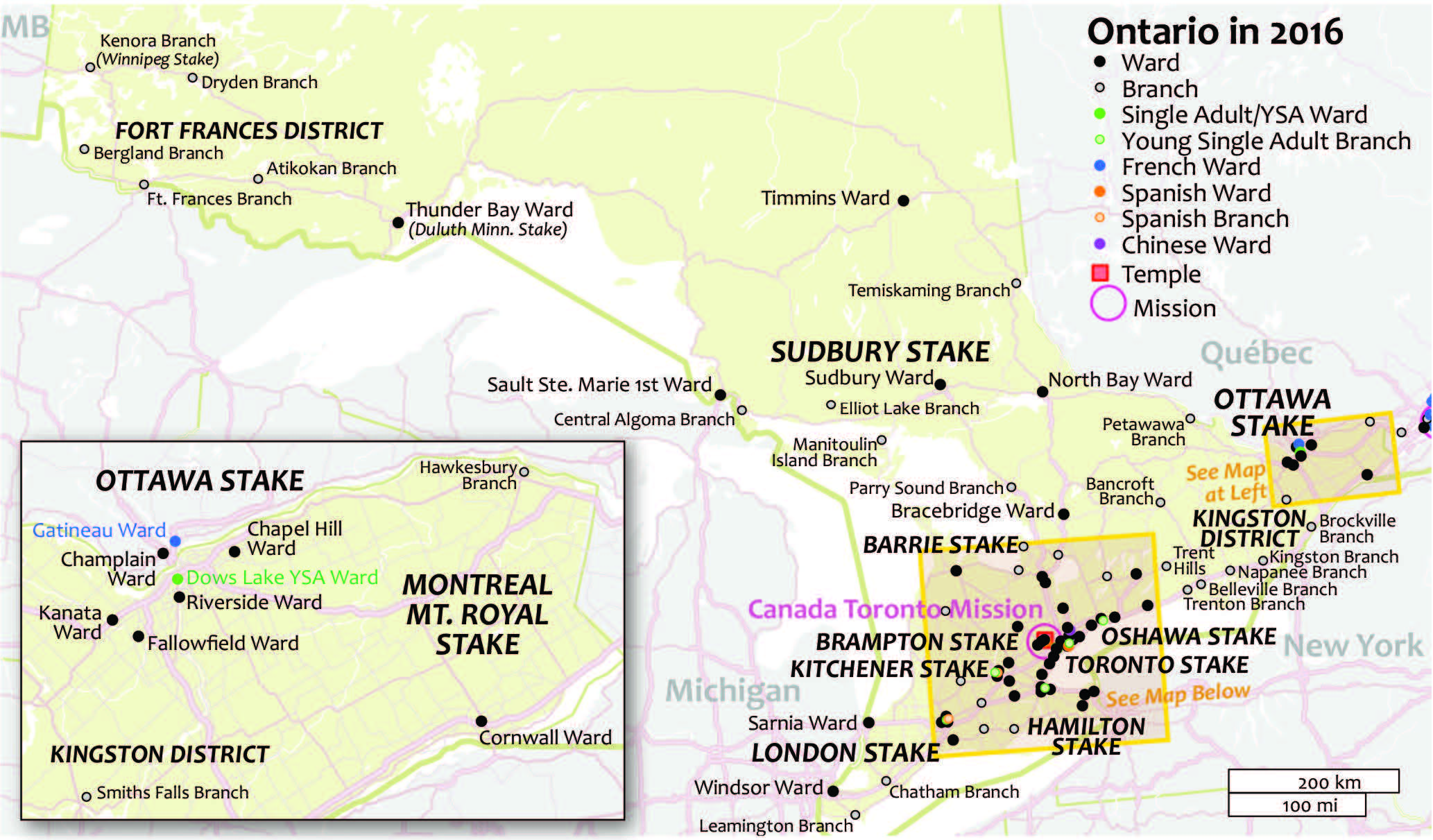
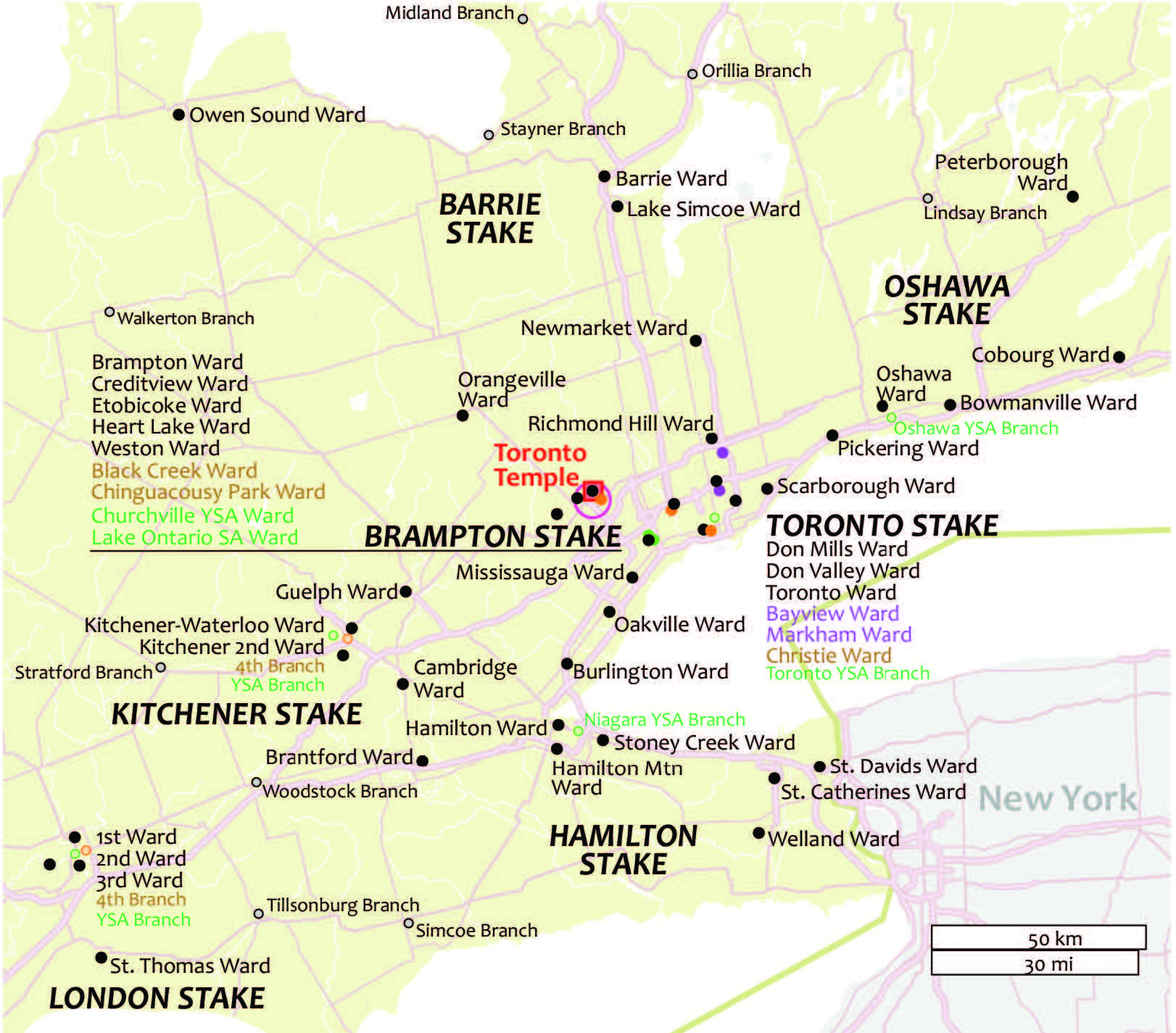 After a long absence of several decades, missionaries returned to Ontario at the dawn of the twentieth century and began baptizing a few converts, and a few Latter-day Saints moved into the province from other areas. From this humble beginning, the Church has grown to have nine stakes, two districts, and a temple by 2016.
After a long absence of several decades, missionaries returned to Ontario at the dawn of the twentieth century and began baptizing a few converts, and a few Latter-day Saints moved into the province from other areas. From this humble beginning, the Church has grown to have nine stakes, two districts, and a temple by 2016.
The early history of the Church in Ontario is peppered with the names of the leaders of the Restoration. Joseph Smith, Brigham Young, Parley P. Pratt, and a host of others came to announce that the gospel of Jesus Christ had been restored and that prophets again walked on the earth. It is estimated that up to 2,000 converts heeded their message and joined the newly restored religion in Ontario (then called Upper Canada).[1] Most of them left for the United States, responding to the call to gather to Zion, and travelled first to Kirtland, Ohio, or to Far West, Missouri, on to Nauvoo, Illinois, and finally to the Great Salt Lake Valley in Utah. Many converts left Ontario in the face of fierce persecution and alienated family members. No doubt, they could not have even imagined a time when their descendants would return as missionaries and mission presidents and see a thriving Church in Ontario with chapels, wards, stakes, and even a beautiful temple. How this came to pass is a story of faith, devotion, and sacrifice by hundreds of stalwart members and missionaries struggling in small, often isolated branches, sharing their testimonies, constantly building the membership, and raising the profile of the Church.
A New Beginning
After the main body of the Saints left Ontario and went west, few Church members remained. The 1861 Canadian Census recorded just under 100 members in the province.[2] The few sporadic missionary visits to Ontario between 1857 and 1877 did not result in any converts.
With the establishment of the Eastern States Mission in 1893, missionaries again began to labour in Ontario intermittently, but had a decidedly unfriendly reception. Even though the Church had announced the discontinuation of polygamy in 1890, the press continued to rail against Mormons.[3] Another impediment to missionary work was that the Reorganized Church of Jesus Christ of Latter Day Saints (RLDS) was already well established in Ontario by the time Latter-day Saint missionaries renewed their proselytizing efforts, and RLDS ministers were sometimes at the forefront of organized opposition to the missionaries.[4]
There is no record of any convert baptisms in Ontario after 1857 until the early 1900s. The first known Latter-day Saint converts in the twentieth century were Annie Miller Kindy and her eighteen-year-old daughter Clara, were baptized in Toronto in 1904. These women continued faithful, showing kindness and hospitality to many missionaries in the following years.[5] Other converts joined them, and the new Church members energetically supported missionaries’ efforts by attending street meetings and sharing the gospel with others.[6] A Sunday School was organized in Toronto, and a conference was held in Toronto’s Labour Temple in 1907,[7] but by the end of that year, the Sunday School had been discontinued because so many of the local members had moved to “Zion.”[8] But missionary work in Toronto continued unabated, with enthusiastic missionary reports. Missionaries in Ontario, who had been assigned to the New York Conference in 1908, became part of a new Canadian Conference in 1913.[9]
Unbeknownst to the missionaries in Toronto, there were at least a few other members of the Church in northwestern Ontario. In June 1903, Guttorm Thorgrimsen Bjerke and his wife, Maren Olava Olsen Arvesaet, who had been baptized in Norway and were on their way to Utah, settled in Fort William when illness prevented them from continuing their journey.[10] Why Fort William? It was on the Canadian Pacific Railway route to the west. In addition, two brothers, John and Christian Olson, who had joined the Church in Sweden, came with their families to Bergland, near Lake of the Woods, several hundred kilometres northwest of Port Arthur, in 1910, forming a small group that remained isolated from Church contact for over a decade.[11]
In 1912, cottage meetings were being held every night of the week in Toronto, with resulting baptisms. One local member, Harriet Westmancotte, was specifically mentioned as being helpful in missionary work.[12] A sympathetic newspaper article on missionaries raised awareness of the Church in Toronto and enabled three Church members, who had recently moved there from Europe, to connect with the local congregation.[13] A Sunday School was organized in 1912 with local leaders,[14] and in October 1912 attendance at meetings averaged fifty, including members and sincere investigators. By 1913, a branch was created.[15]
Missionaries laboured in other areas of Ontario as well. Walter Hopcraft, a prominent businessman in Bracebridge, started preaching the gospel to the townsfolk. Missionaries from the New York Conference travelled to Bracebridge to conduct baptisms as early as 1911.[16] Although the elders were threatened with mob violence, they continued their work in Bracebridge.[17] By 1918, both a Sunday School and a Relief Society were functioning there.[18] However, by 1921 the group had been discontinued because so many families had moved away.[19]
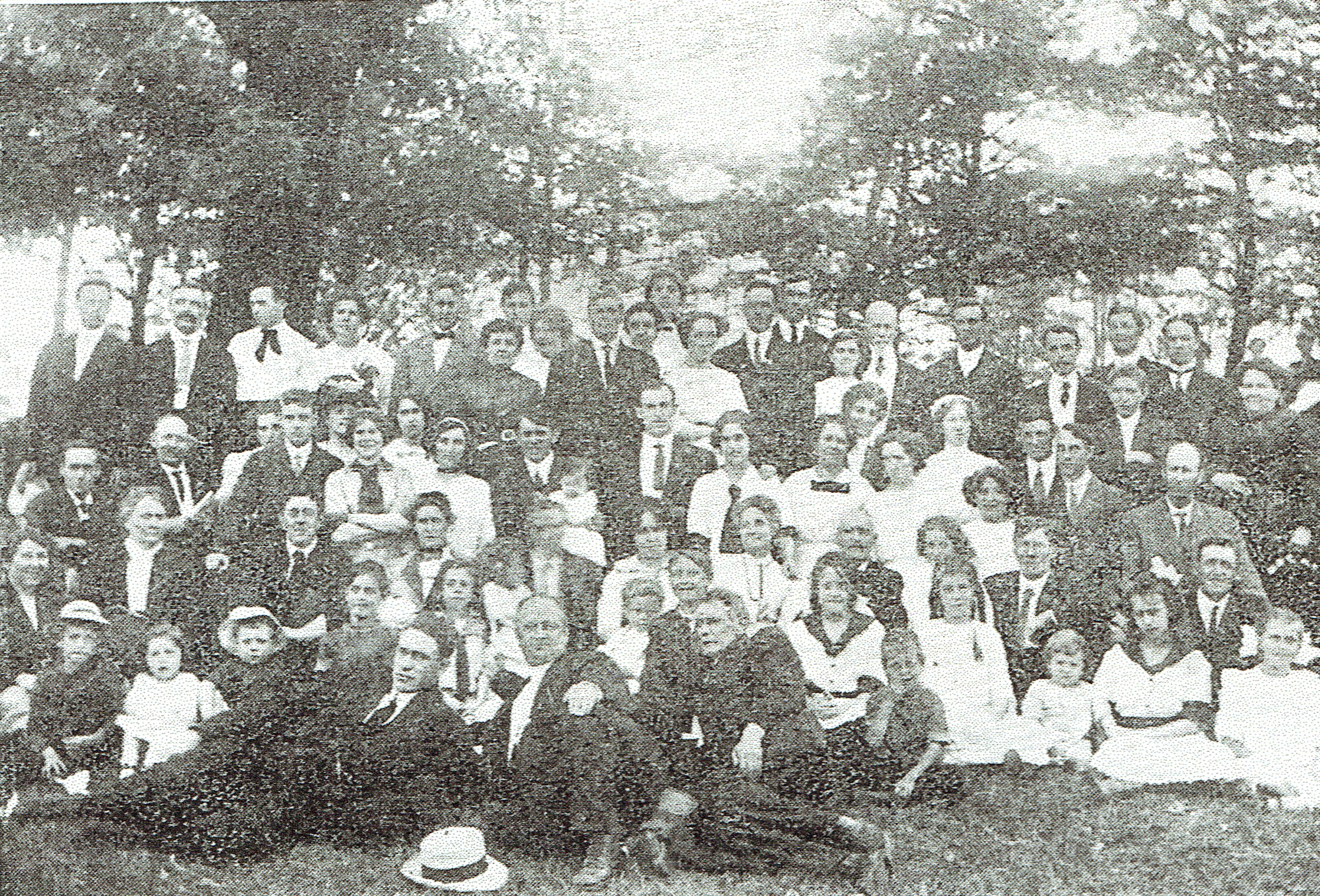 On Monday, 4 August 1913, missionaries, members from the Toronto Branch of the Canadian Conference, and their friends enjoyed a picnic at High Park on the Civic Holiday. Liahona, the Elders’ Journal says there were eighty people in attendance including mission president Ben E. Rich.[20] (Liahona, the Elders’ Journal [hereafter Liahona])
On Monday, 4 August 1913, missionaries, members from the Toronto Branch of the Canadian Conference, and their friends enjoyed a picnic at High Park on the Civic Holiday. Liahona, the Elders’ Journal says there were eighty people in attendance including mission president Ben E. Rich.[20] (Liahona, the Elders’ Journal [hereafter Liahona])
Hamilton also became a center of Church activity. Olivia Peterson, from Huntsville, Utah, “who at one time had David O. McKay as a school teacher,”[21] had married a travelling salesman from Brantford, Ontario, and they settled in Hamilton with their two children before the First World War.[22] In 1913, missionaries in Hamilton sought permission to hold street meetings, but were denied. The following year, they were finally granted permission to hold street meetings, but they were vigorously opposed by local ministers, who launched a barrage of negative and untrue information about the Church in local newspapers. In spite of this opposition, a Sunday School was established in Hamilton in 1914.[23]
Meanwhile, Church members in Toronto, who had been holding meetings in a rented hall for some time, were unexpectedly “put out” of their hall in August 1914, when their landlord, under pressure of “another religious organization,” discontinued the rental arrangement. For several months, until Church members were able to secure another suitable hall, they held cottage meetings in the homes of local members.[24]
In 1915, missionaries renewed their work in Preston (now part of Cambridge) where a few converts had been made previously.[25] As well, missionaries from the Northern States Mission, working in Detroit, Michigan, began regular visits to Windsor, Ontario, just across the river, in 1915.[26]
With the onset of World War I, missionaries reported that their street meetings were less successful because the people were so preoccupied with the war. A number of men from the Toronto congregation went overseas to serve in the Canadian military, including William Brown, superintendent of the Sunday School. Their departure seriously slowed the progress of the Church.[27] In spite of the wartime conditions, a Relief Society was organized in Toronto in 1915, with Harriet Westmancotte as president, and the Young Men’s and Young Ladies’ Mutual Improvement Association (MIA) also functioned in the Toronto Branch that year. A local member, John M. Burns, was appointed president of the Toronto Branch in April 1916.[28] Relief Society women contributed to the war effort by preparing packages for servicemen overseas, knitting socks for the Red Cross, and collecting food and clothing for the needy.[29] Relief Society women gained increased respect and gratitude from the community through caring for victims of the devastating influenza epidemic of 1918.[30]
In spite of the reported slowdown of missionary work, more areas of Ontario were opened during the war, including Orangeville, St. Catharines, Brantford, Galt, Goodwood, Simcoe, Ottawa, Orillia, and Kingston.[31] Missionaries in Bracebridge had continuing success, with more baptisms, and, in 1916, Church members were already formulating plans to construct a meetinghouse.[32] By 1918, over twenty baptisms had been recorded in the town.[33] In 1917, the Saints in Brantford had secured a hall where they could hold regular Church services, with twenty to thirty people attending.[34]
Opposition nonetheless continued in Ontario, not only from other churches, but often from police and governmental officials. Despite the challenges, scattered Church members became a nucleus of future Church growth in several places. When the Canadian Mission was established in 1919, there were already branches of the Church functioning in Toronto, Hamilton, and Brantford,[35] as well as a vigorous Sunday School and Relief Society in Bracebridge and a Relief Society in Preston.[36]
The Canadian Mission
In 1919, Church President Heber J. Grant announced the creation of the Canadian Mission, which would encompass areas in Canada formerly covered by the Eastern States Mission and the Northern States Mission, and that Nephi Jensen had been chosen as president of that mission.[37] In general conference, just weeks before opening the Canadian Mission in July 1919, Nephi Jensen reflected on the magnitude of his imminent responsibility: “I want to tell you, in the depths of humility, that I feel altogether inadequate to the task that has been assigned me.”[38] Such feelings were hardly surprising. The new mission covered six Canadian provinces: Manitoba, Ontario, Quebec, New Brunswick, Nova Scotia, and Prince Edward Island, stretching over immense distances, at a time when travel by rail was the norm. It had been decided that the mission headquarters would be in Toronto, Ontario, the populous centre of Canada’s financial system. In 1911, Ontario had close to 30 percent of Canada’s population and was its leading manufacturing province.[39]
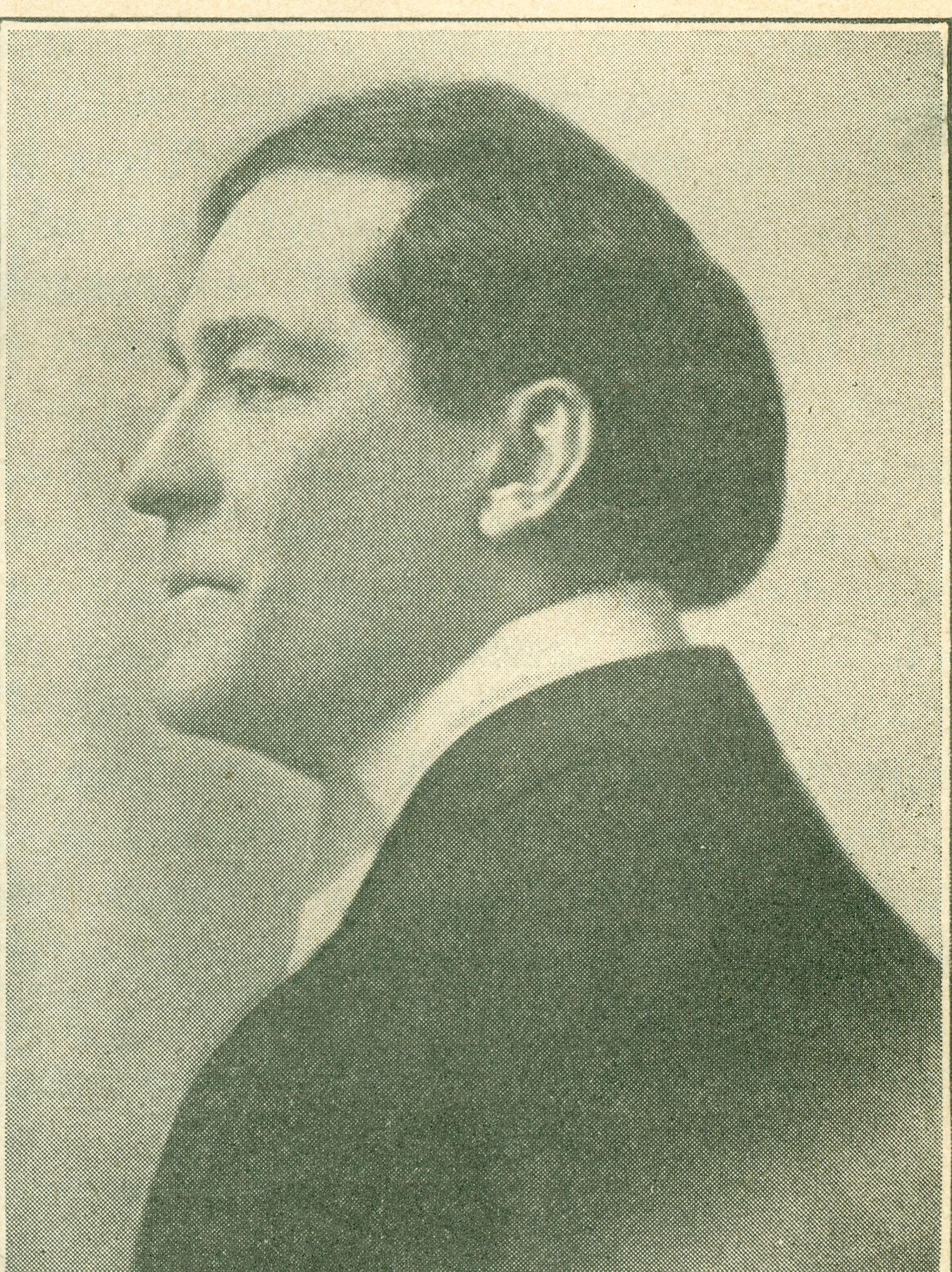 Nephi United States Centennial Jensen[40] was born in 1876 in Utah to Danish converts of the Church. A noted attorney, speaker, and author, Jensen served a term in the Utah Legislature prior to presiding over the Canadian Mission from 1919 to 1923, accompanied by his wife, Margaret. (Church History Library)
Nephi United States Centennial Jensen[40] was born in 1876 in Utah to Danish converts of the Church. A noted attorney, speaker, and author, Jensen served a term in the Utah Legislature prior to presiding over the Canadian Mission from 1919 to 1923, accompanied by his wife, Margaret. (Church History Library)
In many ways, Ontario was quite different from President Jensen’s home state of Utah. When he left Utah, the population of that state was 449,396[41] and Salt Lake City was the fifty-seventh largest city in the United States with 118,110 citizens.[42] Ontario’s population, on the other hand, was 2,523,274 in the 1911 Canadian Census,[43] and Toronto with a population of 377,000[44] was the second largest city in Canada. He found that the population of the province of Ontario was mostly Anglo-Saxon, that strict rules dictated Sabbath activities, that winters were bitterly cold and stormy, and that summers could be hot and humid.
The province of Ontario alone stretches from the United States border in the south to Hudson Bay in the north, from the Manitoba border on the west to Quebec on the east, with an area of over 1,076,000 km2 (415,000 mi2). Like most of Canada’s provinces, Ontario has a varied landscape. There is fertile farmland in the south close to the waterways, and grassy lowlands in the north, which are separated by the rocky, mineral-rich Canadian Shield which covers two thirds of the province.[45] Ontario’s capital city is Toronto, and Ottawa, the nation’s capital, is in the eastern part of the province bordering the province of Quebec. During the 1830s and 1840s, most converts of the Church in Ontario were found in the population centres along the waterways. In the 1900s, converts came from the cities along the rail routes.
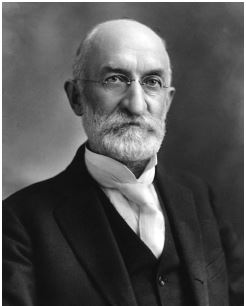 Heber J. Grant, President of the Church, visited the Canadian Mission in November 1919, where he delivered a “spirited discourse on the manifestation of the power of God in the Church” to Saints and their friends at the O’Neill Hall, 186 Parliament Street. (Intellectual Reserve, Inc.)
Heber J. Grant, President of the Church, visited the Canadian Mission in November 1919, where he delivered a “spirited discourse on the manifestation of the power of God in the Church” to Saints and their friends at the O’Neill Hall, 186 Parliament Street. (Intellectual Reserve, Inc.)
The Church was not held in high regard in Ontario. Sir Arthur Conan Doyle’s 1886 story, A Study in Scarlet, which painted a lurid portrait of polygamous Mormons in Utah, was widely read, and British and American newspapers carried highly inflammatory articles about the Mormons, which were picked up by Canadian papers. There were few members to correct the errors. President Jensen was a gifted speaker and well chosen for his assignment. He was a lawyer and had been a member of the Utah State House of Representatives, the Assistant Attorney for Salt Lake County, and a partner in a successful Salt Lake City law firm. At his call, the Improvement Era noted, “Many friends feel he will make good in the honour that has come to him to found a new mission of the Church.”[46]
When President Jensen arrived in Toronto on 1 July 1919 to begin his duties, he found the three organized branches in Toronto, Hamilton, and Brantford,[47] and a total of eight missionaries labouring in the province—six from the Eastern States Mission and two from the Northern States Mission, all of whom were then transferred to the new Canadian Mission.[48] Within days of his arrival, he could have tasted a flavour of the political and religious scene by attending Toronto’s annual Orange Day Parade held each year since 1821 on 12 July, commemorating the victory by Protestant King William of Orange over Catholic King James II at the Battle of the Boyne in Ireland in 1690.
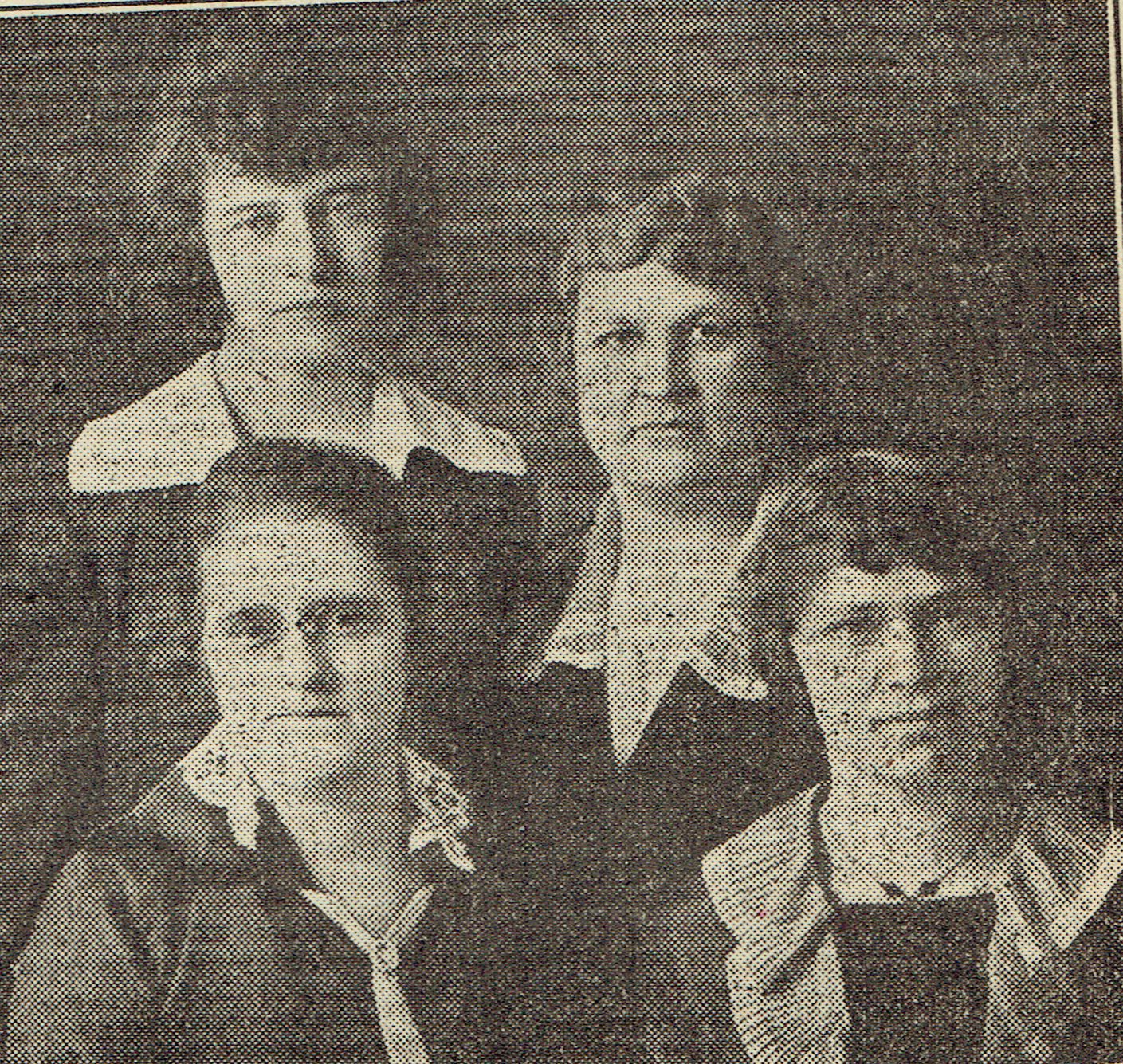 As early as 1919 there were sister missionaries serving in the Canadian Mission. L to R, top row, Lillian Guthrie and Margaret Smith Jensen, Relief Society Mission President; front row, Kate C. Wood and Bessie T. Whitaker, Mission Stenographer. (Liahona)
As early as 1919 there were sister missionaries serving in the Canadian Mission. L to R, top row, Lillian Guthrie and Margaret Smith Jensen, Relief Society Mission President; front row, Kate C. Wood and Bessie T. Whitaker, Mission Stenographer. (Liahona)
In November 1919, Church President Heber J. Grant visited the mission and authorized the purchase of a mission home on 36 Ferndale Avenue in the prestigious Deer Park area, not far from Toronto’s landmark castle, the Casa Loma.[49] In January 1920, young Elder Mark E. Petersen arrived in Toronto as a missionary and was assigned to serve in Nova Scotia.[50] Forty years later, he would return as the General Authority to organize the first stake in Ontario.
The activity and responsibility of the mission president was challenging. There are reports of President Jensen speaking in meetings from Winnipeg to Halifax and from Port Arthur to Ottawa—all cities along rail routes. As soon as there were a few members in an area, a branch would be created. Clusters of branches were formed into conferences (later called districts). In the early years, the missionaries filled conference leadership positions. Ontario had four conferences: Port Arthur, Hamilton, Toronto, and Ottawa.[51] The mission president travelled by train and automobile, and the missionaries mainly walked, hitchhiked, or rode bicycles.
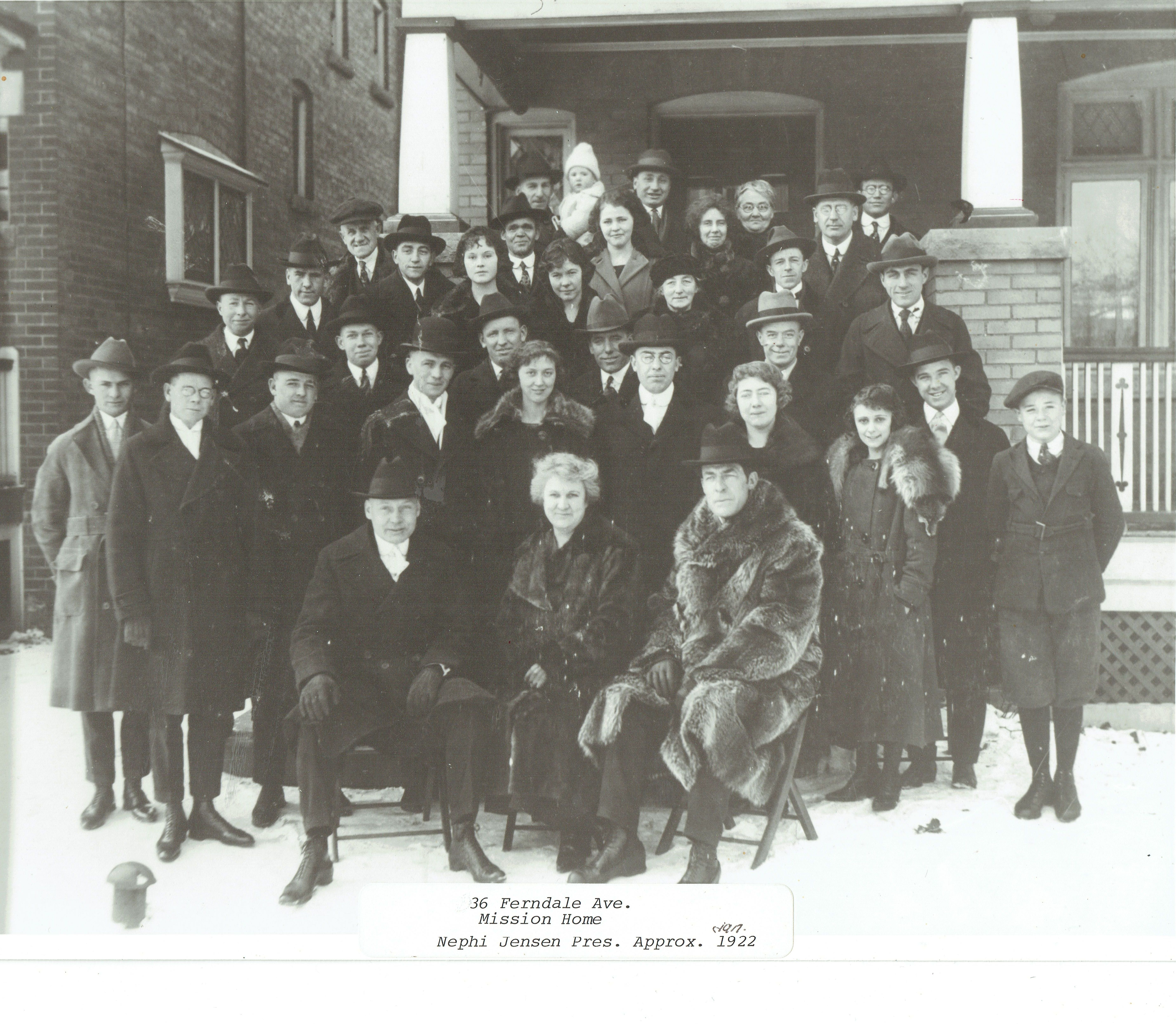 Nephi and Margaret Jensen, with missionaries and members, on the steps of the 36 Ferndale Avenue mission home in the winter of 1922. Left to right, sitting, Joseph D. Millerberg, president of the Toronto Conference; Margaret S. Jensen, Mission Relief Society President; Nephi Jensen, mission president. Front row, standing, Henry T. Williams, mission bookkeeper; H. H. Smith, president of Hamilton Conference; Arling Gardner, mission secretary; Vera Egan, mission stenographer; Joseph S. Thurgood, Irma Christiansen, and Venice Bills. The rest of the thirteen missionaries are scattered throughout the group which is composed partly of the Toronto Branch. (Liahona)
Nephi and Margaret Jensen, with missionaries and members, on the steps of the 36 Ferndale Avenue mission home in the winter of 1922. Left to right, sitting, Joseph D. Millerberg, president of the Toronto Conference; Margaret S. Jensen, Mission Relief Society President; Nephi Jensen, mission president. Front row, standing, Henry T. Williams, mission bookkeeper; H. H. Smith, president of Hamilton Conference; Arling Gardner, mission secretary; Vera Egan, mission stenographer; Joseph S. Thurgood, Irma Christiansen, and Venice Bills. The rest of the thirteen missionaries are scattered throughout the group which is composed partly of the Toronto Branch. (Liahona)
In the first eight months of 1921, President Jensen reported there had been 65 baptisms in the mission—which included the entire area from Manitoba to the Atlantic Ocean, not just Ontario—making a total of 351 members.[52] Alva O. Jones, one of the early members in Hamilton, recorded that the mission president “didn’t have counselors in those days, he was just by himself. Of course, he didn’t have too many missionaries either. I think we knew every missionary in the whole mission.”[53] Effela Rosevear Dyson remembered, “President Jensen had a loud, powerful voice and was in his glory when standing on a street corner preaching of Jesus Christ.”[54]
In 1921, a Sunday School was organized in Oshwegan, home of the Six Nations Reserve near Brantford, Ontario,[56] and meetings were held every night on the reserve later that year.[57] Six Nations member, Charlotte Taylor, wrote that “as missionaries proselyted in the Brantford area, they often found that the native families were more receptive to their message then were other residents, and much is owed to those early native members who supported the missionaries in the 1920s and later, when many false reports were circulated about the Church.”[58]
Some of the false reports referred to were fanned by the sensational anti-Mormon movie, Trapped by the Mormons, filmed in 1922 in England and shown in Toronto movie theatres. R. C. Russell, an Apostle from the Reorganized Church of Jesus Christ of Latter Day Saints (RLDS), held tent meetings in Ottawa to “unmask Mormonism.”[59] President Jensen spent much of his time replying to inaccurate newspaper articles, and participated in a twelve-night debate with J. F. Curtis, another Apostle from the Reorganized Church, which “brought the differences between the two churches into the open.”[60]
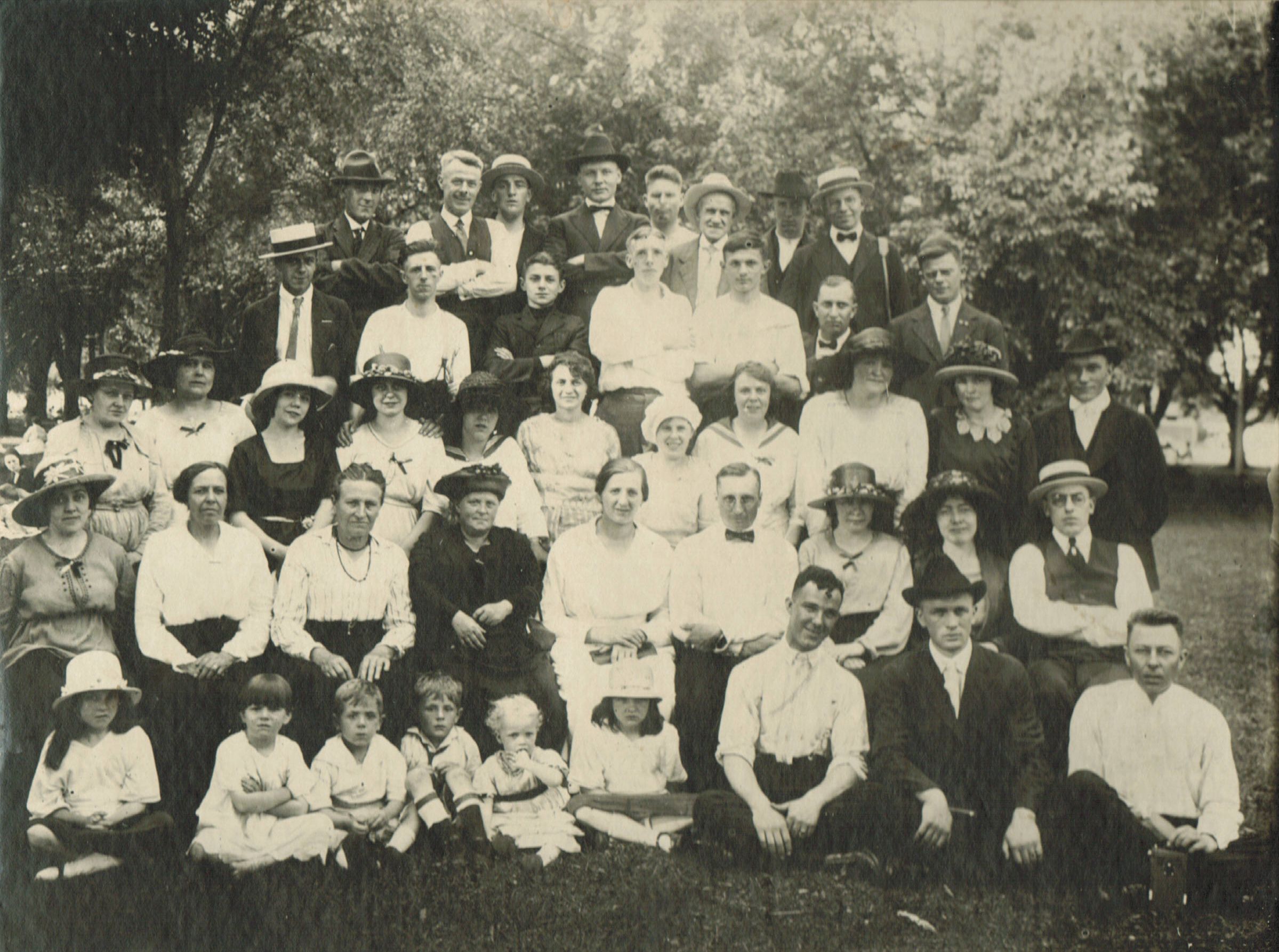 President Nephi Jensen (back row, left) joins members of the Toronto Branch at a picnic on Centre Island[55] about 1920. Next to Jensen are Paul and Peter Goetz, and third row, sixth from the left, is Cecilia Goetz. Front row, third from the right, is George Innis. (Florence Gilbert)
President Nephi Jensen (back row, left) joins members of the Toronto Branch at a picnic on Centre Island[55] about 1920. Next to Jensen are Paul and Peter Goetz, and third row, sixth from the left, is Cecilia Goetz. Front row, third from the right, is George Innis. (Florence Gilbert)
In spite of persecution and heckling, street meetings were held five nights a week in Toronto with crowds gathered to hear the message of the missionaries. Halls and theatres were rented for special meetings where President Jensen addressed the audience. The meetings were lively. At one held in Toronto’s Grand Opera House,[62] President Jensen spoke on faith and then opened the meeting for questions. A man rose and said, “You tell of the great things faith has done. We want the proof.” The audience waited. “Are you sick?” asked President Jensen. “No,” admitted the man. “Well, I never try to heal a person who is not sick,” was the response.[63] At another meeting in Hamilton, a new convert kept shouting “Hallelujah” and “Praise the Lord” during President Jensen’s address. He asked her to stop, but after a few minutes she would shout out again. He told her, “If you do that anymore, that seat’s going to get so uncomfortable for you that you won’t be able to sit in it,” and he continued with his speech. When she started again, people noticed that she “started to squirm, to fidget, and finally she had to get up and leave.” [64]
Alva O. Jones described the preparation of one of the halls the Church rented in Hamilton where the Saints held their meetings after they moved from local homes. “We used to go up as deacons and Aaronic Priesthood and get the benches put around because they were all around the side of the room. . . . We put them in rows. We used to have to pick up the spittoons, put them in the back room, get them out of sight [and] open the windows to get the cigar smoke out. Way back in those days they didn’t have electric organs like they have now. They had these big organs, and they had a wooden handle sticking out the end . . . like a pump handle. It was the Aaronic Priesthood’s job to pump these handles to supply wind for the organ. We used to have eccentric organists. Brother Wells, if you didn’t pump fast enough …would say, ‘faster, faster’ and you were glad when it was over. You hoped they didn’t have long hymns.”[65]
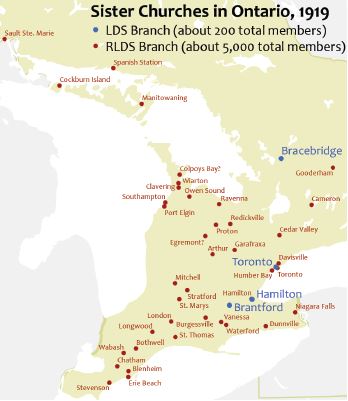
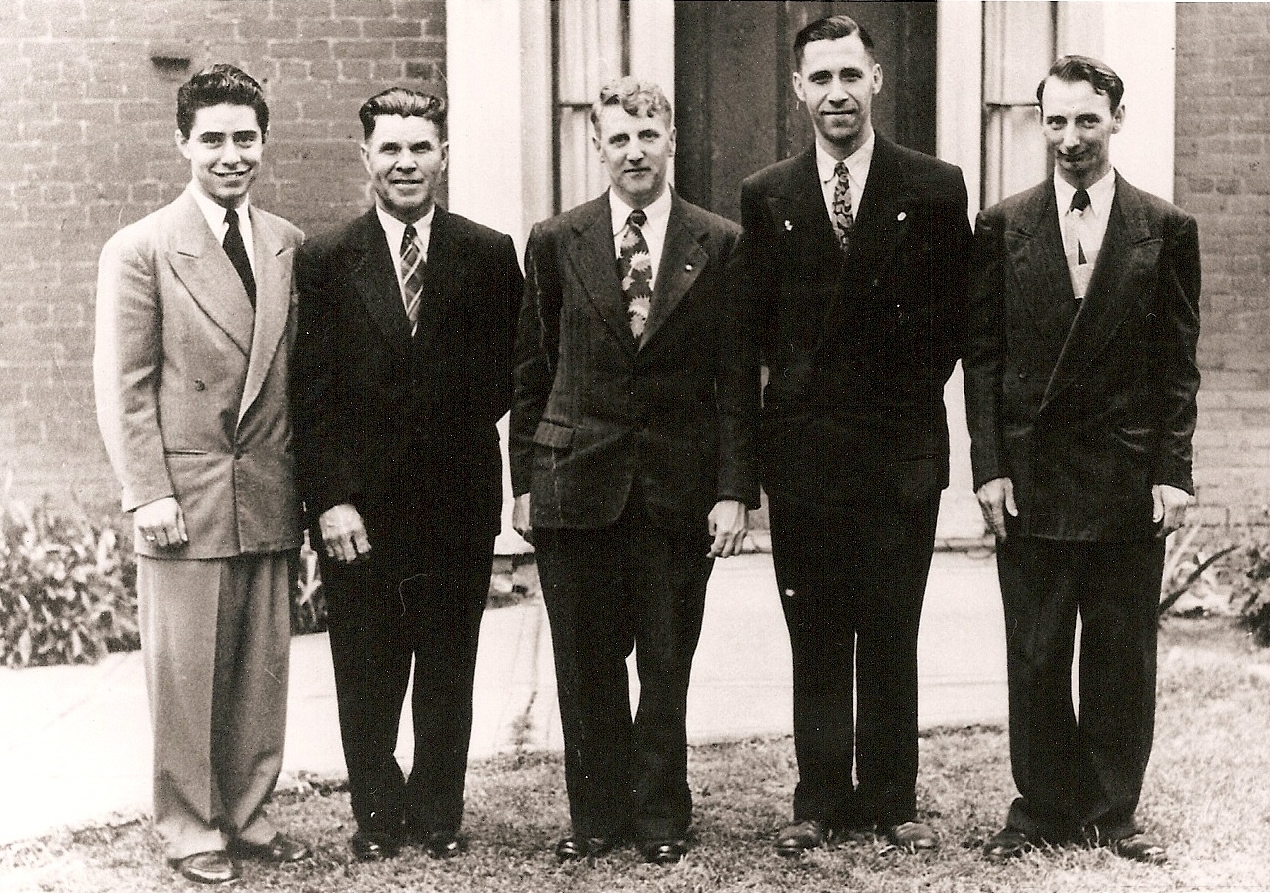 Pumping faster and faster on the organ pump handle must have been good training for Alva O. Jones, because he was called as branch president in Hamilton in 1942. L to R, Louis Benn, William Ayers, Alva O. Jones, Victor E. F. Brown, Everett Jones (Alva’s Brother). (William Goddard)
Pumping faster and faster on the organ pump handle must have been good training for Alva O. Jones, because he was called as branch president in Hamilton in 1942. L to R, Louis Benn, William Ayers, Alva O. Jones, Victor E. F. Brown, Everett Jones (Alva’s Brother). (William Goddard)
William Ayers, another early member from Hamilton and a counselor in the 1936 branch presidency, added that they also had to remove empty beer bottles, and that “during Sacrament service and while speakers were giving their discourses, a long freight train would proceed up Ferguson Avenue, the noise being so loud it was impossible to hear the speakers.”[66]
Arnold Goodchild Sr. related how he and other Aaronic Priesthood holders carried Melvin Ball in his wheelchair up the stairs to the second floor meeting room in the IOOF Hall on James Street in St. Catharines. “Two of us would take the bottom of the chair and two of us would take the top,”[67] which must have called for a significant act of faith by Brother Ball.
Branches would have grown faster if converts looking for a more compatible home for their new religion had not been prompted to move to Utah. It was not unusual for whole families to move west or for a young woman to move west to marry a missionary whom she had met in her branch. To address the situation, an editorial in the Millennial Star in 1921 urged, “The Counsel of the General Authorities to the yet ungathered saints, is not to flock Zionward under existing conditions; but to remain in the countries where they now dwell. . . . Such as have homes and employment, especially, should stay and help build up the Lord’s work in the various missions and conferences and branches, strengthening the hands of the elders and other missionaries labouring among them.”[68]
In October 1924, President Joseph Quinney Jr., who succeeded President Jensen, learned that there were members of the Church in Bergland, a small community in northwestern Ontario near the Manitoba border. He contacted the missionary in that area who was President Alvin D. Wilson of the Port Arthur Conference, and asked him to visit the area with his companion. The two elders took the train to Sleeman, the closest railroad town, and walked the twenty-seven kilometers (seventeen miles) to Bergland where they found the Olsons and their family who had joined the Church in northern Sweden and immigrated to Ontario in 1910. Since their arrival they had no contact with the Church. Meetings were arranged in the local schoolhouse and in the Baptist Church. Seventy people attended, and the elders were told the school had never held so many people at one time. They discovered that there were eleven members who had remained faithful to the gospel, and they baptized their children. A farewell picnic was held for the elders on an island in nearby Lake of the Woods, and the Saints were reluctant to see them leave. The elders recorded that “it was with many tears that we bid our beloved brethren and sisters and friends good-bye. They would not let us leave until we promised that we would do all in our power to come again or see that other elders do.”[69] The next year, the First Presidency sent $250 for “flooring, doors, windows, nails, bricks, and cement” to build a chapel, and the Saints provided the logs and labour. It was dedicated in November 1925, and Peter John Olson was sustained as the branch president.[70] It was the first dedicated chapel in the Port Arthur Conference and the first chapel built and dedicated in Ontario.
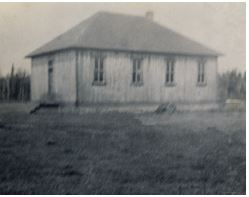 The first Latter-day Saint meetinghouse built in Ontario was in Bergland, near the Manitoba border. To help with costs, members received $250 from the First Presidency of the Church and used vertical logs in its construction. (Arlene Berry)
The first Latter-day Saint meetinghouse built in Ontario was in Bergland, near the Manitoba border. To help with costs, members received $250 from the First Presidency of the Church and used vertical logs in its construction. (Arlene Berry)
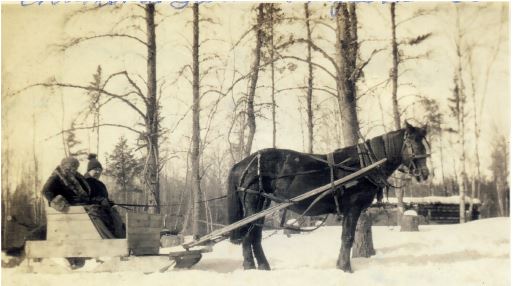 Christina Broman and Signe Helverson on their visiting teaching route in Bergland, Ontario, in the 1920s. (Arlene Berry)
Christina Broman and Signe Helverson on their visiting teaching route in Bergland, Ontario, in the 1920s. (Arlene Berry)
The mission boundaries were changed in 1925 when Manitoba and the northwestern part of Ontario were included in the new North Central States Mission, and first Maine and then Vermont and New Hampshire Districts were added to the Canadian Mission.[71] Once the Bergland Branch and the Port Arthur Conference—which included both Fort William and Port Arthur—became part of the North Central States Mission, the members of the Church in the rest of Ontario lost touch with their fellow citizens, and many histories omit them altogether. Under the North Central States Mission, the conference continued growing, and stalwart members from this area moved to other parts of Ontario and became leaders. Three stake presidents who at one time lived in these two branches would later serve in other parts of Ontario: J. Bruce Smith in Toronto, Edward J. Smith in Ottawa, and Steven Diaczin in Mississauga. In 1970, Fort William and Port Arthur were amalgamated and are now called Thunder Bay.
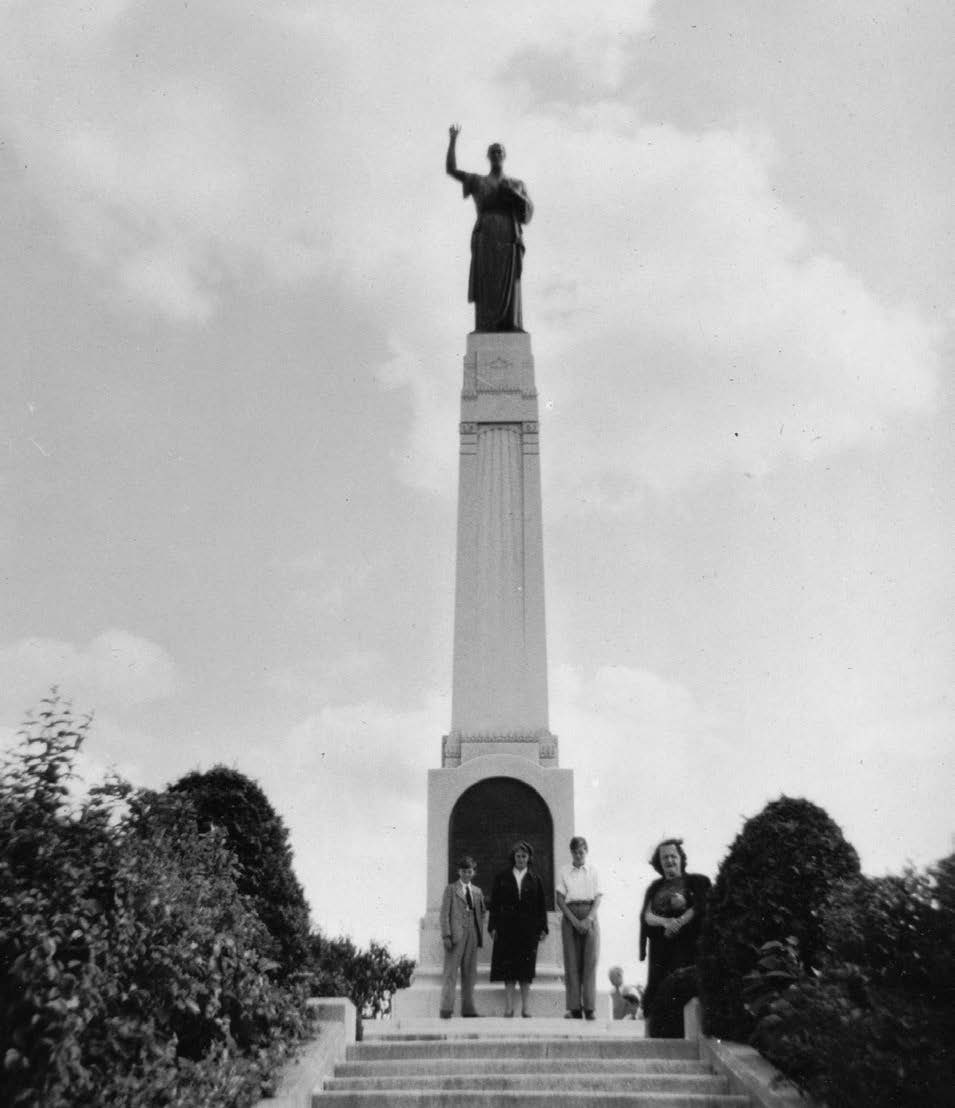 While members from
While members from
Ontario attended the Palmyra
pageant, they visited the
Church historic sites in the
area. Climbing to the top of
the Hill Cumorah to see the
angel Moroni statue, touring
the visitors' centre, the Joseph
Smith home and walking
through the Sacred Grove
were inspirational highlights.
Sometimes they were fortunate
to meet General Authorities.
When pageant casting
by Brigham Young University
students was discontinued,
members of the Church from
Ontario were able to apply
and were accepted as cast
members. (H. Cecil Warner)
In the early days of the Canadian Mission, meetings were conducted by the missionaries and they were often called as branch and district presidents. Candidates for baptism were taken to the nearest lake or river, or, in areas close to district headquarters, the missionaries gathered their converts for joint baptismal services in YMCA swimming pools or municipal baths. Those near Toronto brought their converts to the city where there would be large joint baptismal services. One baptismal service held in the Toronto District included eighteen converts and two children of record.[73] Some marriages took place at the mission home. Adolf and Margaret Zuber and William and Johan Mark were the first couples married there on 24 March 1928 by President Charles H. Hart.[74]
In 1929, Canadian farmers on the prairies were hard hit by the Great Depression, but in Ontario, mines had opened in the north which helped the sagging economy. Missionaries found converts in the nickel-mining town of Sudbury and in Timmins with its gold mines. One set of missionaries reported that they had hitchhiked 2,250 kilometers (1,400 miles) in three weeks to visit isolated members in northern Ontario.[75] Another companionship travelled close to 640 km (400 mi) on their bicycles and spent some of their nights sleeping under the stars.[76] In 1929, Music and the Spoken Word with the Mormon Tabernacle Choir was broadcast for the first time in the United States, and soon was heard by members of the Church in Canada.
When President John V. Bluth was called to preside over the mission in 1931, the geographical immensity of the area must have preyed on his mind. In general conference, he said: “If one should take the lands within the Canadian Mission and divide them up between the men, women and children that comprise the membership of the Latter-day Saint Church in the Canadian Mission, each one would be entitled to 700,000 acres. From that you can decide whether the mission is extensive or whether the membership is small. As I find it, both are the case.”[77]
Landmark Events during the Great Depression
Baptisms were few during the Depression years of the 1930s since the number of missionaries available to serve was greatly reduced.[80] During the first four months in 1934, the entire Canadian mission baptized only ten people. But members rejoiced that same year when James H. Wallis, the first travelling patriarch for the Church, visited the mission and gave four hundred patriarchal blessings between 28 July and 23 October 1934.[81]
When the New England Mission was created in 1935, Maine, Vermont, and New Hampshire were transferred from the Canadian Mission to the new mission. Abel S. Rich, president of the Canadian Mission, described conditions in Ontario at the April 1936 general conference. “There are no amusements open on Sunday, no athletic games, and the people seem not to feel that they are deprived of any of their rights, but they are happy in the observance of the Sabbath day.”[82]
The Palmyra Pageant was a big draw for members in Ontario when it premiered in 1937. For years, local branches chartered buses, and members travelled to see the pageant and visit the Church historic sites, walk through the Sacred Grove, and tour the Joseph Smith farm. A highlight was listening to the Sunday morning testimony meeting in the Sacred Grove with the cast members.[83]
Attitudes about the Church were changing. What would have been impossible in 1919, when the mission was created, occurred in 1937 when four young elders calling themselves the Utah Ambassadors performed before business and service groups and on radio, spreading the gospel through music. The Kiwanis Club in Ottawa invited them to sing at the Chateau Laurier Hotel when Elder Joseph F. Merrill of the Council of the Twelve addressed the group, and the program was broadcast on radio.[84]
Also in 1937, the Church Welfare Plan was announced, and members were counselled to become self-sufficient by storing a year’s supply of food. Hamilton Branch President Alva O. Jones described his branch’s response to the counsel. “We had some good times in the old days. I remember we decided we’d have sort of a welfare program, so we got to rent some property down east of the city. . . . It was very good soil. . . and we had an acre and a half that we had the use of. . . . We used to take our bikes and our shovels and go down there. We dug up half an acre. Then somebody come along and said they knew where they could get a man with a tractor to dig up the other acre. We planted several kinds of vegetables and we had a real good success with it. Then we took and we canned them. I worked at the American Can [Company] and was able to get cans fairly cheap. We canned about a thousand cans of the vegetables that we grew and divided them up among the members. That was our first attempt and that was back in the ‘30s. So it was a help in those times, the depression was just getting over.”[85]
A Chapel in Toronto
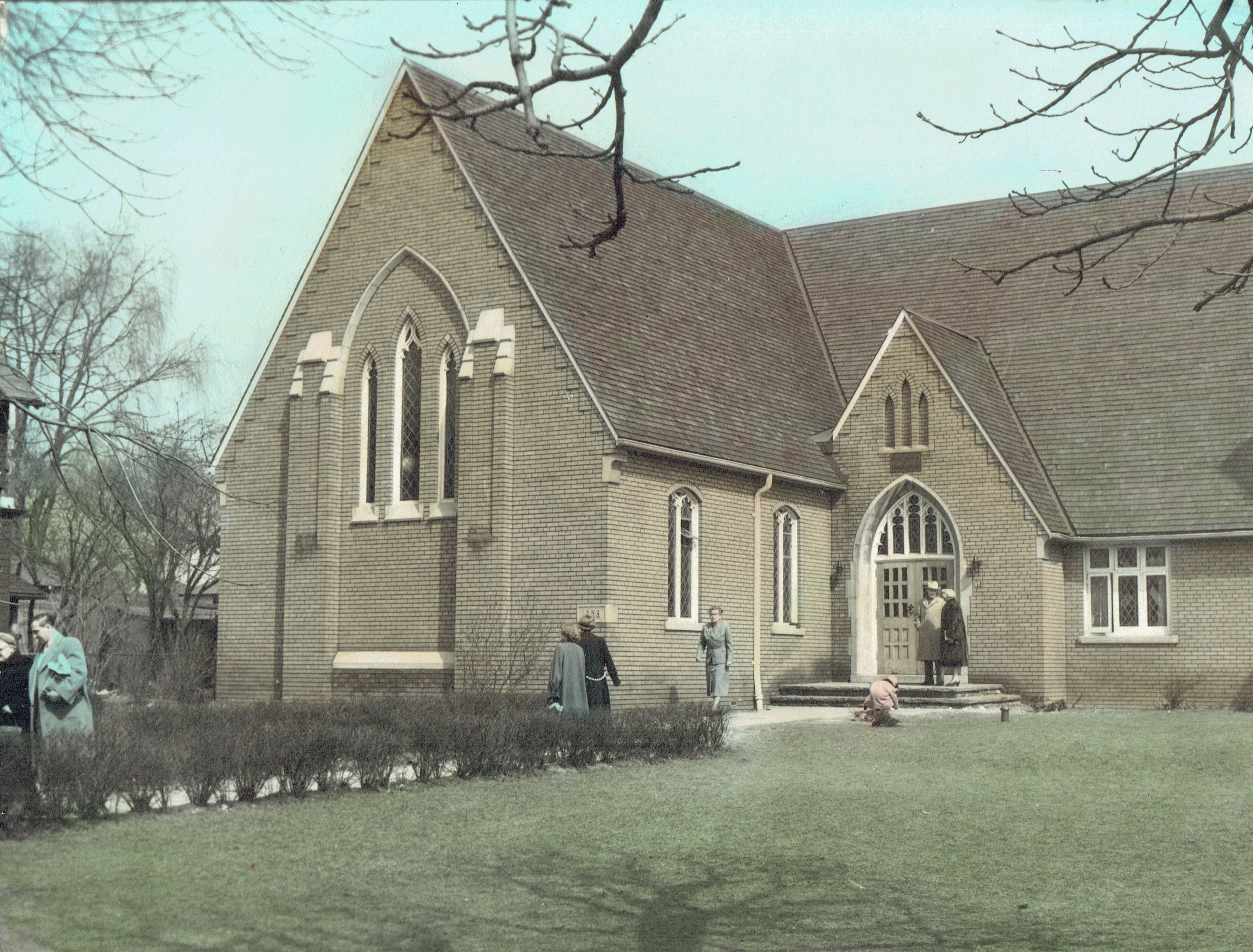 The Ossington Chapel. The 88’ x 297’ property was purchased in December of 1937, and Wilbur Webb was selected as the architect, working under the direction of the Presiding Bishopric of the Church. The building contractors were the Demelio Brothers. (Everett Pallin)
The Ossington Chapel. The 88’ x 297’ property was purchased in December of 1937, and Wilbur Webb was selected as the architect, working under the direction of the Presiding Bishopric of the Church. The building contractors were the Demelio Brothers. (Everett Pallin)
The 25 June 1938 issue of the Deseret News announced a thrilling prospect for members in Ontario. After years of meeting in rented halls, President Abel S. Rich wrote that a Latter-day Saint chapel was to be built on Ossington Avenue, north of Bloor Street in Toronto. President Rich reported that a large group of Saints and their friends along with the architect and the builders had already gathered at the property on the evening of 31 May of that year for the sod turning. Branch president Adolf Zuber spoke, and William M. Davies, who would later become the first president of the Toronto Ontario Stake, gave the opening prayer.[86] A cornerstone was laid which enclosed a copper box containing a history of the branch, photographs, and daily newspapers. Each person there used a silver trowel and placed some mortar to seal the copper box in the cornerstone. Once that was completed, work on the building progressed rapidly. By 28 October, the first meeting was held in the chapel with 213 members in attendance, and in December three sessions of district conference were held in the new building.[87]
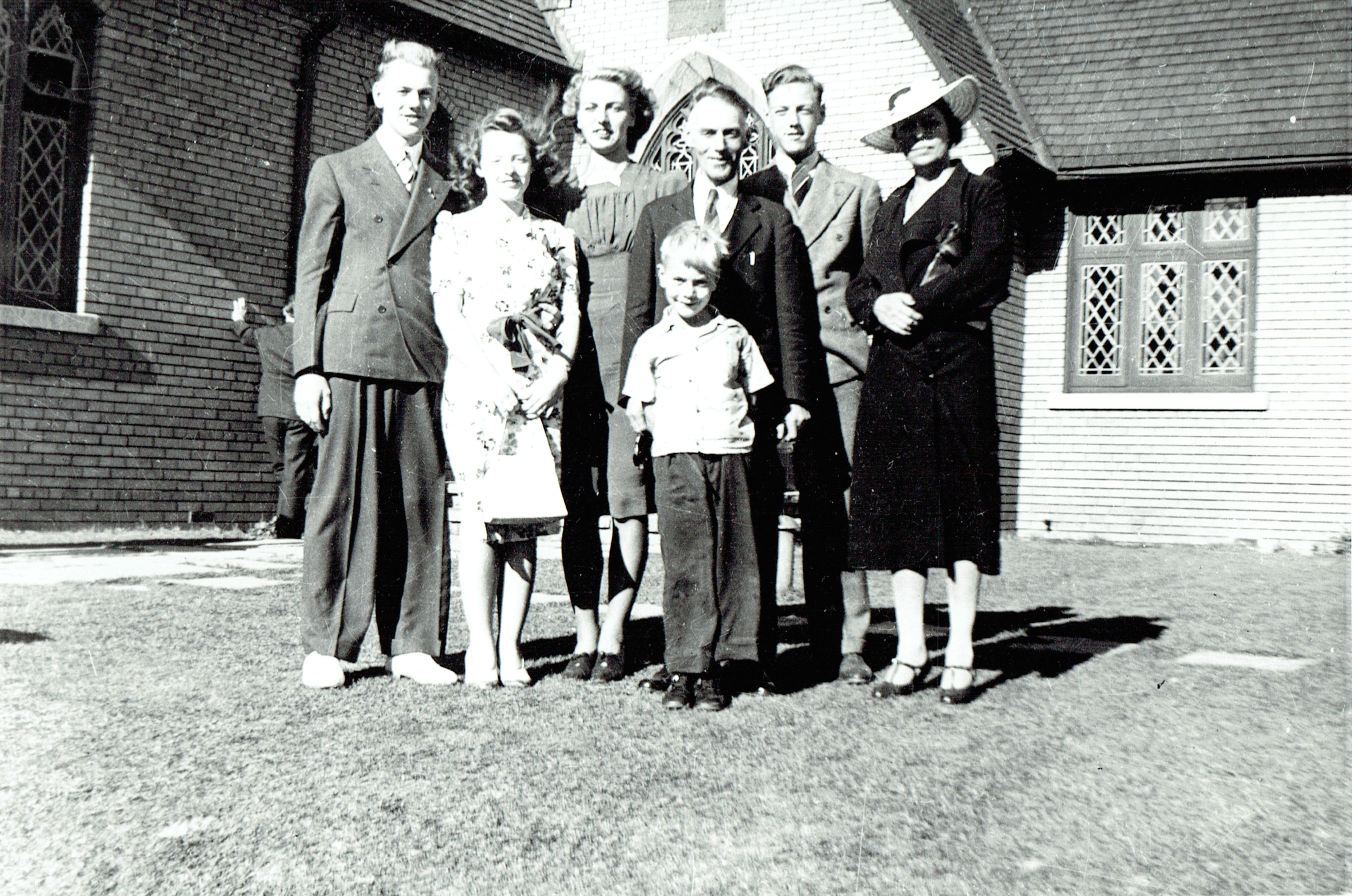 Gathering outside the Ossington Chapel were, Left to right, Charles and Helen Speek, June, Thomas, Kelvin, Lorne, and Mahala May Peters Waywell (in the fashionable hat). Mahala Waywell had a connection with early Church history in Ontario. Her great-great-aunt was Susannah Peters, the second wife of Artemus Millet. The Millets were baptized in Ernestown, Ontario, in 1832, and went to Kirtland, Ohio, where Artemus supervised the building of the Kirtland Temple. (Brenda Bergmann)
Gathering outside the Ossington Chapel were, Left to right, Charles and Helen Speek, June, Thomas, Kelvin, Lorne, and Mahala May Peters Waywell (in the fashionable hat). Mahala Waywell had a connection with early Church history in Ontario. Her great-great-aunt was Susannah Peters, the second wife of Artemus Millet. The Millets were baptized in Ernestown, Ontario, in 1832, and went to Kirtland, Ohio, where Artemus supervised the building of the Kirtland Temple. (Brenda Bergmann)
In June of 1939, David A. Smith was the mission president who greeted President Heber J. Grant for the dedication of the new chapel. There were two sessions held, and the dedicatory prayer for the building was heard in the afternoon session by approximately five hundred members, missionaries and friends.
The chapel was a handsome brick building, and had a “recreational hall, kitchen, Relief Society Room and five classrooms.”[88] The baptismal font was on the stage under a door in the floor, and Mahala Waywell, who later produced important Church historical and genealogical records, was the first adult baptized in the building.[89]
The first missionary from the Toronto Branch was Alexander Rosevear, who was called to serve in California in 1939. He was the son of branch stalwarts James and Bertha Rosevear.[90]
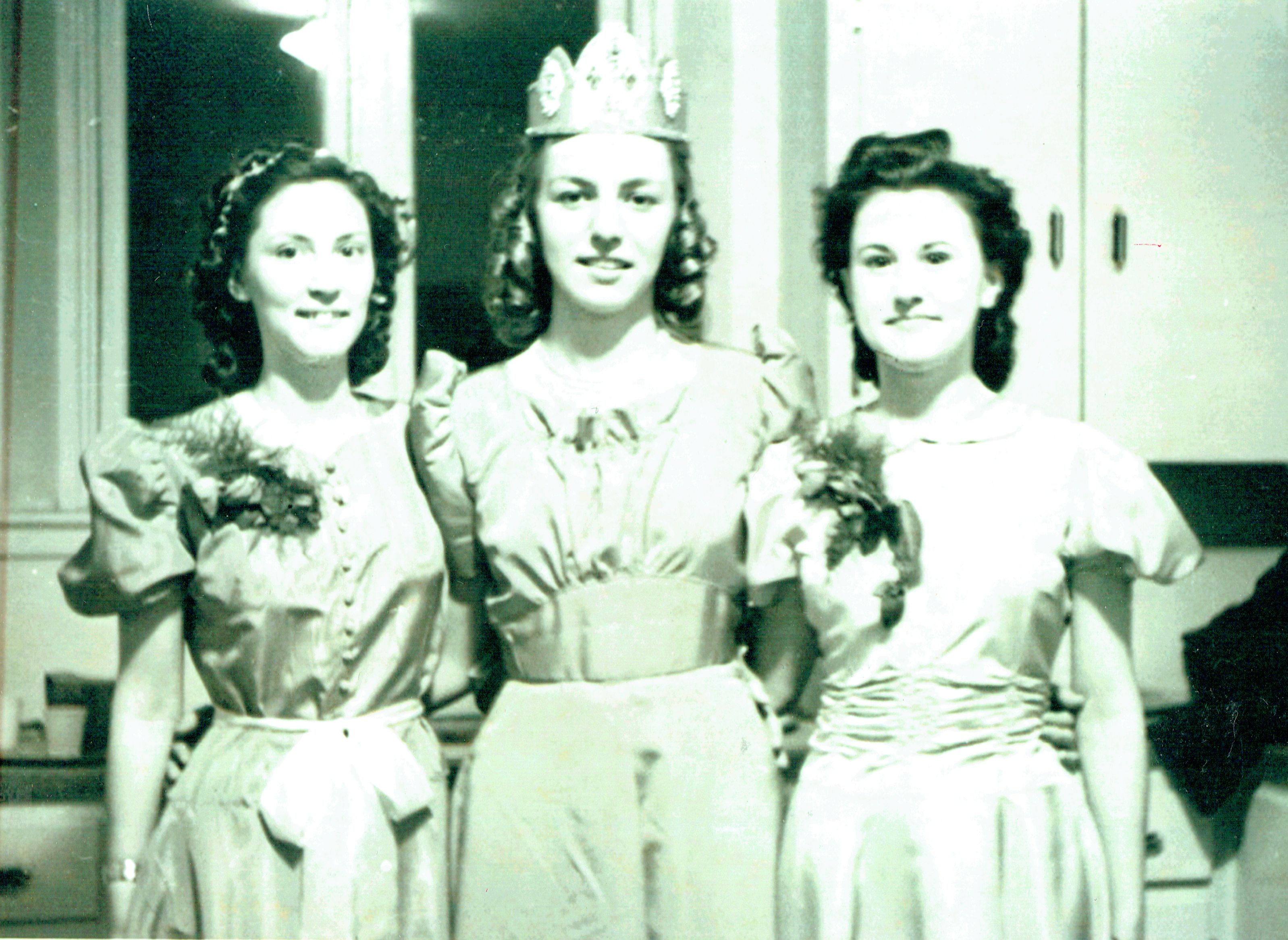 At Toronto’s annual gold and green ball in 1939, David A. Smith, who served as president of the Canadian Mission from 1938 to 1943, awarded June Waywell, Queen of the Ball, a one-year scholarship to Brigham Young University. Her attendants were Jean and Margaret Wallace (Brenda Bergmann)
At Toronto’s annual gold and green ball in 1939, David A. Smith, who served as president of the Canadian Mission from 1938 to 1943, awarded June Waywell, Queen of the Ball, a one-year scholarship to Brigham Young University. Her attendants were Jean and Margaret Wallace (Brenda Bergmann)
World War II
With the outbreak of World War II in 1939, 660 missionaries were evacuated from Europe and thirty of these were reassigned to the Canadian Mission. Those from France were assigned to Quebec, elders from the German and Austrian missions went to Kitchener, which had a large German-speaking population, and elders from the Netherlands went to London.[91]
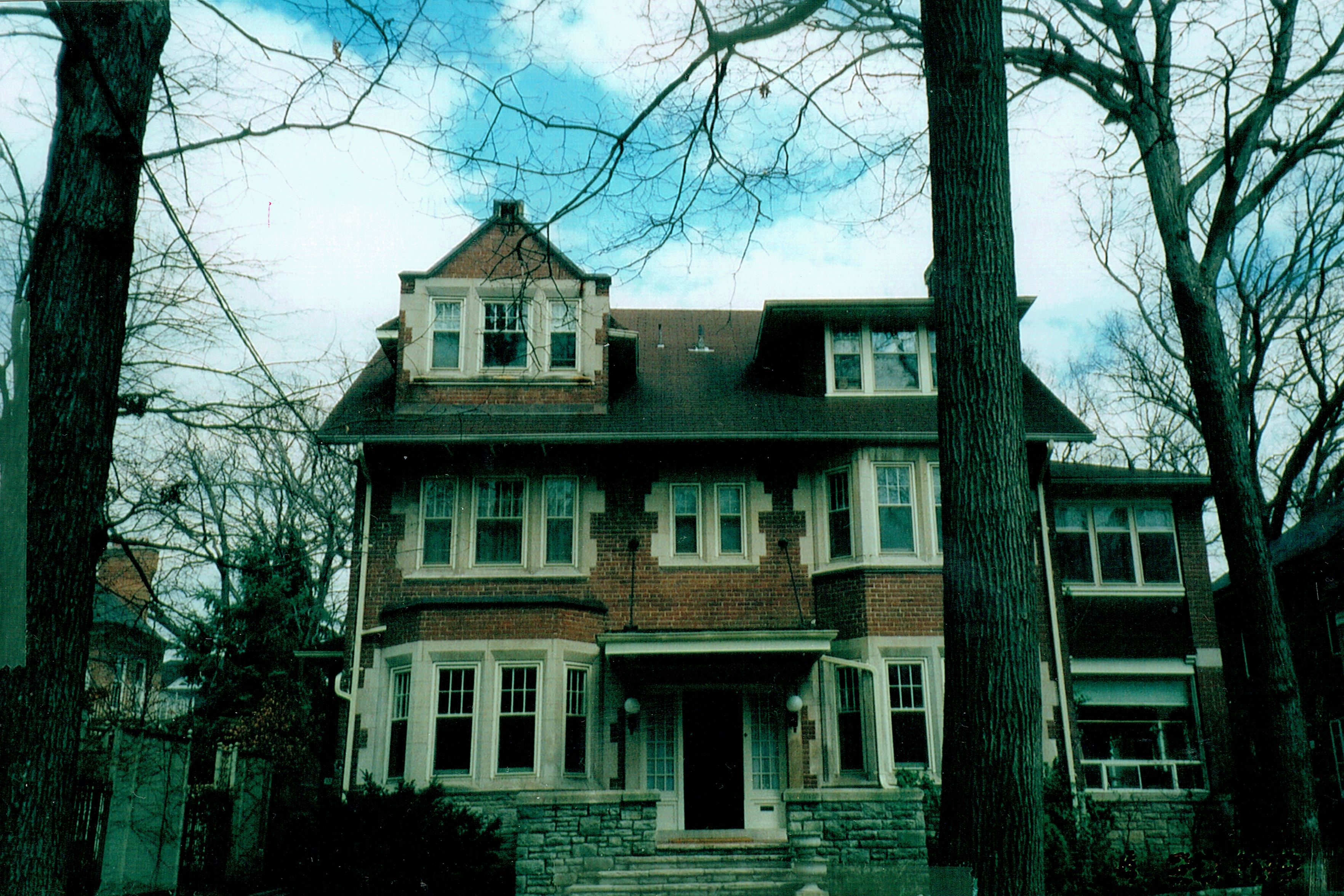 In 1942, a stately mansion was purchased at 133 Lyndhurst Avenue as a home for the mission president and his family, along with some missionaries and often a cook. It was even closer to the prestigious Casa Loma castle. (Everett Pallin)
In 1942, a stately mansion was purchased at 133 Lyndhurst Avenue as a home for the mission president and his family, along with some missionaries and often a cook. It was even closer to the prestigious Casa Loma castle. (Everett Pallin)
The members from the Latter-day Saint settlements in Alberta were a great blessing for the Ontario branches because they brought their experience and vision to leadership positions and trained new converts in Church organization and procedures. Names like Janet Boucher, Marie Templeman, Sloan Alma and Alberta Smith, Phyllis and Alma Baker, Lynn and Byng Beazer and Byron and Irene Palmer in Toronto, and Elden C. Olsen in Kitchener were only a few of the many who set a standard of excellence and who prepared the Saints for stakes in Ontario. Among the many Alberta Latter-day Saints in the Ottawa Branch were Alexander Morrison, who became an Assistant Deputy Minister of Health and Welfare, and his wife, Shirley, and Solon Low, who was the Member of Parliament for Peace River, Alberta, and the leader of the Social Credit Party of Canada.
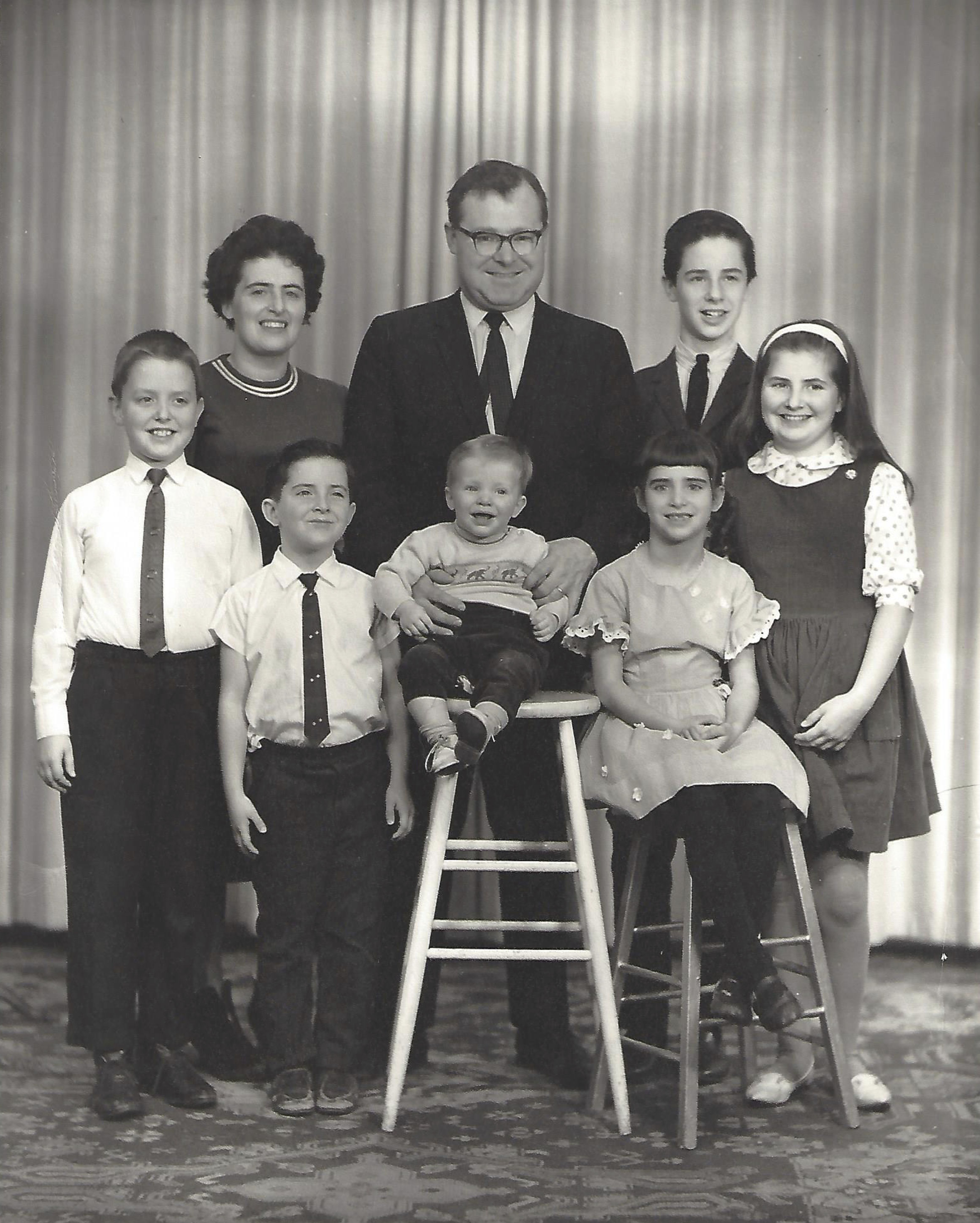 The Alexander and Shirley Morrison family, seen here with six of their eight children, joined the Church in Edmonton in the early 1950s, and later moved to Ottawa where he became an Assistant Deputy Minister of Health and Welfare for Canada. (Mary Morrison)
The Alexander and Shirley Morrison family, seen here with six of their eight children, joined the Church in Edmonton in the early 1950s, and later moved to Ottawa where he became an Assistant Deputy Minister of Health and Welfare for Canada. (Mary Morrison)
World War II brought many challenges. Thousands of young Canadian men and women were serving overseas from 1939 on, and missionaries were asked why they were not helping the war effort. When the United States entered the war in 1941 and for some years after, the number of American missionaries was reduced because of the Selective Service System which required men to register so that they could be “drafted” to fill vacancies in the United States Armed Forces that could not be filled through voluntary means. In response to the need for missionaries in Ontario, members in the mission were called to serve district missions.
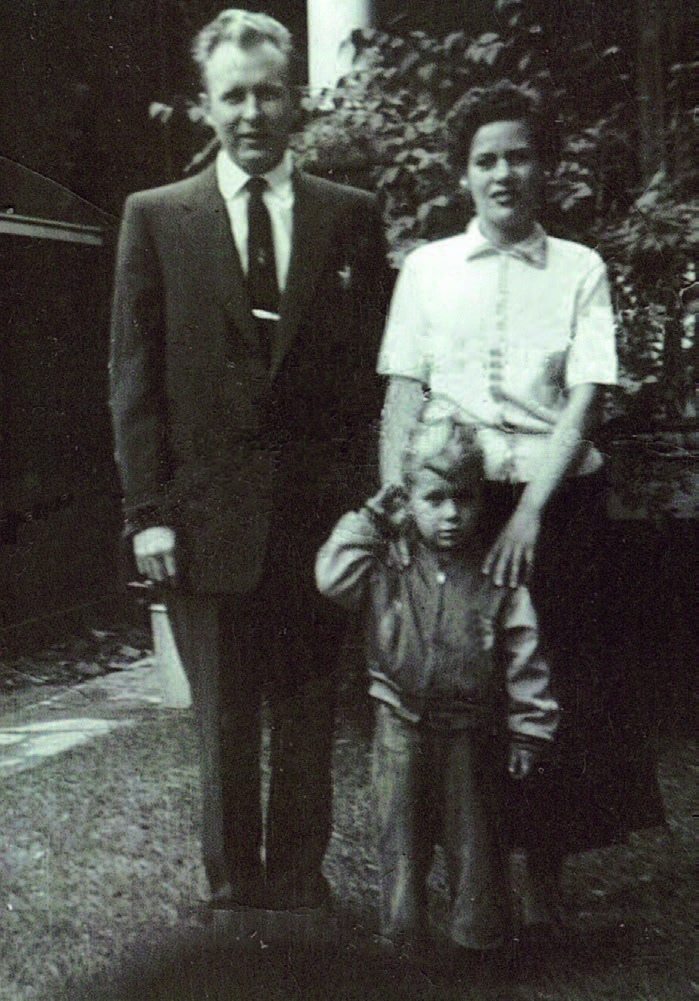 During the mid-1950s Allen Howell of Toronto was called to leave his wife and young son, Terry, and serve as a missionary in Barrie and then as branch president in Bracebridge. Years later, Allen and his wife retired to Bracebridge, and he was called as branch president again. (Jean Howell)
During the mid-1950s Allen Howell of Toronto was called to leave his wife and young son, Terry, and serve as a missionary in Barrie and then as branch president in Bracebridge. Years later, Allen and his wife retired to Bracebridge, and he was called as branch president again. (Jean Howell)
Joseph Quinney Jr. had just completed serving as the president of the Logan Utah Temple in 1943 when he was called to serve as president of the Canadian Mission for the second time. He and Sister Quinney arrived on 20 May 1943, and on 13 September, members were shocked when they heard that he had died of a heart attack on the platform at Montreal’s Windsor Station. President and Sister David A. Smith were recalled to the mission they had just left to temporarily fill the vacancy, and on 31 December, President Octave W. Ursenbach and his wife, Jessie, arrived to take their place. That year there were three mission presidents in the mission.[92]
The wives of the mission presidents served vital roles. They presided over the Relief Societies in the mission, travelled with their husbands, cared for the missionaries, and looked after their own families. Jessie R. Ursenbach, wife of Octave Ursenbach, both from southern Alberta, wrote a letter to all Relief Society members in the mission in September 1945, urging them to start a scrapbook, promising that she would send pages from time to time “that you will treasure.” In one of her letters, she told them that the Canadian Mission Relief Society sent “many bundles of clothing to needy Saints in Britain and Europe,” and “that every needy L.D.S. mother giving birth to a baby during the Battle of Britain, and her baby, were outfitted from the bundles from the Canadian Mission.”[93]
The dedication of a monument commemorating the building of the Nauvoo Road was held by the Gardner family, members of the Church in Ontario, and the Utah Pioneer Trails and Landmarks Association in Alvinston, Lambton County, Ontario, on 16 August 1946. The monument incorporated one of the original stones from the gristmill of Archibald Gardner, who had joined the Church in 1845 and who led a group of converts to Nauvoo in 1846, clearing a six-mile road through the forest.[94]
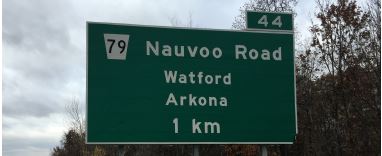 The current road sign on Highway 402 between London and Sarnia indicates the location of the Nauvoo Road. The Nauvoo Road monument reads, in part, “Converts to the Church of Jesus Christ of Latter-day Saints en route from Gardner’s Mills to Nauvoo, Ill., chopped a road through the forest to reach the London Road. Among them was Archibald Gardner the first settler of Alvinston who built the first gristmill in Brooke Township.” The millstone is from Gardner’s mill[95] (David and Anne Olsen)
The current road sign on Highway 402 between London and Sarnia indicates the location of the Nauvoo Road. The Nauvoo Road monument reads, in part, “Converts to the Church of Jesus Christ of Latter-day Saints en route from Gardner’s Mills to Nauvoo, Ill., chopped a road through the forest to reach the London Road. Among them was Archibald Gardner the first settler of Alvinston who built the first gristmill in Brooke Township.” The millstone is from Gardner’s mill[95] (David and Anne Olsen)
Immigration in Ontario
The end of the war brought changes to Ontario. Its British complexion became only part of a mosaic that added peoples from around the world. The booming economy and the need for workers as well as the displacement of people from countries now behind the Iron Curtain brought thousands of immigrants to Canada and many of them came to the Toronto area, making Toronto one of the most culturally diverse cities in the world. By 2006, half of the people in Toronto were foreign born.[96] The 2011 National Household Survey (NHS) indicated that 49.1 percent of Toronto's population was composed of visible minorities. The City of Toronto website reports that 160 languages and dialects are spoken in the city with the most common non-English languages spoken being the Chinese languages, Tamil, Spanish, Tagalog, and Italian.[97]
The same survey reported that in the entire province, after English (8,674,200 people) and French (473,315), the eight languages most commonly spoken were Italian (248,475), Cantonese (189,160), Chinese (187,160), Punjabi (174,875), Spanish (173,935), Tagalog (161,360), Portuguese (146,975), and German (135,915).[98] Spanish and Chinese branches were created, beginning with the first Spanish branch in 1977, to welcome members and converts who spoke these languages, and missionaries held English-as-a-second-language lessons in the chapels.
A good view of what missionary work was like after World War II comes from talks of Elder Neal A. Maxwell, a member of the Quorum of the Twelve. After serving in Okinawa during the war, he arrived in the Canadian Mission on 1 February 1947, as a full-time missionary. He and his companion were called to the branch presidency in Orillia. They found that, due to the lack of leadership during the war years, only a few members had remained active. Some members had strayed so far from Church teachings that action had to be taken to terminate their membership. Later when he was an apostle Elder Maxwell tried to encourage missionaries struggling with their own lack of baptisms by telling them that he baptized two people on his mission and excommunicated four—a net loss of two! He wrote that the hardship of knocking on doors for hours with no response was good for him, for “if one has an unbroken string of successes, he misses the chance to learn from . . . disappointment.”[99]
He recounted that his mission president, President Floyd G. Eyre, once spoke at a street meeting in Orillia when a rough-looking man shouted out, “You’re a liar!” President Eyre calmly replied, “And you, sir, are a gentleman. However, I think we are both wrong.”[100]
There was no missionary lesson plan, and President Eyre asked Elder Maxwell to write one. The result was a thirteen-lesson “systematic and effective technique to build testimony and desire for leadership” called “The Sword of Truth.”[101] After nine months, Elder Maxwell was called as district president in Toronto with responsibility for 540 members, and was later transferred to Montreal.
The border between the Church in Canada and the United States remained fluid for some time, and even in the 1960s, Windsor, Ontario, was part of the Detroit Stake; the Kincheloe Branch in Michigan was part of the Northland District in Ontario; and the Mohawk Branch in New York State was part of the Ottawa-Montreal District. In March, 1961, three “outstanding missionaries were selected” to travel to Portland, Oregon, to receive information on a successful proselyting program that had been conceived in the Northwestern States Mission, which later became the standard missionary plan.[103] In 1962, missionaries from the Canadian Mission travelled in their American Motors Ramblers to an all-mission conference in Lansing, Michigan, and heard direction from President Henry D. Moyle of the First Presidency and Elder Gordon B. Hinckley of the Twelve.[104] American Motors President, George Romney, who was also president of the Detroit Stake, was a source of pride for members of the Church on both sides of the border.
The activities of two other apostles strengthened members and further raised the profile of the Church in Ontario during the 1950s and 1960s. Elder Richard L. Evans and The Spoken Word with his sign-off blessing, “May peace be with you . . . this day . . . and always,” was heard in homes throughout Ontario on the Sunday morning Mormon Tabernacle Choir radio broadcast from “the Crossroads of the West” in Salt Lake City. His stature increased when he became the president of Rotary International in 1963. The appointment of Elder Ezra Taft Benson as Secretary of Agriculture in the cabinet of President Dwight D. Eisenhower in 1953 brought the Church added respect and prominence. The Benson family held a family home evening on Edward R. Murrow’s Person to Person weekly television program and presented the faith and values of Latter-day Saints to millions of viewers. They talked about missionary work, prayer, chores, and family fun and sang “Love at Home.” United Press International reported that the program “brought in more fan mail than any other in history.”[105]
The chapel in Toronto became the centre of Church activities in the Canadian Mission, and members travelled great distances to attend mission and district conferences. In Kingston, members would rent a car and six or eight would pile into it for meetings in Toronto or Ottawa.[106]
The mission had incredibly hard-working and inspired mission presidents and their wives from the time the mission was reopened in 1919. Each one was prepared for their assignment with experiences and talents that moved the Church forward and blessed both members and missionaries. Books could be written about their service and every one of them was loved and cherished by the missionaries and Saints. Each played a vital role in bringing the first stake to Ontario.
On 1 January 1955, at a mission conference in Toronto, President J. Melvin Toone told his 89 missionaries, “I am sure all of us greatly rejoice in the opportunity that we have of being missionaries. Isn’t it the most glorious thing that ever came into your life? To be ambassadors of the Lord, to bring salvation to ourselves and to our Father’s children, there is nothing equal to the joy and happiness and contentment that will come into our lives anywhere in the world.”[107] One of those missionaries hearing President Toone’s address was Merrill T. Maxfield, a descendant of President John Taylor, third President of the Church, who was baptized in Toronto in the 1830s.
President Toone called Irving Wilson, a new convert, as the branch president in St. Thomas, just after Wilson was ordained a priest and before there was even a branch. “You are to go forth as a missionary,” said President Toone as he set Wilson apart as a full-time missionary. Wilson was indeed an extraordinary missionary, and in his calling as branch president, soon baptized two counselors. He brought many converts into the branch, organized the building of a beautiful chapel, and became a counselor to several mission presidents.[108]
Preparing for Stakehood
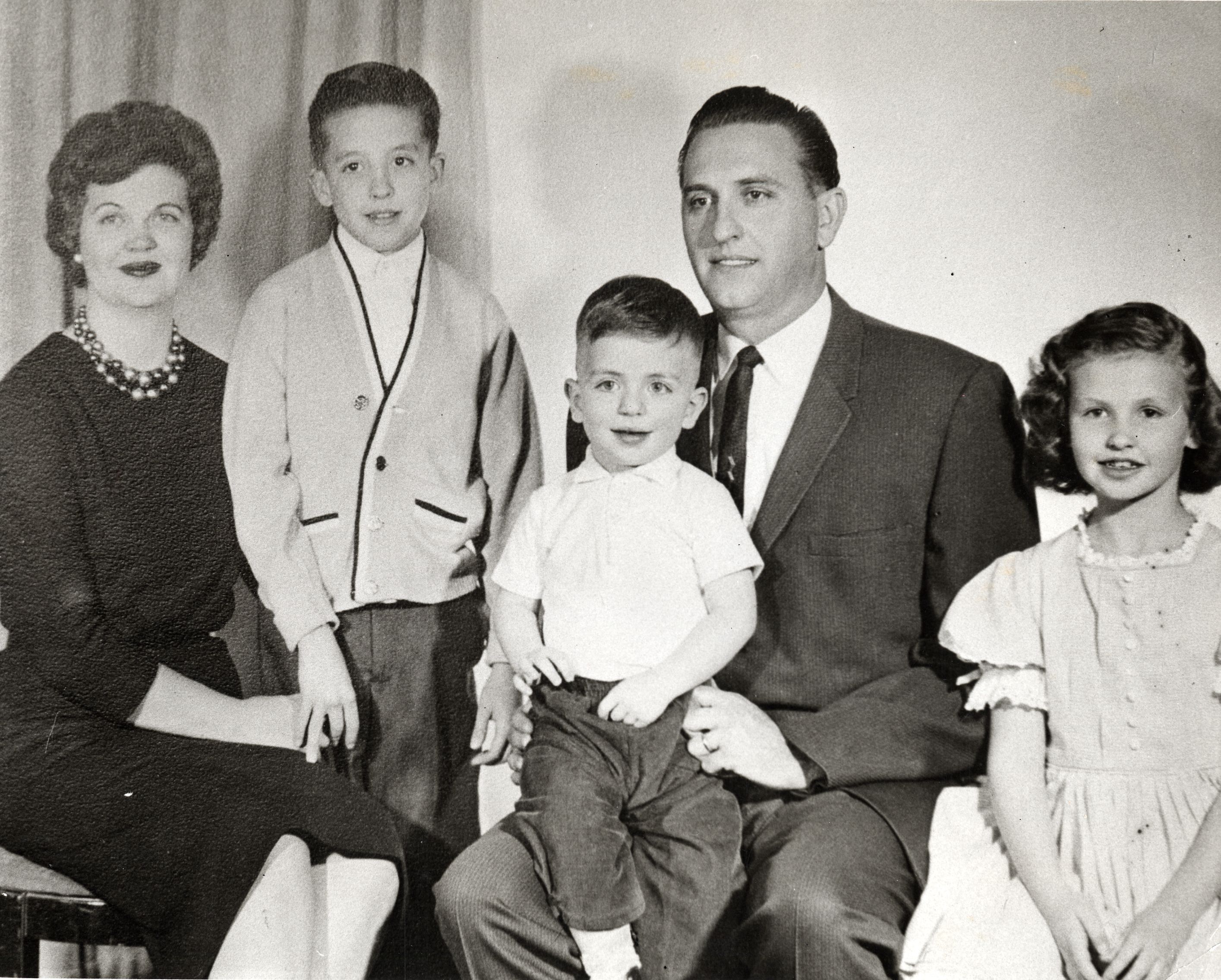 Thomas S. Monson, the young and energetic leader of the Canadian Mission from 1959 to 1962, was accompanied to Canada by his wife, Frances, and their young family. Their youngest son, Clark Spencer, was born in Toronto. (Church News)
Thomas S. Monson, the young and energetic leader of the Canadian Mission from 1959 to 1962, was accompanied to Canada by his wife, Frances, and their young family. Their youngest son, Clark Spencer, was born in Toronto. (Church News)
President J. Earl Lewis, who succeeded President Toone, was instructed to prepare the mission for stakehood. Districts were created in Toronto, Kitchener, and Hamilton with district presidencies, district councilors, and district boards for each auxiliary.[109]
President Thomas S. Monson made sweeping changes when he and his wife, Frances, arrived in the Canadian Mission on 22 April 1959. Young and dynamic, President Monson was thirty-one years old and had been the Assistant General Manager of the Deseret News Press in Salt Lake City, where he was well connected with all the leaders of the Church. The Monsons came with their two children, Tom and Ann, and on 1 October, Sister Monson gave birth to Clark Spencer Monson, who was named after his father’s mentor, J. Reuben Clark Jr. of the First Presidency.
Pat Davies said that when he and his brother, Bill, met President Monson for the first time in Toronto’s Ossington Chapel, they had never encountered anyone like him. Inspired and uplifted, Bill said, “He’ll be the president of the Church someday!”[110]
After an introductory tour of the mission, President Monson developed three objectives:
- To appoint and train local members in leadership positions, thereby relieving full-time missionaries for proselyting. Prior to this, 57 percent of the seven districts were presided over by missionaries. Before President Monson left Canada, 100 percent of the leadership in branches and districts was in the hands of local members of the priesthood. Each district had functioning district auxiliaries, and most of the districts had functioning district councils.
- To initiate and direct a chapel-building program. In 1959, most branches were meeting in rented halls, and no chapels were under construction. Visiting General Authority, Elder ElRay L. Christiansen, encouraged the need for permanency and proper places for the Saints to meet. During the next few years, buildings were completed in the following cities (with the cost of each building indicated).
| Toronto | $200,000.00 |
| St. Catharines | 130,000.00 |
| London | 100,000.00 |
| Sudbury | 85,000.00 |
| Oshawa | 80,000.00 |
| Timmins | 60,000.00 |
____________ $785,000.00 |
Another $915,000 was estimated for chapels in Toronto, Ottawa, Barrie, Belleville, Peterborough, and Sault Ste. Marie, and $43,000 to purchase land for chapels in Brockville, Kitchener, Woodstock, and Tillsonburg, for a total of $1,743,000. At the end of his mission, President Monson was happy to report “every branch in the Canadian Mission had either a chapel of its own, a chapel planned or an active building fund.”[111]
3. To improve missionary effectiveness. President Monson wrote a seventy-five-page handbook outlining new procedures for missionaries.[112] By the time his mission drew to a close, the number of baptisms had increased by 300 percent. The missionaries were on fire. One missionary testimony meeting went from 8:30 am to 10:30 pm, with every missionary speaking.[113]
President Monson was always grateful to report that during his tenure, not one missionary went home with a dishonourable release. In the years that followed, some of them returned to Ontario as mission or temple presidents. Elder Quentin L. Cook of the Quorum of the Twelve has said, “His missionaries have been bishops, stake presidents and mission presidents as well as great fathers and great mothers.”[114]
During President Monson’s administration, the advance of technology began to bring programs directly from Church headquarters. For the first time, in October 1959, men in Hamilton and Toronto gathered to receive the semiannual priesthood conference from the Tabernacle in Salt Lake City, by closed circuit audio broadcasting.[115]
No one wanted to miss Church when President Monson was on the program. First of all, he was a powerful speaker. He introduced members to Doctrine and Covenants 100, and told them this was the Canadian section, for Joseph Smith received it as he was preparing to come into Ontario, and that the “much people in this place, in the regions round about . . . in this eastern land” referred to them. The congregations in the mission sat on the edges of their seats during his talks, laughing out loud one minute, then moved to tears at the next. There was excitement in the air. Members were motivated to reach higher and not only do better, but to be their best.[116]
An example of one of his inspiring meetings was the annual Canadian Mission Youth Conference held at Prudhomme Garden Centre on the shores of Lake Ontario, in July 1960. With 400 youth attending, it was the largest ever held in the mission. At the sunrise testimony meeting, a woman who identified herself as an Anglican rose to her feet and stated, “In all my life, I have never seen such a demonstration of faith, devotion and sincerity on the part of a group of young people.” She went on to say that she wished every church could say the same about its young people. Youth throughout the mission were elated to see full coverage of the conference in the Church News.[117]
The Toronto Ontario Stake
The most memorable and transformative event of President Monson’s administration was the formation of the Toronto Ontario Stake on 14 August 1960, the first stake east of Alberta and the 300th stake in the Church. The announcement of the new stake was read from pulpits throughout the mission. F. James Sorensen, a member of the Toronto Branch presidency, rose one Sunday to read the announcements and stood in silence, fighting back tears. The congregation waited, wondering what could be coming. He finally collected himself and read that a stake would be organized in Toronto in August. He told the members they could not know the great blessings this would bring to the Church in Ontario.[118]
Elders Mark E. Petersen of the Quorum of the Twelve and Alma Sonne, Assistant to the Twelve, were assigned to organize the stake. Both were old friends of the Monsons. Elder Sonne had ordained the twenty-two-year-old President Monson as a bishop in the Sixth-Seventh Ward in Salt Lake City,[119] and five years later was involved in his call into the stake presidency of the Temple View Stake.[120] Elder Petersen was the general manager and chairman of the board of Deseret News where President Monson was employed before his call as mission president,[121] and had been a missionary in the Canadian Mission. Everett S. Pallin, President Monson’s first counselor, found a venue large enough for the historic meeting at the Odeon Carlton Theatre in downtown Toronto. President Monson counted the seats and found that 90 percent of the new stake’s membership would have to attend the conference to fill the seats. He and President Pallin organized a 437-voice children’s choir and a 325-member Relief Society chorus to ensure that would happen.[122] The 2,250 members of the congregation who attended the morning session represented 92 percent of the stake’s population and was the largest gathering of Latter-day Saints in the history of the Church in Ontario.[123]
While in Toronto, Elder Petersen, Elder Sonne and President Monson met with His Worship, Mayor Nathan Phillips, of the City of Toronto. The mayor prepared a reception with city leaders, television reporters, and representatives of the press.[125] An article in the Toronto Telegram dated 10 August 1960 said that there were thirty-five congregations in Ontario and Quebec with more than 5,300 members and 130 missionaries. All of the Toronto newspapers covered the conference as well as newspapers throughout Ontario and as far away as Prince Edward Island.
The new stake president was William M. Davies, who had been president of the Toronto District and who had given a prayer at the dedication of the Ossington chapel in 1939. He called as his counselors Horace Cecil Tayler, who had been president of the Hamilton District, and Elden C. Olsen, who had been president of the Kitchener District. Members of the stake council, stake auxiliary presidencies, and new bishops were announced. Janet Boucher, the new stake Relief Society president, Byron and Irene Palmer, the Young Men and Young Women Mutual Improvement Association presidents, and Marie Templeman, the stake Primary president, were all from Alberta. The mission history reported, “Truly August 14 was a day of rejoicing for the Saints of the Canadian Mission and heralded a beginning of a new era of the Church in the province of Ontario.” [126]
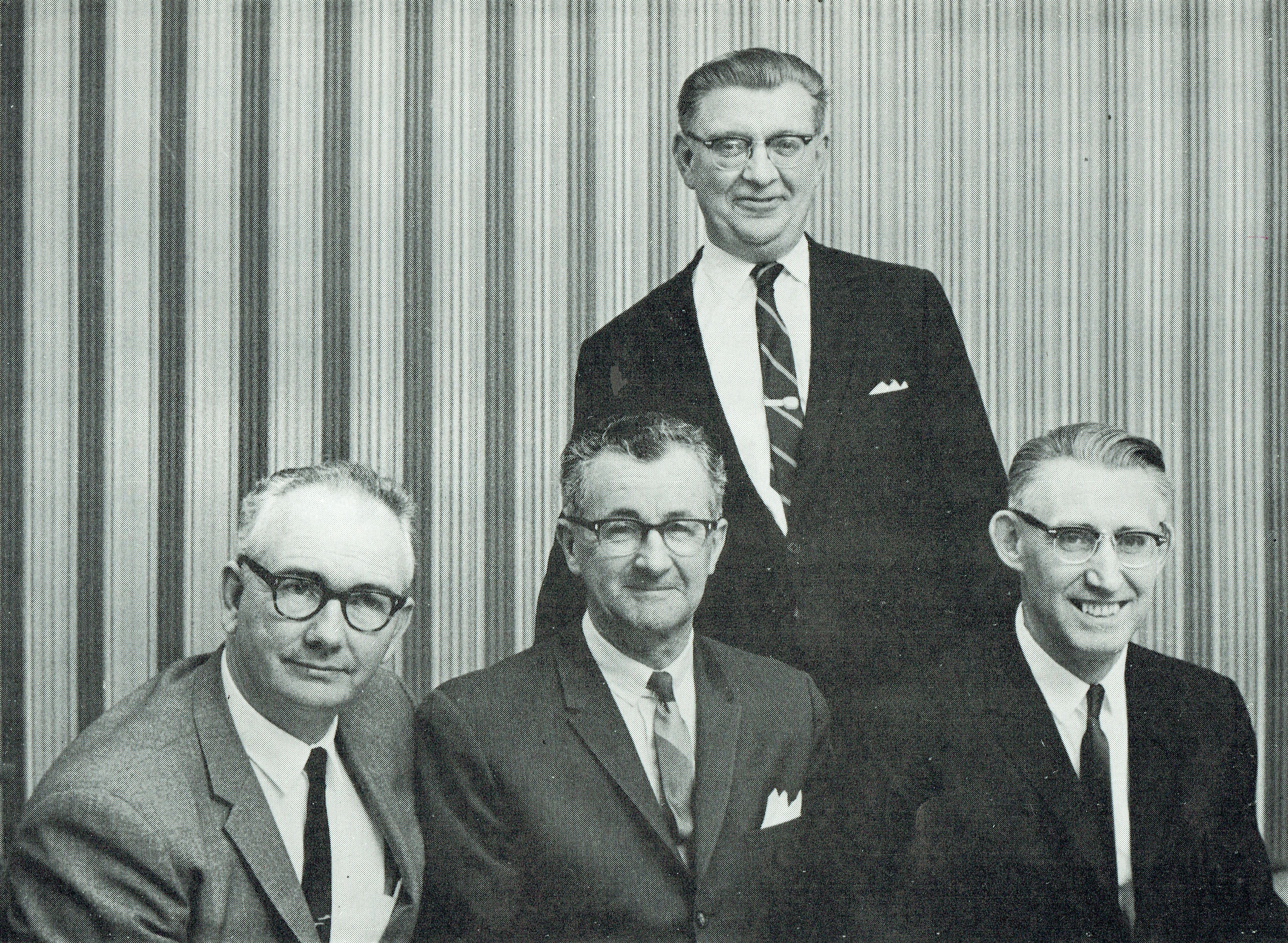 Presidency of the Toronto Stake, organized in 1960. Left to right, H. Cecil Tayler, second counselor; William M. Davies, stake president; Elden C. Olsen, first counselor; standing at rear, Ralph W. Brown, clerk. (Dedication Programme for Toronto Ontario Stake Centre and Toronto Second Ward Chapel, 11 December 1966)
Presidency of the Toronto Stake, organized in 1960. Left to right, H. Cecil Tayler, second counselor; William M. Davies, stake president; Elden C. Olsen, first counselor; standing at rear, Ralph W. Brown, clerk. (Dedication Programme for Toronto Ontario Stake Centre and Toronto Second Ward Chapel, 11 December 1966)
Chapel Building and Church Growth in the 1960s
The day following the creation of the Toronto Stake, Elder Petersen dedicated the chapel in Chatham, after which he moved on to another historical occasion with the groundbreaking service for the St. Thomas Chapel. Later that year, construction started on chapels in Oshawa, East Toronto, and St. Catharines, work continued on those in Timmins and London, and advanced planning went ahead for chapels in Sudbury, Sault Ste. Marie, and Ottawa and for the Toronto Stake Centre. Record numbers of members and their friends attended the meetings in the newly built meetinghouses. Douglas McGinn, president of the North Bay District, presided over the first district conference held in the new chapel in Timmins on 5–6 November 1960 and remembers, “President Monson transformed the mission.”[127]
As missionaries arrived in a city, articles, often with photos and biographies, were published in the local newspapers. When General Authorities toured the mission, their visits were also noted in the press. Civic leaders were invited to groundbreaking ceremonies and dedications.[128] A chapel had been planned for the Elliot Lake Branch, north of Toronto, but with the collapse of the uranium market in Canada, the once-strong branch membership was drastically reduced in number, and land that had been purchased was returned to the township. The Church was able to recover 80 percent of its purchase price.[129]
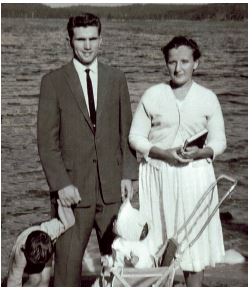 Marjorie Nicholls stands with her two children, Susan and Alan, and Elder Ronald L. Knighton from Centerville, Utah, before her baptism early Sunday morning, 26 July 1959 at Depot Lake. Right after the baptism, the group drove to Church at Elliot Lake where she was confirmed. Her husband, Lee, was baptized in December in the YMCA pool in Sault Ste. Marie. They later moved to Welland and then to Brampton, where they served faithfully in the Toronto Ontario Temple for many years. (Marjorie Nicholls)
Marjorie Nicholls stands with her two children, Susan and Alan, and Elder Ronald L. Knighton from Centerville, Utah, before her baptism early Sunday morning, 26 July 1959 at Depot Lake. Right after the baptism, the group drove to Church at Elliot Lake where she was confirmed. Her husband, Lee, was baptized in December in the YMCA pool in Sault Ste. Marie. They later moved to Welland and then to Brampton, where they served faithfully in the Toronto Ontario Temple for many years. (Marjorie Nicholls)
As the Church grew, the faithful service given by its members is inspiring. W. Glen Keyes, elders quorum president, and his first counselor, Anthony Belfiglio, took one week of their annual vacation to visit forty-three quorum members in isolated areas in northern Ontario. They hitched a small trailer to the back of their car in Toronto and travelled 2,468 km (1,534 mi) in seven days. They found every member of the quorum in Sudbury, Sault St. Marie, Elliot Lake, North Bay, Timmins and Orillia except for four who were in inaccessible areas. At one point they parked their car and trailer and hiked two miles over rough terrain to reach a quorum member.[130]
Hilda Crawshaw travelled 1,500 km (900 miles) by bus to attend a district conference in North Bay. She said that when the district president asked her why she would come “all the way from Ottawa just to attend our district conference,” she told him she represented the Mission MIA. He then “expressed such warmth and enthusiasm for my attendance that it was most gratifying to be there.”[131]
It would be difficult to describe the feelings of the members with new chapels. No more climbing up to the top floor of rented halls and cleaning the room before meetings could be held. Now members were comfortable bringing their friends to Church. At the first meeting at Toronto’s McCowan Road chapel, it was recorded, “This was the opening of our new Toronto Ward Chapel. Missionaries assisted in greeting and ushering. It was a wonderful evening for all. Our first baptismal service was held following the meeting.”[132]
Building of Chapels
Under the direction of President Frank H. Pitcher, who succeeded President Monson, the mission reached an all-time high with 1,037 baptisms in 1962, and by March of 1963, there were 4,475 members in the mission. Mission boards, called to supervise district auxiliaries, travelled to district meetings to train auxiliary leaders. Districts had district councils in preparation for more stakes.[133] Such rapid growth required the building of many new chapels.
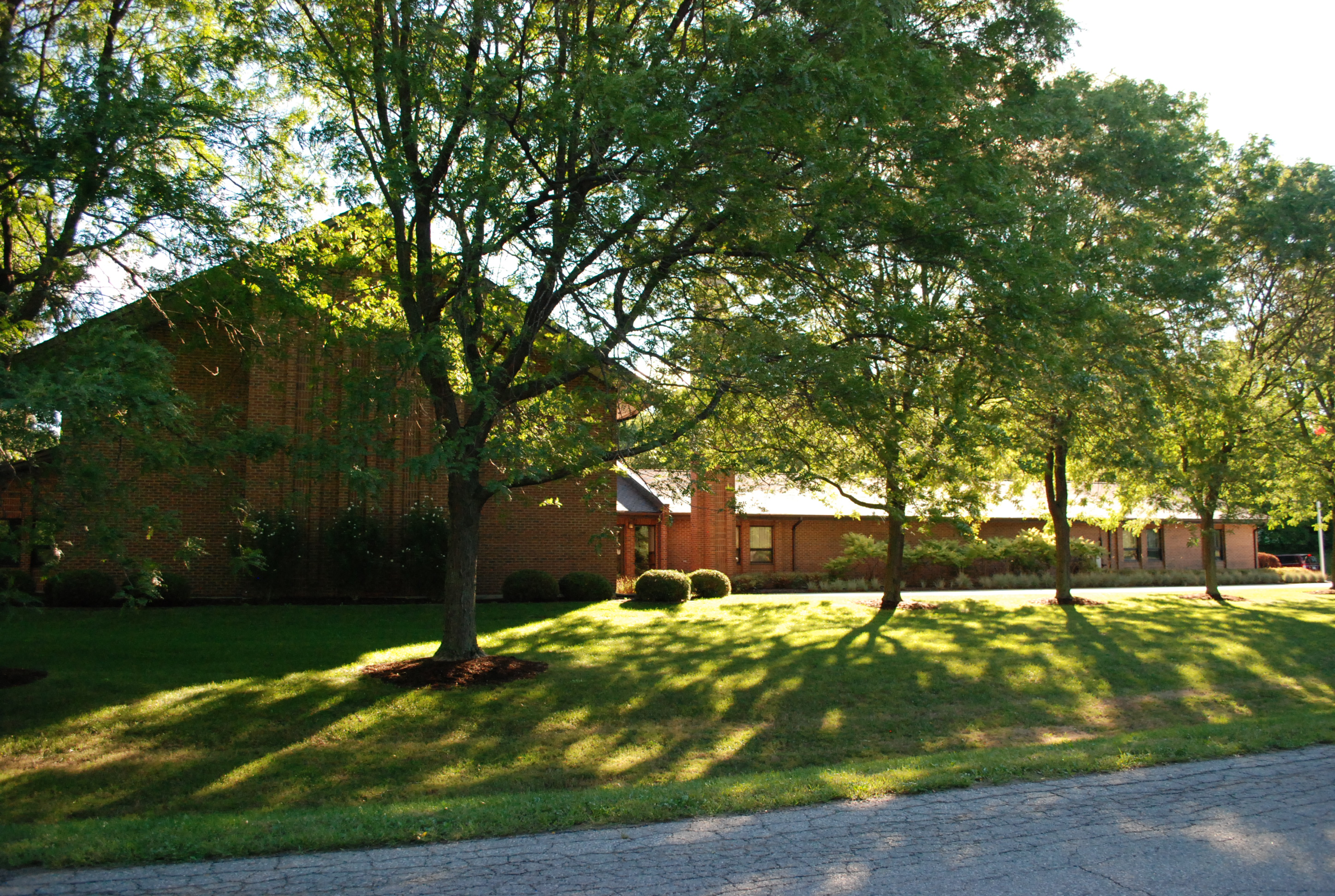 The Trenton chapel, built in the 1960s with the help of building missionaries, has since benefitted from the construction of additional phases. (Mark Saigeon)
The Trenton chapel, built in the 1960s with the help of building missionaries, has since benefitted from the construction of additional phases. (Mark Saigeon)
Chapel building involved the entire Church community. Groundbreaking ceremonies for three chapels were held in July 1963. All three building supervisors were members from Ontario: Orval Tustian was assigned to Belleville, George Boyd to Barrie, and Lennart Lappalainen to Peterborough.[134] Building new chapels meant member support with both labour and means. Building fund projects ranged from bake sales, fashion shows, flyer and catalogue delivery, chocolate making, and bazaars to individuals taking on projects like a member in a nursing home in Port Arthur who sold walnut shells he carved into ornaments or Sister Wilson, in Bracebridge, who sold her baking to her neighbours. In Trenton, the Vieau family raised and sold Christmas trees. In Port Arthur, the brethren had a woodlot where they cut, split, sold, and delivered firewood and the sisters made and sold perogies, an Eastern European potato and cheese dumpling, and once got an order for 1,000 dozen.[135]
Members of the Church Building Committee met with Toronto Stake and Canadian Mission leaders and a decision was made to call young men as building missionaries to help build the new chapels. Branch and district leaders, gave their support to a program where a chapel would be completely paid for and dedicated at the time of its completion. In addition to thousands of hours of work at the chapels by members, the building missionaries were a valuable asset. The first to arrive came from the New England Mission. Arthur Murray was sent to Belleville, and Peter Atwater to Peterborough. By 1964, when building sites were purchased for Brockville, Orillia, North Bay, Cornwall, Tillsonburg, and Trenton, more building missionaries were called. Church leaders supervising the work on the Ottawa Chapel decided to reduce the number of building missionaries from ten to five to place a more favourable ratio of hours worked by members versus building missionaries.[136] Kitchener members still talk about Orville Tustian and his building missionaries. Whenever one of them got hurt, Brother Tustian would unsympathetically tell them, “That’ll toughen you up.” Once Arthur Murray was standing on top of a high ladder soldering pipes while Brother Tustian stood below steadying the ladder. Elder Murray accidentally dropped some of the hot solder, and it fell down Brother Tustian’s neck. When he heard the cry of surprise and pain below him, Elder Murray humorously followed his leader’s example and shouted down, “That’ll toughen you up!”[137]
Publicity and Recognition
In the 1960s, Ontario newspapers carried many articles about George Romney, stake president in Detroit, governor of Michigan and the president of American Motors, mentioning his birth in the Latter-day Saint colonies in Mexico and the mission he served in Great Britain. Writer Ted Douglas of the Windsor Star, reviewed a biography called The Story of George Romney, by Tom Mahoney, and said, “In our town, the Romney book rates a place at the top of the list.”[138] It was determined that branches in Sarnia, Windsor and Chatham were closer to Detroit than to London, and were part of the Detroit Stake.
Fall fairs offered missionary opportunities. In 1964, an attractive booth promoting the Church was constructed by missionaries for the Canadian National Exhibition in Toronto, and the result was 1,500 referrals. Soon missionaries manned booths in other fairs in Ontario towns and cities. When the spectacular Mormon Pavilion at the World’s Fair in New York opened in 1964, the message of the Restoration was “vividly illustrated by murals, dioramas, statues and the popular film, Man’s Search for Happiness.”[140] By August, Man’s Search for Happiness was shown at the mission booth at the Canadian National Exhibition and over 7,000 people viewed the film and 700 referrals were obtained. At the Western Fair in London, 3,000 saw it, and at the Chatham Jaycee Fair, it was seen by 780 people in 1967.[141]
Canada’s 1967 centennial was celebrated by President Lamont F. Toronto, who arrived in the Canadian Mission in 1965 with a history of political service. In a Toronto Star article written to highlight his unusual name, he said that his goal was to “build a good church image in the eyes of the people of Canada so they will become more receptive to listening to the message of our missionaries.”[142] President Toronto had served three terms as Secretary of State for Utah, been in the state House of Representatives, and was serving as the president of the National Association of Secretaries of State at his call. Within weeks of his arrival in Toronto, he represented the Church at the annual meeting of the National Council of Boy Scouts and became a member of Canada’s 1967 Centennial Planning Commission. He represented the Church at the Centennial Torch Light Ceremony at the House of Parliament in Ottawa on 1 January 1967.[143] Through his outreach, more people heard about the Church. Press coverage was positive as missionaries and the mission president made presentations of copies of the Book of Mormon to civic leaders and Members of Parliament. While presenting a Book of Mormon to His Excellency, the Governor-General and Madame Georges Vanier, President Toronto told them about the Church’s family home evening program as well.
1969 Canadian Mission Jubilee Year
The fiftieth anniversary and jubilee year of the Canadian Mission was celebrated in grand style in 1969 by President and Sister C. Leland Davey. Sloan Alma Smith, first counselor in the mission presidency, was called as chairman of a committee to produce a book, and with the assistance of Irving Wilson, second counselor, and missionaries Paul Hedengren and Brant Russell, printed The Great Canadian Mission, A Jubilee History, 1919–1969, on the mission press. The owners of the Skylon Towers, a tourist attraction overlooking Niagara Falls, invited President Davey to hold an Easter service in front of their building, and the service received excellent press and TV coverage. From June to September, there was an exhibit where 2,800 visitors saw Man’s Search for Happiness and 400 copies of the Book of Mormon were sold. Skylon Towers personnel provided five televisions in the building for visitors to watch one session of the 139th General Conference of the Church. “Meet the Mormons” evenings were held around the mission to celebrate the anniversary.[144]
In July, exactly fifty years after President Nephi Jensen’s arrival to open the mission, Elder Mark E. Petersen of the Quorum of the Twelve spoke at a fiftieth anniversary celebration at the Toronto Stake Centre, where he reviewed highlights of the mission, and in August the film The Morning Breaks was seen by over 23,000 people at the exhibit at the Canadian National Exhibition in Toronto.[145]
One hundred billboards across central and southern Ontario publicized the Mormon Tabernacle Choir’s visit to the Canadian National Exhibition in Toronto that year, and fifteen thousand people heard their performances. Tuesday, 19 August, was Mormon Day at the fair, and a “Mormon Happening” was held at the band shell featuring a variety show “with Mormon talent from Ontario.”[146]
In October 1969, Ardella Davey conducted a Relief Society Jubilee Conference with Elder Petersen, and his wife, Sister Emma Marr Petersen, and Sister Belle S. Spafford, Relief Society General President and president of the US National Council of Women, as guest speakers.[147]
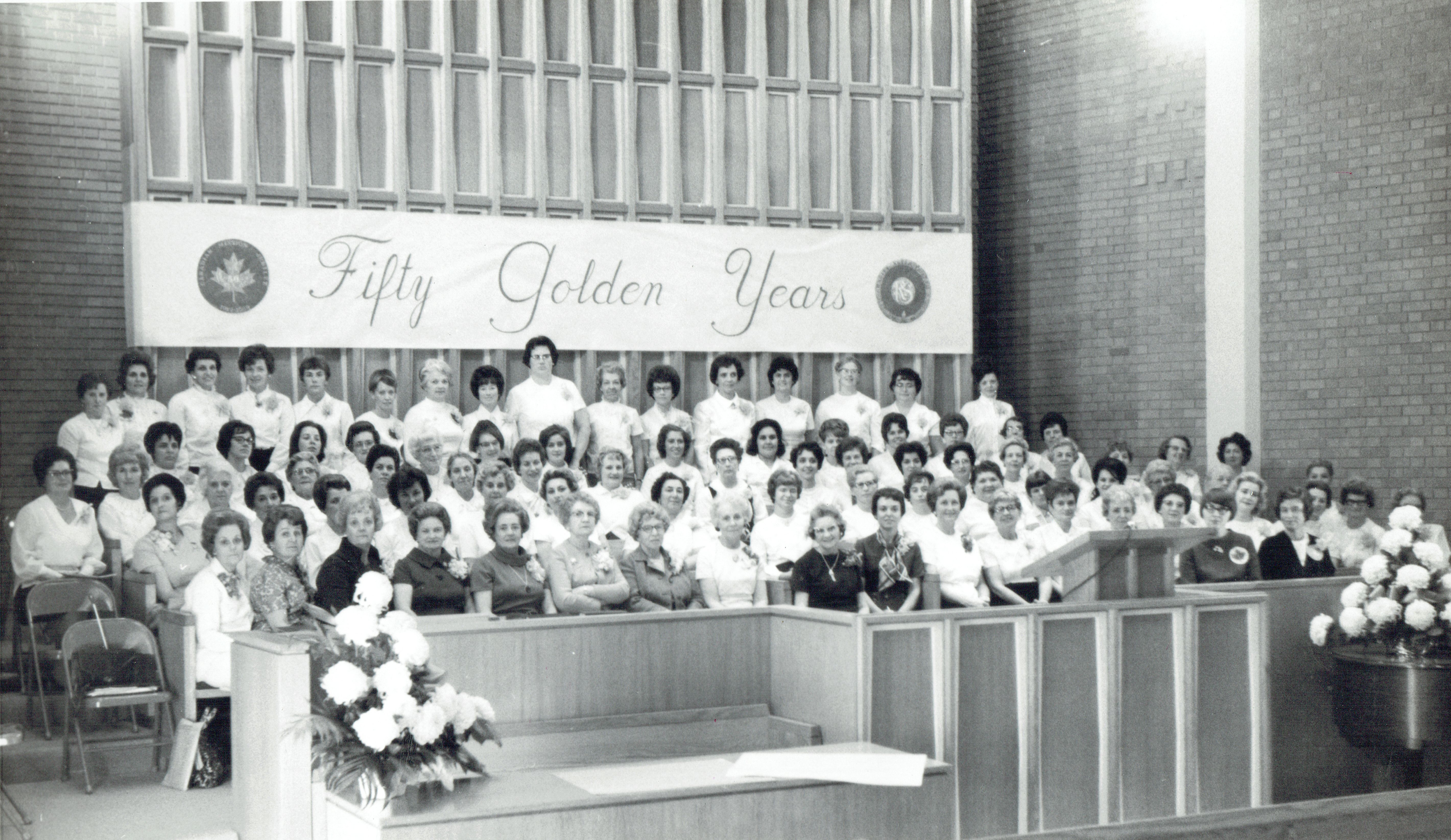 Relief Society leaders from the Canadian Mission, the Toronto Ontario Stake, and the Relief Society General Presidency gather to celebrate the jubilee of the Canadian Mission. The General Relief Society presidency consisting of Ellen N. Barnes, Louise W. Madsen, and Belle S. Spafford are seated, front row fourth to sixth from the left. Ardella Davey, wife of Canadian Mission President Leland Davey, is eight from the left. (Toronto Ontario Stake Relief Society History)
Relief Society leaders from the Canadian Mission, the Toronto Ontario Stake, and the Relief Society General Presidency gather to celebrate the jubilee of the Canadian Mission. The General Relief Society presidency consisting of Ellen N. Barnes, Louise W. Madsen, and Belle S. Spafford are seated, front row fourth to sixth from the left. Ardella Davey, wife of Canadian Mission President Leland Davey, is eight from the left. (Toronto Ontario Stake Relief Society History)
The year’s celebrations were wrapped up in the heart of Toronto at the Yorkdale Shopping Centre where carol singing by the missionaries spread the Christmas spirit “as the busy shoppers stopped to hear the glad sounds.”[148]
New Mission Home
On 5 March 1969, after years in the heart of Toronto at 133 Lyndhurst Avenue, a new mission home was purchased in Brampton, northwest of Toronto on the advice of Elder Mark E. Petersen, director of missions for the Eastern United States and Canada, who suggested a mission home be found away from the congestion of downtown Toronto and closer to the airport. The inspiration of the Lord was manifest in the purchase of a new mission home at 200 Main Street South. President Davey told a Brampton reporter, “It’s the nicest location we found for our mission headquarters. Eventually we hope we’ll grow large enough to have a church in Brampton with a lovely chapel and nice congregation.”[149] At the time of the move, there were two missionaries serving in Brampton, and Church members there attended the Etobicoke Ward in West Toronto.
His words were prophetic for the Brampton area. Churchville[150], the centre of pioneer baptisms in Peel County where Joseph Smith visited in 1837,[151] was designated as an Heritage Conservation District in Brampton and some historic buildings that were there in 1837 are preserved. In 1981, a stake was created in the city, and in 1990, the Toronto Ontario Temple was dedicated in the northeast section of the city on a plot of land chosen by President Gordon B. Hinckley.
Seminaries and Institutes
Members of the Church from Alberta who moved to Ontario were responsible for starting early morning seminary classes in various places in the mission. In 1967, Alexander B. Morrison taught eighteen students in Ottawa before he went to work each day at the Department of Health and Welfare; Sloan Alma Smith held a class in Toronto; and Elden C. Olsen started one in his home in Kitchener. Another was held in the London District. Max Craner and Bill Burnett, Church Educational System coordinators from the United States, travelled to Ontario to hold monthly meetings with the students. The first Deseret Club, a precursor to the institute program, was started in 1968 by C. Malcolm Warner, a native of Ottawa and a chemistry professor at the University of Guelph.
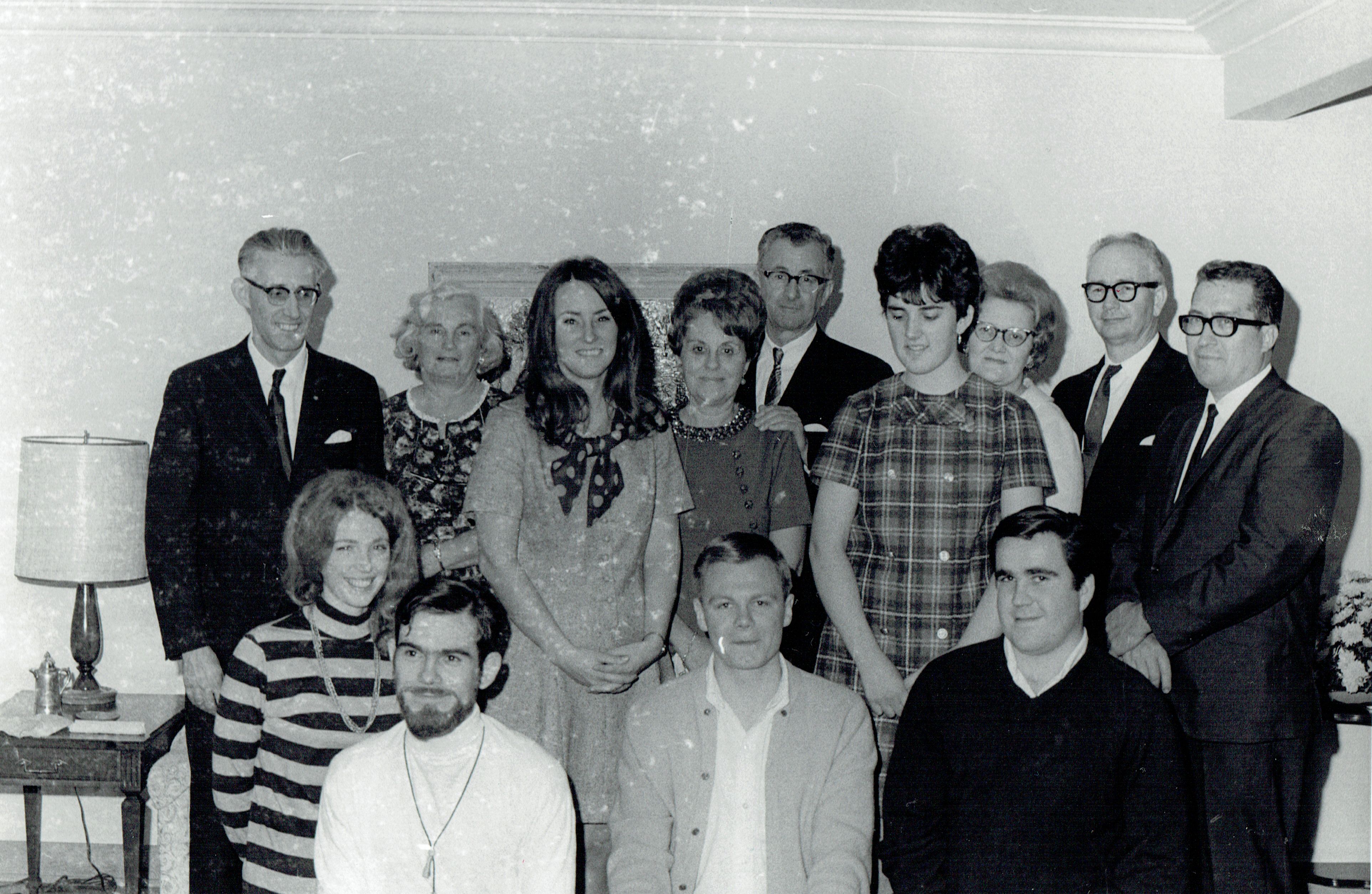 Members of the Deseret Club at the University of Guelph meet with members of the Toronto Stake Presidency and their wives in 1968. (Malcolm Warner)
Members of the Deseret Club at the University of Guelph meet with members of the Toronto Stake Presidency and their wives in 1968. (Malcolm Warner)
In 1970, Warner was approached by Seminaries and Institutes and asked to become the first full-time employee residing in Ontario. It was a huge decision to leave his career. He had just been a visiting scientist with the Dutch government for a year, and of course, there was a big reduction in salary. After much prayer, he and his wife, Helen, decided to accept the position. His task was to meet with priesthood leaders throughout the province and encourage them to start seminary classes for their youth. He taught weekly institute classes at the University of Western Ontario in London, the University of Guelph, the University of Waterloo, and at the Ossington Chapel for students at universities in Toronto. A monthly class was held for students at Trent University in Peterborough. Seminary students travelled to central locations for monthly Fantastic Fridays and Super Saturdays with lessons and activities, and institute students gathered for retreats. Scripture mastery competitions were held across Ontario, and students practiced to be the best scriptorians in the area. Belle Coleman’s class in Hamilton won the prize for years. As the number of students increased, other faculty members were transferred to Ontario to handle the demands of the successful program.[152]
A Lamanite seminary program started in 1970. C. Malcolm Warner and Mission President C. Leland Davey made presentations to the chiefs and councils on Ontario reserves, and in every case permission was granted to hold classes. The best missionaries were chosen as teachers, and the teaching materials came from Utah. Regular classes were held at the Six Nations Reserve on the Grand River and at the Cape Croker First Nation Reserve in the Bruce Peninsula on Georgian Bay.
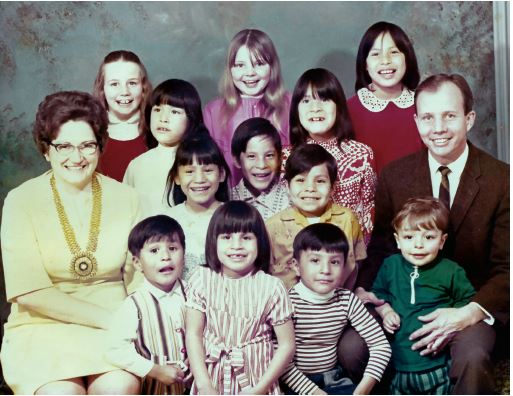 Stanley and Gwena Morrill with their twelve children were important contributors to Lamanite Seminary. Begun in 1970, Lamanite Seminary, often taught by missionaries at the outset, proved to be quite successful. (Gwena Morrill)
Stanley and Gwena Morrill with their twelve children were important contributors to Lamanite Seminary. Begun in 1970, Lamanite Seminary, often taught by missionaries at the outset, proved to be quite successful. (Gwena Morrill)
Stanley and Gwena Morrill, who worked in the Lamanite Seminary program in Chinle, Arizona, were transferred to Ontario as the number of students grew. They came with five children, three of whom were indigenous children they had adopted in Arizona. And in Ontario, they adopted a family of seven more indigenous children, giving them an even dozen. At its peak, there were 250 students who attended the seminary classes, and good public relations resulted. Jean Borrows, who lived at the Cape Croker First Nation Reserve, says that people still talk about the missionaries and the seminary program. She feels the “lessons in values that were taught may yet have dividends in the future. Good seeds were planted and just as sequoia seeds lay dormant for a long time before they germinate, I am sure the gospel seeds planted by the Lamanite seminary program will yet grow.”[153] With the need for the missionaries in other assignments, they “were eventually pulled from the program to be used in other areas,” [154] and the classes were gradually discontinued.
Ontario Weather
Weather was always a topic of discussion by Church leaders. Winter storms sometimes made it necessary to cancel meetings. Mission presidents from warmer climes were astonished to be driving through snowstorms and find the road ahead closed because of snowdrifts. In March of 1968, two missionaries were stranded on an island in the St. Clair River for three days. They had taken the ferry to teach at a reserve, and, when they were ready to leave, the river was frozen and the ferry grounded. Then a blizzard kept the ferry from running for three more days. The elders stayed with the chief of the tribe and his family.[155]
There are many accounts of gratitude for safety in their travels. Returning from training meetings in Sudbury in the winter of 1968, President and Sister Davey and their mission board stopped at a fast-food restaurant. Hoping for a quick exit, they became frustrated when the service was uncharacteristically slow. When they were finally on their way, they found that because of the delay, they had missed being involved in a huge automobile pileup on the highway.[156] Prayers for safety protected the Saints more than we know.
Washington D.C. Temple
In November 1968, a temple was announced in Washington, DC. Up until that time members in Ontario travelled to Salt Lake City, Idaho Falls, or Cardston, Alberta, for temple ordinances. Before interstate highways, the trip by car could take three or four twelve-hour days one way and was often a once-in-a-lifetime journey. Members felt it was an honour to be asked to raise funds for the Washington D.C. Temple, to which they could drive in only one day. When the incredibly beautiful temple was dedicated on 19–22 November 1974, many members from Ontario were there. From then on, busloads of youth from Ontario made annual trips to perform temple baptisms. They held bake sales and auctions to raise the money for the trip and shared rooms at the Marriott Hotel close to the temple.[157]
For a short time during the administration of mission president Roy L. Spackman, the mission was called the Ontario-Quebec Mission, but the mission was divided when the Quebec Mission (later called the Canada Montreal Mission) was formed in March 1972. The mission in Ontario became the Canada Toronto Mission in 1974.
New Stakes and Expanded Church Programs in the 1970s
The 1970s were a period of sustained growth for the Church in Ontario resulting in the creation of four new stakes. The mid-1970s were marked by the arrival of M. Russell Ballard with his wife, Barbara, to preside over the Canada Toronto Mission. Area youth conferences were begun with great enthusiasm among the youth. As the Church continued to grow, more programs were developed, including the establishment of a bishops’ storehouse in Toronto in 1979. The culminating event of the decade was the Area Conference in August 1979, with President Spencer W. Kimball in attendance.
Hamilton Ontario Stake – 6 September 1970
Ten years after the formation of the Toronto Ontario Stake, Elder Thomas S. Monson of the Quorum of the Twelve was back in Toronto for the fall quarterly stake conference, where he announced that sufficient growth had occurred that another stake could be created. Called the Niagara Stake when formed in 1970, the new stake was renamed the Hamilton Ontario Stake on 1 February 1974. Elden C. Olsen was sustained as stake president, and the stake was composed of the Hamilton, St. Catharines, Oakville, and Kitchener Wards and the Brantford, Galt, and Welland Branches.[158]
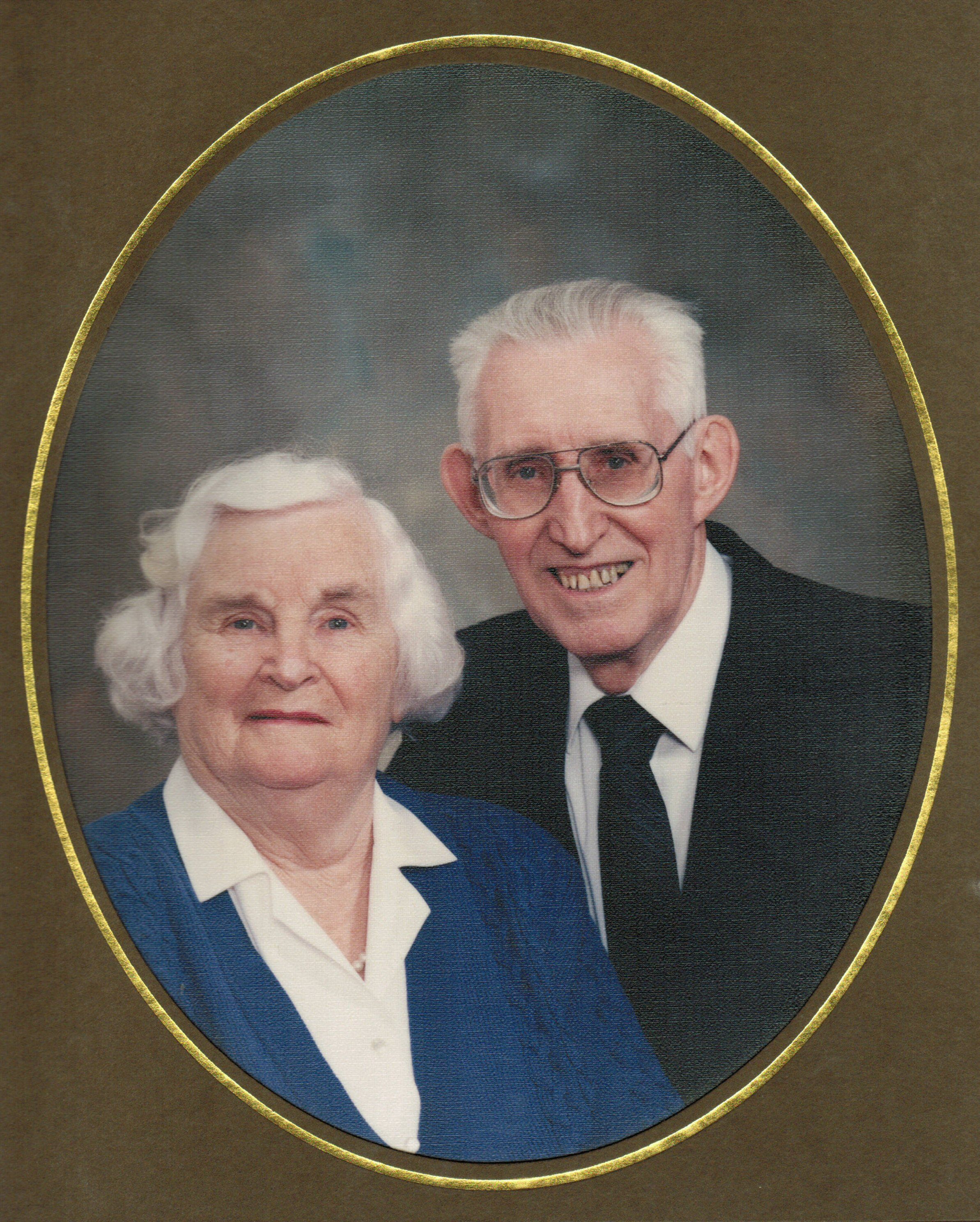 Elden Olsen, first president of the Niagara Ontario Stake, later named the Hamilton Ontario Stake, with his wife, Thelma. President Olsen later served as Regional Representative, stake patriarch, and a temple sealer. (Courtesy of Norman Olsen)
Elden Olsen, first president of the Niagara Ontario Stake, later named the Hamilton Ontario Stake, with his wife, Thelma. President Olsen later served as Regional Representative, stake patriarch, and a temple sealer. (Courtesy of Norman Olsen)
Land for an 18,500 square feet stake centre was purchased on Stone Church Road East in Hamilton in 1973 at a time when local members contributed to the cost of the building with both labour and funds. The dedicatory service took place on 15 April 1979, when the building was completely paid for and the Hamilton Saints were happy to welcome Elder Monson back for the dedication.
The stake centre has been lovingly cared for over the years by William Goddard, the first custodian. He kept the building in such pristine condition that Elder Monson remarked as he walked through it that he had seen buildings as well kept, but none better. It is interesting to note that Brother Goddard, in his late eighties in 2015, was still going to the stake centre five days a week to maintain its reputation.[159]
In 2007, a chapel was built in downtown Hamilton for the Hamilton Fifth Branch, and at the open house, local dignitaries expressed appreciation for the commitment of the Church to the people of Hamilton. Stake president Bill Harvey told the congregation, “Building Steeltown’s first new downtown church in 103 years sends out a powerful message . . . the building declares that religion is alive and well.”[160]
London Ontario Stake – 11 April 1976
Early Church meetings in London were held in homes and then rented halls under the direction of the missionaries. Members from St. Thomas joined them for sacrament meetings. The first branch was organized in 1949, and at its first building fund project in 1951, raised $17. Subsequent fundraising was much more lucrative, allowing land to be purchased at 615 Baseline Road for a chapel. Members really did give blood, sweat, and tears for their building, for they not only volunteered hours of labour, but many donated their blood and gave the $15 a pint received to the building fund. Elder Monson, then the mission president, was there for the opening service in the new chapel on 2 April 1961. Branches in Sarnia, Windsor, and Chatham which had been transferred to the Detroit Michigan Stake when it was created on 13 August 1967, were moved to the London Ontario Stake when it was organized on 11 April 1976, with Harold Crookell, a professor from the Ivey School of Business at the University of Western Ontario, as stake president. There were units in London, Windsor, Sarnia, Chatham, Hanover, Stratford and St. Thomas. President Crookell told a local newspaper that about $110,000 had been raised locally for the building fund during the previous two years[161].
Toronto Ontario East Stake – 13 June 1976
On 13 June 1976, N. Eldon Tanner of the First Presidency realigned the Toronto Ontario Stake to create the Toronto East Stake. He was assisted by Elder Thomas S. Monson of the Quorum of the Twelve and President M. Russell Ballard of the Canada Toronto Mission. J. Bruce Smith was released as president of the Toronto Ontario Stake and called to preside over the new stake with wards in Belleville, Cobourg, Peterborough, Trenton, Oshawa, Toronto 3rd and 4th and Richmond Hill, and a membership of 2,307. The name was changed to the Oshawa Ontario Stake on 22 June 1986.[162]
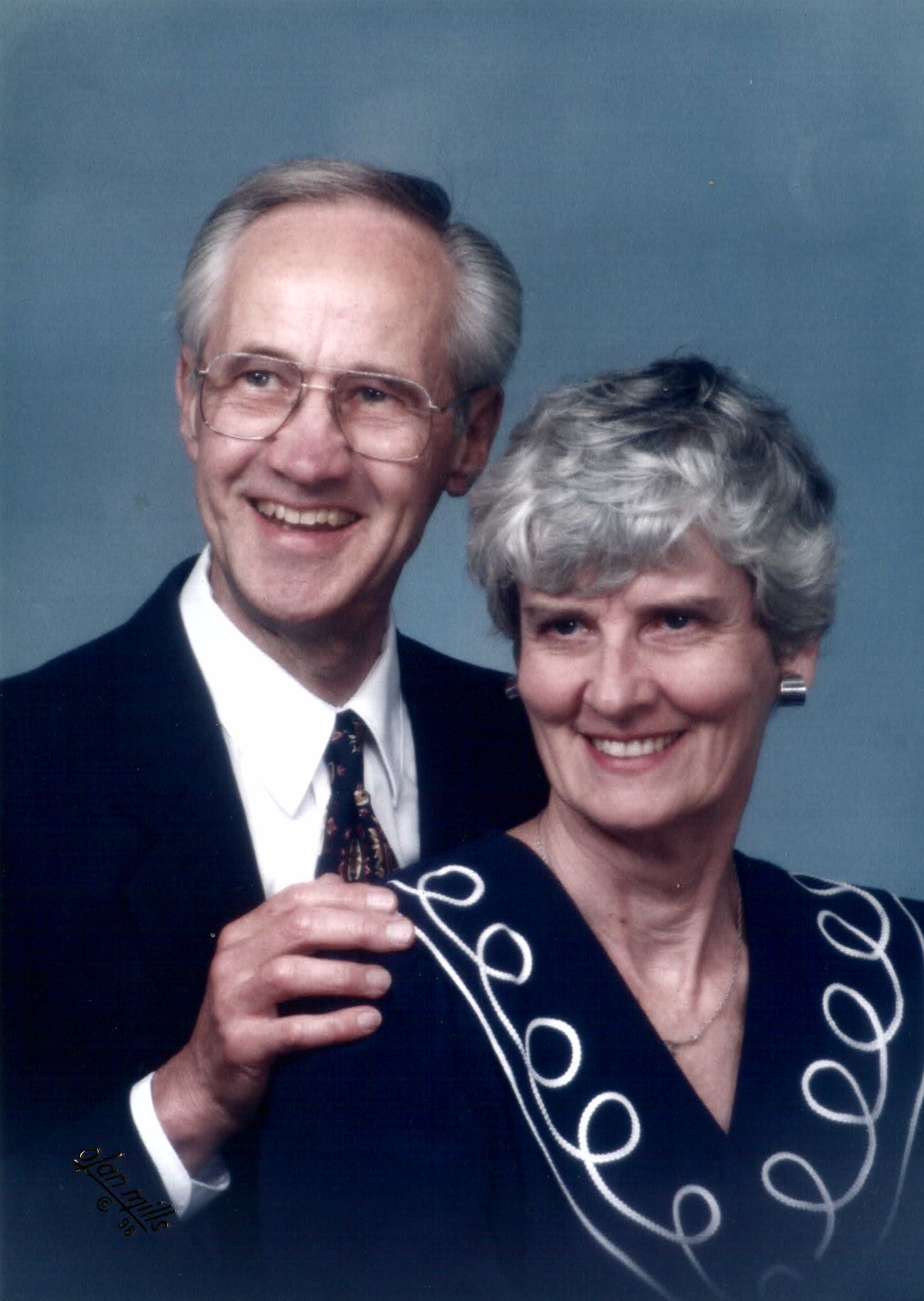 Bruce and Dolina Smith were converts to the Church from Fort William, Ontario. He served as president of the Toronto Ontario Stake and the Toronto Ontario East Stake (later named Oshawa Ontario Stake) and as regional representative of the Twelve. Dolina Smith founded Canadians Addressing Sexual Exploitation and ran an annual White Ribbon campaign to draw attention to child pornography and child sexual abuse in Canada. (Bruce and Dolina Smith)
Bruce and Dolina Smith were converts to the Church from Fort William, Ontario. He served as president of the Toronto Ontario Stake and the Toronto Ontario East Stake (later named Oshawa Ontario Stake) and as regional representative of the Twelve. Dolina Smith founded Canadians Addressing Sexual Exploitation and ran an annual White Ribbon campaign to draw attention to child pornography and child sexual abuse in Canada. (Bruce and Dolina Smith)
Ottawa Ontario Stake, 12 December 1976
Boyden E. Lee, the first president of the Ottawa Ontario Stake, says that when the stake was organized, it was one of the largest stakes, geographically, in the Church. It included parts of Ontario, Quebec, and northern New York state and had twelve wards and branches. As president of the Ottawa Ontario District, he had received a strong impression that his primary responsibility was to prepare the district for stakehood. Since there were only 1,100 members at the time, it seemed a long-range goal, and the district presidency decided on a four-year plan for its implementation. With the transfer of the Kingston Branch, the Outaouais Branch, and the Montreal (English) District to the newly created Ottawa-Montreal District, the necessary numbers were reached to form the stake. The Ottawa Ontario Stake was organized on 12 December 1976 by Elder Thomas S. Monson and President M. Russell Ballard, with Boyden E. Lee as president.[163]
The vast distances between units in the stake presented challenges. Even getting together for stake presidency meetings required each member driving one and a half hours to get to Cornwall which was equidistant from Ottawa and Montreal. One visiting General Authority urged them to spend no more than one hour per week in stake presidency meeting. When he learned that the presidency travelled three hours just to get to and from their meetings, he was “flabbergasted,” and told them to “simply do whatever worked best in our area.”[164]
The 1970s were a time of rapidly increasing land prices and high inflation, and most of the units in the new stake were meeting in rented halls. Members in the small branches could not hope to raise the funds needed for buildings. In response, the stake presidency planned an astonishing $1,000,000-building-fund project to build new chapels. To present the proposal, President Lee called a solemn assembly, and members were asked to attend in fasting and prayer. He wrote, “I shall never forget this event as long as I live. I knew that our members were not wealthy, that they needed their funds, as I did, to provide for their families, . . . yet I also knew that the Lord expected this of us.” Constant prayer led him to decide that he should pronounce a special blessing on the stake membership to the end that the Lord would help them meet their commitments. He said, members “responded to this heavy financial challenge in a most miraculous way, and the Lord, in turn, did indeed bless each family most abundantly.”[165] Within two years, $800,000 had been raised, and by the time the stake was divided, on 6 July 1980, forming the Montreal Quebec Mount Royal Stake in Quebec, buildings were built, in construction, or approved in Ottawa for a stake centre, and for chapels in Kingston, Smiths Falls, Brockville, Petawawa, Greenfield Park and Pointe Claire in Montreal, and in Potsdam, New York. The Montreal Quebec Mount Royal Stake, with Ian G. Wilson as president, included the Cornwall Ward and the Hawkesbury Branch in Ontario. The Ottawa Ontario Stake remained within the Canada Montreal Mission and has been part of the Montreal Quebec Temple district since 2000.
President and Sister M. Russell Ballard
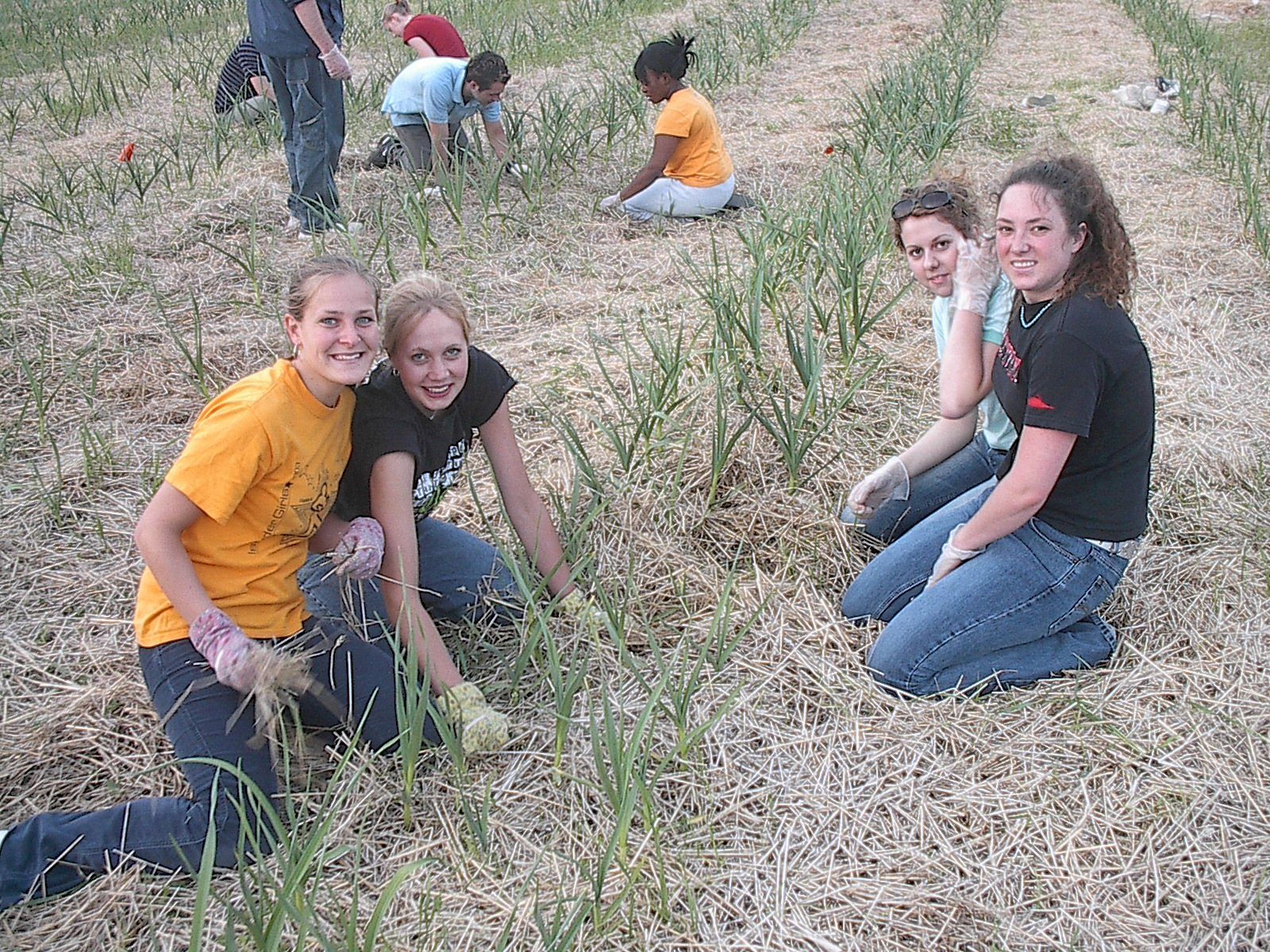 For many years, the Ottawa Ontario Stake members volunteered at Silver Spring Farm, operated by the Ottawa-Carlton Association for Persons with Developmental Disabilities. The stake provided a new tractor, and played a significant role in raising the $20,000 a year profit the farm produced. (Courtesy of Natalia de Savigny and Tom Dalziel)
For many years, the Ottawa Ontario Stake members volunteered at Silver Spring Farm, operated by the Ottawa-Carlton Association for Persons with Developmental Disabilities. The stake provided a new tractor, and played a significant role in raising the $20,000 a year profit the farm produced. (Courtesy of Natalia de Savigny and Tom Dalziel)
M. Russell Ballard is a descendant of Mary Fielding, who was baptized in Toronto by Parley P. Pratt in 1836, and who married Hyrum Smith, the brother of Joseph Smith, in Kirtland. He is also the grandson of Melvin J. Ballard, who visited the Canadian Mission as an Apostle in the 1920s. President Ballard, accompanied by his wife, Barbara, and their family, served in the Canadian Mission from 1974 to 1977. Under his leadership, it was a time of growth and excitement, as baptisms again soared in the mission.
President Ballard worked on the Government of Ontario’s Family Unity Month program and spread the message of family home evening. He and Sister Ballard and their family travelled throughout the mission as an example of what they were teaching—family unity. He gave straight answers. President Karl Jacob of the Temiskaming Branch recalls that President Ballard worked hard to strengthen the branches in northern Ontario and was once visiting his branch when President Jacob rushed out of his office while he was conducting an interview with one of the members of his branch to ask counsel on a very ticklish situation that surfaced during the interview. The answer he got was “You are the judge in Israel.”[170] Larry Merkley, president of the Toronto Ontario Stake from 1975 to 1981, wrote that “his missionaries well know the meaning of the word ‘work’ and what ‘dedication’ [is] all about. His leaders could be depended on to deliver quality in whatever they did.”[171] Before his mission was over, President Ballard was called to the First Quorum of the Seventy, and at that time said that presiding over the Canada Toronto Mission had been “one of the most refining periods of my life.”[172]
On 11 July 1976, President Ballard hosted President N. Eldon Tanner of the First Presidency and Elder Thomas S. Monson in Toronto for the premiere of the film Takin’ Care, produced under the direction of the First Presidency of the Church and with President Ballard’s inspiration. It showed the Church in Canada “from the cowboys of Calgary to the fishermen of Nova Scotia” and crisscrossed “the country to capture the Mormon lifestyle and philosophy.”[173] The evening opened with the singing of the national anthem, and prominent members of the Church in Canada were on the program. They included Jack Armstrong, President and Chief Executive Officer of Imperial Oil; Alexander B. Morrison, Assistant Deputy Minister of the Health Protection Branch of the Department of National Health and Welfare; Randy Bachman, musician and founder of the well-known Bachman Turner Overdrive and Guess Who singing groups; and Diana Lynn MacDonald, Miss Teen Canada in 1974, who had joined the Church “because of the high standards and morals practiced by its members.”[174] Karl Konnry, who had worked in both Canadian TV networks and film production, produced and directed the film. Before being called into the Quorum of the Twelve, President Tanner had been the Minister of Lands and Mines for Alberta, a director of the Toronto Dominion Bank and president of the TransCanada Pipeline.[175]
Elder Ballard and President Monson were beloved shepherds to the members in Ontario. When a stake was created or reorganized, they were often back in Ontario, and when they visited, they spoke to the missionaries. They kept in touch with the members they had worked with. When Elder Ballard heard that President Kenneth Shoesmith of the Hamilton Ontario Stake had cancer, he made sure that he gave him a blessing during his visit.[176] President Monson visited Pat Davies, who was in a nursing home, and his wife, Dorothy, two friends he had worked with when he was mission president;[177] and Olive Davies, widow of William M. Davies, the first president of the Toronto Ontario Stake who had recently died.[178] The two Davies brothers were the ones who first greeted the Monsons when they arrived at the Ossington Chapel in 1959, and Pat and Dorothy lived to see the prediction fulfilled when Elder Monson became President of the Church in 2008.
Youth Leadership Conference
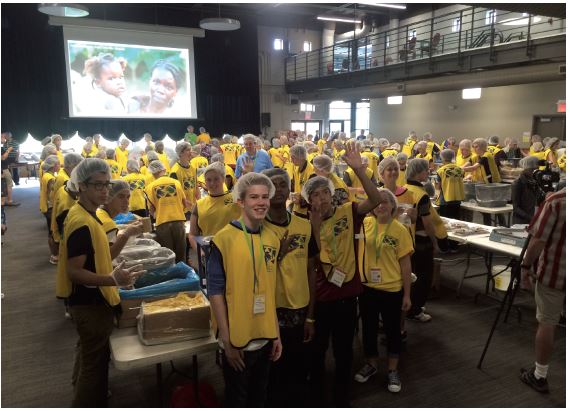 Approximately 700 Latter-day Saint youth from across Ontario attending the annual Youth Leadership Conference joined forces with Feed My Starving Children and local churches in the Kitchener- Waterloo area to prepare 280,000 meals for shipment to children in Haiti in August 2015. General Mills made the project possible with a contribution of $60,000. (Brad Taylor)
Approximately 700 Latter-day Saint youth from across Ontario attending the annual Youth Leadership Conference joined forces with Feed My Starving Children and local churches in the Kitchener- Waterloo area to prepare 280,000 meals for shipment to children in Haiti in August 2015. General Mills made the project possible with a contribution of $60,000. (Brad Taylor)
While Larry Merkley was president of the Toronto Ontario Stake between 1975 and 1981, he felt there was a need to elevate the sights of the youth in his stake and assigned Bradley Miller and Roger Fairbairn to initiate a weeklong Youth Leadership Conference which introduced high standards for attendance and performance. The first year Lynn Scoresby from Brigham Young University and Jayne Malan from the MIA General Board conducted workshops for the 75 youth who attended, and excellence was taught and expected. In subsequent years, other stakes were also invited to send their youth, and the program has strengthened the testimonies of thousands of youth since it started in 1977. During the 2015 conference, 700 youth from Ontario met the attendance standards, and during the conference held at the University of Waterloo, joined volunteers from other churches in preparing 280,000 meals for impoverished children in Haiti in collaboration with the Feed My Starving Children organization. Austin Christensen, age sixteen, of Oakville said, “This project was one of the best things I’ve ever done!”[179]
Priesthood to all Worthy Men
In June, 1978, President Spencer W. Kimball announced that “the time had come when all worthy men and women everywhere can be fellowheirs and partakers of the full blessings of the gospel.”[180] Before that, Walter O. Saunders, a native of Jamaica and a member of the Oakville Ward, said that members would ask him how he felt about not being able to hold the priesthood, and he would tell them, “The time is not yet.”[181] When the announcement was made, he said it was “one of the greatest days in my life. I felt happy and humble.”[182] Bishop John McFadgen came to his home and ordained him a priest, and shortly after, President Merlin Rich, a counselor in the Hamilton Ontario Stake Presidency, ordained him an elder. He says that men cried when he joined them in the quorum.[183] The experience was repeated in wards and branches throughout Ontario as other African Canadians received the priesthood.
 Walter and Tina Saunders in 1980. Walter Saunders, from Jamaica, was the first black man ordained to the Melchizedek priesthood in the Toronto area. He later went on to serve as a counselor in the Toronto Ontario Temple presidency and his wife, Tina, served as assistant to the matron. (Walter Saunders)
Walter and Tina Saunders in 1980. Walter Saunders, from Jamaica, was the first black man ordained to the Melchizedek priesthood in the Toronto area. He later went on to serve as a counselor in the Toronto Ontario Temple presidency and his wife, Tina, served as assistant to the matron. (Walter Saunders)
Expanded Church Programs
The formation of stakes in Ontario set the stage for the introduction of the full program of the Church. On 1 July 1979, Ronald C. Seebach was hired as the first full-time bishops’ storehouse and cannery manager in Toronto, with responsibility for the storehouse, cannery, and distribution of food in the welfare program of the Church for Eastern Canada.[184] A farm was purchased in Jordan Station in the productive Niagara fruit-growing area, and members came from far and near to pick cherries, peaches, pears, and apples under the direction of Gottfried Nabrotzky, the farm manager. Some of the fruit went to members who were able to purchase what they picked at good prices for home canning, and the remainder was sold to canning factories in the area. Families loved picking fruit standing on ladders high in the coolness of the fruit trees and left with their cars filled with baskets of fruit for members of their wards. With the closure of large commercial canning factories in the Niagara area, the market disappeared and the farm was sold on 23 July 2010.[185]
Prior to 1979, counselors came from New Hampshire to help members in need of professional support. In 1980, a Latter-day Saint Social Services (LDSSS) office serving eastern Canada was opened in Toronto with Bryant Barber as practitioner and Ann Margetson as secretary. Stephen ZoBell, from LDSSS in Alberta, arrived in May of that year as the first agency director where he remained until 1986 when Bradley C. Miller was appointed to replace him. In 1995, LDSSS became LDS Family Services.[186]
Area Conference in Toronto
The days of 25–26 August 1979 were historic for the Saints in Ontario and Quebec when President Spencer W. Kimball came to Toronto for Canada’s first area conference, which was held in Maple Leaf Gardens, home of the famous Toronto Maple Leaf hockey team. A 1,000-voice choir, directed by Peterborough’s Hazel McLaren, inspired the 8,260 members who gathered for the conference, and both Elder Monson and Elder Ballard were delighted to be back with the Saints in Ontario. During the prelude music, the congregation spontaneously welcomed President Kimball by singing “We Thank Thee, O God, for a Prophet.” Elder Ballard expressed their feelings when he said, “You probably didn’t see it, President, but many wept tears of joy just to see you.”[187] Elder Monson spoke of the many immigrants who had come to Eastern Canada with “I’m simple enough to believe that you came here to embrace the gospel and be benefitted by its teachings.” President N. Eldon Tanner, Elder James E. Faust, and Elder Charles Didier along with Relief Society General President Barbara B. Smith and Young Women General President Elaine Cannon joined Regional Representative Elden C. Olsen, Regional Representative, President Gérald Pelchat of the Montreal Quebec Stake, and President Harold Crookell of the London Ontario Stake in giving stirring addresses. Simultaneous translation was given in French, Mandarin, Cantonese, Korean, and Spanish. President Kimball expressed his great love and appreciation for the members and gave specific instructions to mothers and fathers and counsel to keep the law of tithing.[188]
After the conference, President Kimball and the official party flew to Ottawa, where they met Canadian Prime Minister Joe Clark, Governor-General Edward R. Schreyer, and Ontario’s Premier William G. Davis and presented them with copies of the triple combination and bound volumes of their family histories. The Prime Minister told President Tanner, “I don’t see how you can get your people to do so much without paying them.”[189]
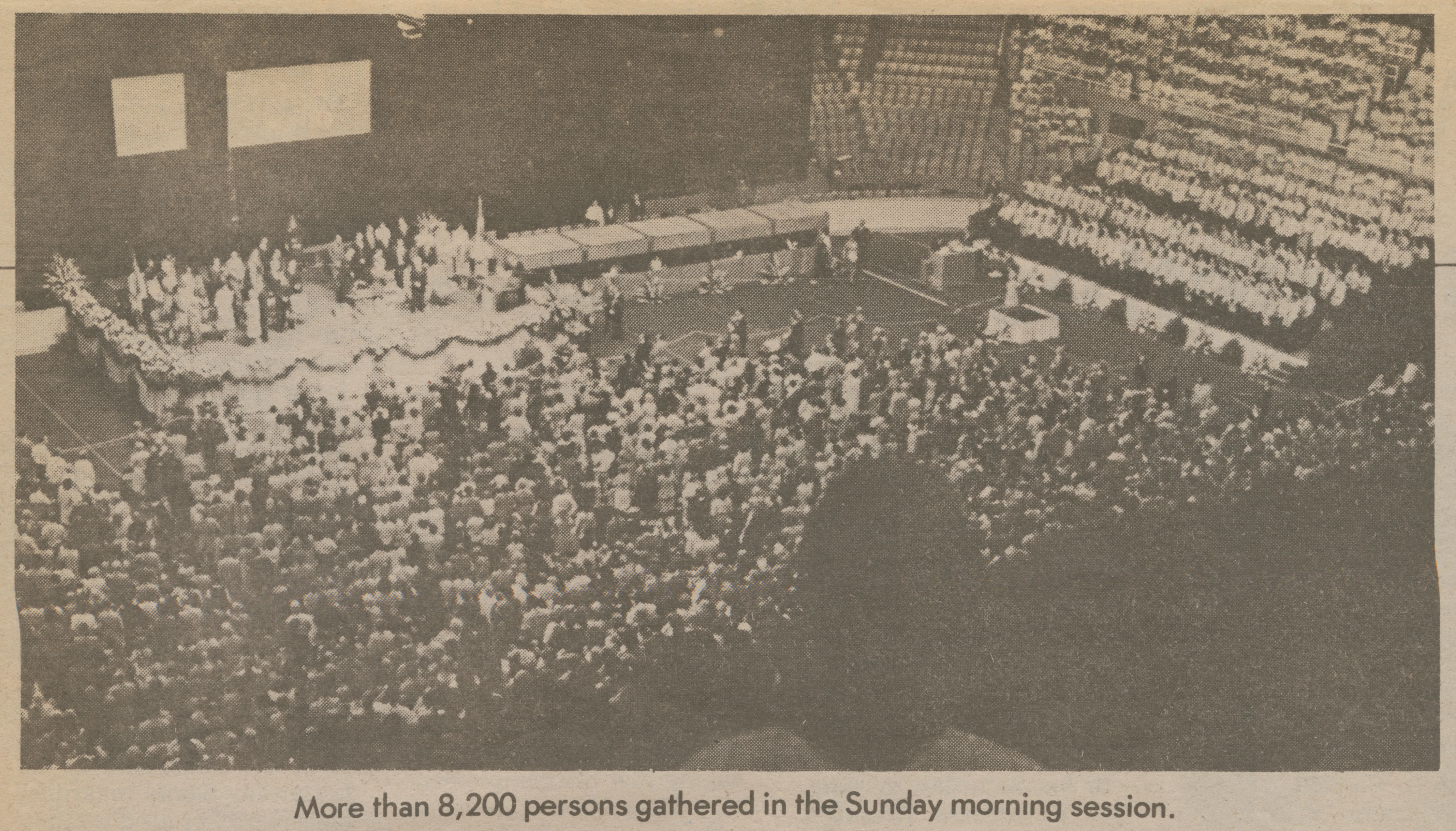 On 26 August 1979, more than 8,200 Saints from Ontario and Quebec assembled in the Maple Leaf Gardens in Toronto to attend an area conference with President Spencer W. Kimball. Seen on the right is a one-thousand-voice choir that performed on the occasion. (John L. Hart, Church News)
On 26 August 1979, more than 8,200 Saints from Ontario and Quebec assembled in the Maple Leaf Gardens in Toronto to attend an area conference with President Spencer W. Kimball. Seen on the right is a one-thousand-voice choir that performed on the occasion. (John L. Hart, Church News)
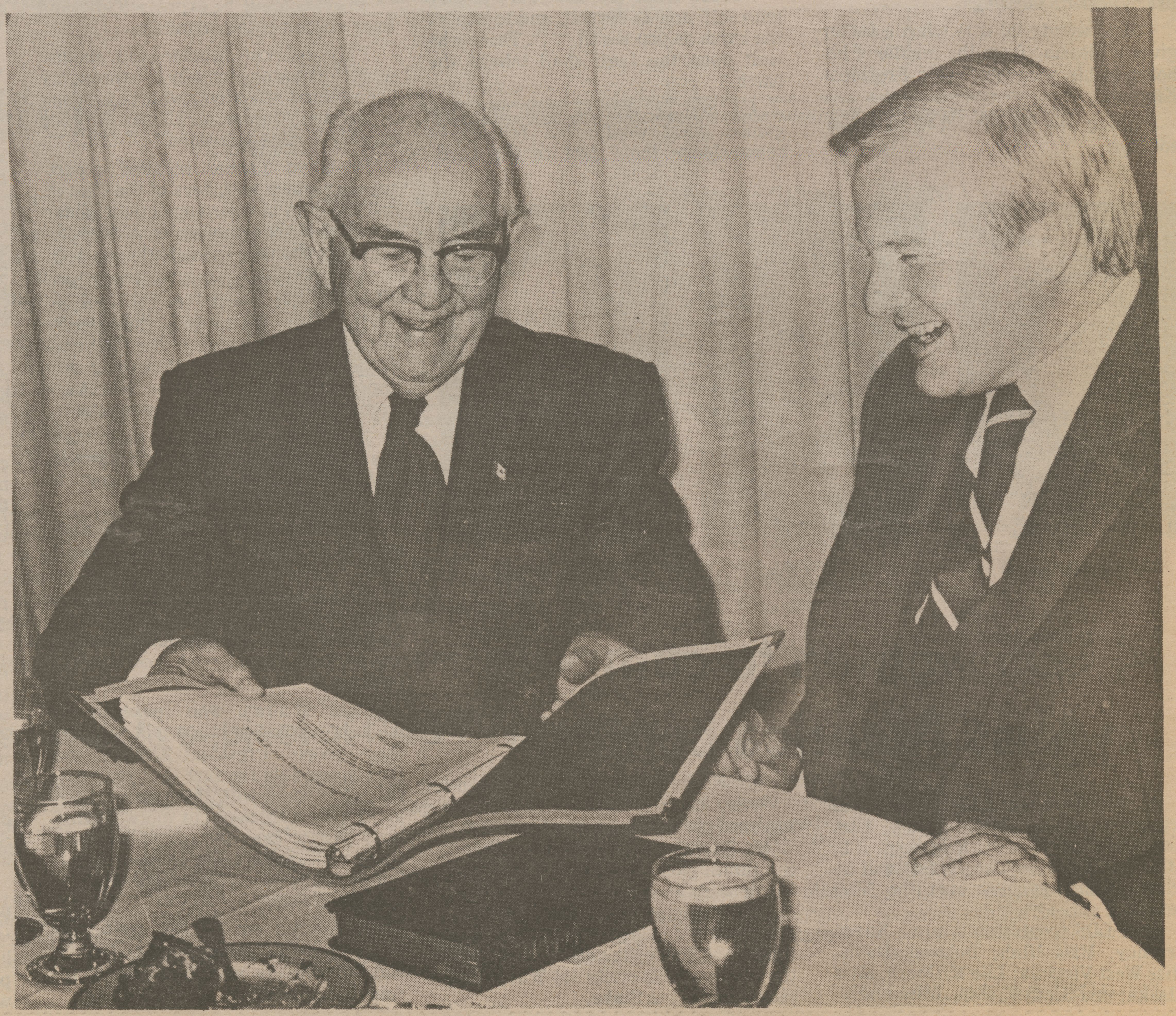 Ontario premier William G. Davis receiving a family history from President Kimball. (John L. Hart, Church News)
Ontario premier William G. Davis receiving a family history from President Kimball. (John L. Hart, Church News)
Growth in the 1980s
Brampton Ontario Stake, 11 January 1981
The Brampton Ontario Stake was created on 11 January 1981 with a realignment of the boundaries of the Toronto Ontario and the Hamilton Ontario stakes by Elder L. Tom Perry of the Quorum of the Twelve. C. Malcolm Warner was called as the first stake president, and in a meeting later that day was released as the president of the Hamilton Ontario Stake, making him the president of two stakes for several hours. The new stake covered a wide area, with ten units and 2,172 members.[190] The stake was composed of three wards—Brampton, Halton Hills, and Kitchener—and seven branches in Barrie, Bracebridge, Cambridge, Guelph, Midland, Orillia, and Owen Sound. Elder Perry told the congregation, “We live in the most exciting time in the history of the earth,” and urged the members of the new stake to follow the prophet.[191] With the Canada Toronto Mission home and mission office in Brampton, and the dedication of the Toronto Ontario Temple in the city in 1990, many members have moved to the area from other parts of Ontario, making the stake one of the strongholds of the Church in Ontario. Since the Brampton Stake Centre was built adjacent to the temple, many regional meetings have been held in the building.
Visit of the Mormon Tabernacle Choir
In 1984, Toronto celebrated its 150th birthday with a monthlong International Festival and invited the Mormon Tabernacle Choir to join the celebration. The choir performed in Maple Leaf Gardens and in Roy Thomson Hall, where the weekly Music and the Spoken Word originated that week. The next day, the choir performed for the first time in Ottawa in the National Arts Centre.[192] At an open house in Brampton before the mayors of both Brampton and Mississauga, Elder Ballard “recalled the influence that Ontario, Canada, had on three great men of the Church, three Presidents: John Taylor, Joseph F. Smith and Joseph Fielding Smith.”[193] When President Ezra Taft Benson was sustained as the new President of the Church the next year with Gordon B. Hinckley and Thomas S. Monson as counselors, members were not surprised at President Monson’s call to this high office.
Leaders of the Church had made friends with Canadian-born Lord Roy Thomson of Fleet, who was head of the world’s largest publishing empire at that time. Lord Thomson, who lived in London, England, and his son, Kenneth, of Toronto, had been guests of President Harold B. Lee in Salt Lake City. Lord Thomson hosted a luncheon for President Lee in 1973 in London.[194] The friendship between the Thomson family and leaders of the Church continued for many years. On 21 July 1992, at a luncheon before a performance at Toronto’s Roy Thomson Hall, Kenneth Thomson (he used his title only in England) gave President Gordon B. Hinckley a marble statue of a polar bear, saying that it depicted the courage and stamina of the Mormon people.[195]
Changes in Canadian and Ontario Law
General Authorities visiting Ontario often commented on the scrupulous keeping of the Sabbath by its citizens. The Lord’s Day Act made it a criminal offence to transact business on Sunday in Canada, and churches were the place to be Sunday mornings. In 1985, the Supreme Court of Canada struck down the Lord’s Day Act on the grounds that it contravened the freedom of religion and conscience provision in the Canadian Charter of Rights and Freedoms, which had come into effect in 1982.[196] With the striking down of the law, the parking lots of supermarkets and malls became busy on Sundays, and churches lost parishioners. In the ensuing years, many churches were closed and their land sold for commercial purposes.[197]
In 1988, the Ontario Court of Appeal ruled that the use of the Lord’s Prayer in opening exercises in public schools also offended the charter. Along with reciting the Lord’s Prayer each morning, reading the Bible and memorizing Bible passages had been a common practice in Ontario schools for generations. Both of these rulings would have long-term and far-reaching effects on missionary work in Ontario as the population became less religious and less knowledgeable about the teachings of Christ. At the same time, immigrants to Ontario brought their fervent faith practices with them and Sikh, Hindu, Buddhist, Muslim, and Zoroastrian places of worship changed the religious complexion of the province. While Christian-focused teaching diminished in Ontario, Latter-day Saint youth were taught and strengthened by seminary and institute programs already in place and annual youth leadership conferences and Boy Scout and Young Women camps.
A Temple Announced for Toronto
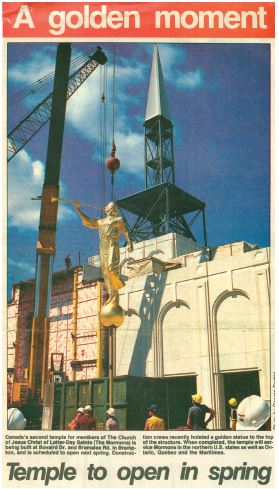 The Brampton Guardian followed the progress of the temple building, and on the day the Angel Moroni was hoisted to its place on the steeple, a front-page photo captioned, “A golden moment” celebrated the event.[203] (Brampton Guardian)
The Brampton Guardian followed the progress of the temple building, and on the day the Angel Moroni was hoisted to its place on the steeple, a front-page photo captioned, “A golden moment” celebrated the event.[203] (Brampton Guardian)
Over the years, members asked visiting General Authorities when they would get a temple in Toronto. The usual reply was a membership figure many times over what they currently had, and they kept praying and asking. The good news came at April conference in 1984. Brampton Ontario stake president, C. Malcolm Warner, was in a meeting prior to general conference in Salt Lake City when the stake presidents were told that a temple in Toronto would be announced at the next session of conference. He was given permission to share the news with priesthood leaders in his stake. Hearing the message, Bishop Rene Seaborn of the Kitchener Ward shouted “Hallelujah!” into the phone at the top of his voice. Others wept and couldn’t speak. Everett Pallin was listening to general conference in the Etobicoke Chapel when the temple was announced. He records that “the normal reverence exhibited by the Saints was replaced by an instantaneous shout of joy and excitement. . . . We were momentarily out of control, being completely overcome by the impact of the message. Tears of happiness and appreciation were shed, and it took us a few minutes to regain control and focus our attention back to the conference proceedings.”[199] The Saints in Ontario would have a temple at last.
The mayors of Brampton and Mississauga, cities north and west of Toronto, each encouraged Church leaders to build the temple in their community. Physical facilities manager, Errol King, looked for properties, and President Warner was asked to take President Gordon B. Hinckley to view the sites that were being considered. When the location at the corner of Bovaird Avenue and Bramalea Road in Brampton was announced by Elder Thomas S. Monson, it was greeted with cheers at a multistake conference held in the Etobicoke Centennial Arena on 22 June 1986.
Kitchener Ontario Stake – 22 June, 1986
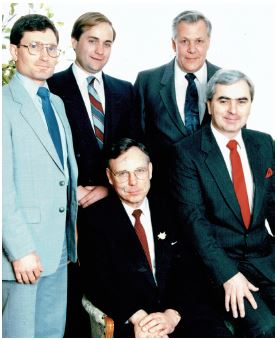 The first stake presidency of the Kitchener Ontario Stake, 22 June 1986: seated, Stake President Graeme Hingston and Donald Wright (first counselor); standing from left, Bruce Williamson, James McBride (second counselor) and Hank Waanders. (Elsie Hingston)
The first stake presidency of the Kitchener Ontario Stake, 22 June 1986: seated, Stake President Graeme Hingston and Donald Wright (first counselor); standing from left, Bruce Williamson, James McBride (second counselor) and Hank Waanders. (Elsie Hingston)
At the same conference, the Kitchener Ontario Stake, the 160th stake of the Church, was created under the direction of President Thomas S. Monson, Elder M. Russell Ballard, and Regional Representative Alexander B. Morrison. The stake was formed from parts of the Hamilton, Brampton, and London Stakes, with wards in Kitchener, Cambridge, Brantford, Guelph, and Owen Sound and branches in Stratford, Woodstock, and Walkerton. New Zealander Graeme K. Hingston was called as the first stake president. A gifted speaker, President Hingston urged the members in all of his stake conference addresses to follow Proverbs 3:5–6: “Trust in the Lord with all thine heart; and lean not unto thine own understanding. In all thy ways acknowledge him, and he shall direct thy paths.”
From the time of the announcement of the temple until the dedication, several General Authorities acted as chairmen of the temple committee, including Elders Rex C. Reeve, Loren C. Dunn, John K. Carmack, F. Burton Howard and F. Enzio Busche.” Next sentence add C. before Malcolm to read, In the summer of 1987, C. Malcolm Warner, then serving as a regional representative of the Twelve, was appointed as vice-chairman of the open house committee.[200]
At the groundbreaking ceremony for the temple, on a cold, cloudy October day in 1987, President Thomas S. Monson, now of the First Presidency, and Elder M. Russell Ballard of the Quorum of the Twelve, and their wives, Elder John K. Carmack of the First Quorum of the Seventy, local regional representatives, and stake presidents were joined by almost 3,000 Saints and local dignitaries. Occasional shafts of sunlight broke through the clouds as the meeting progressed. President Monson spoke of the sunlight, saying, “The Lord has sent forth His approval, this beaming ray of sunshine, to mark this historic day.” At that moment, the sunlight broke through the clouds, and the remainder of the meeting was bathed in sunshine.[201]
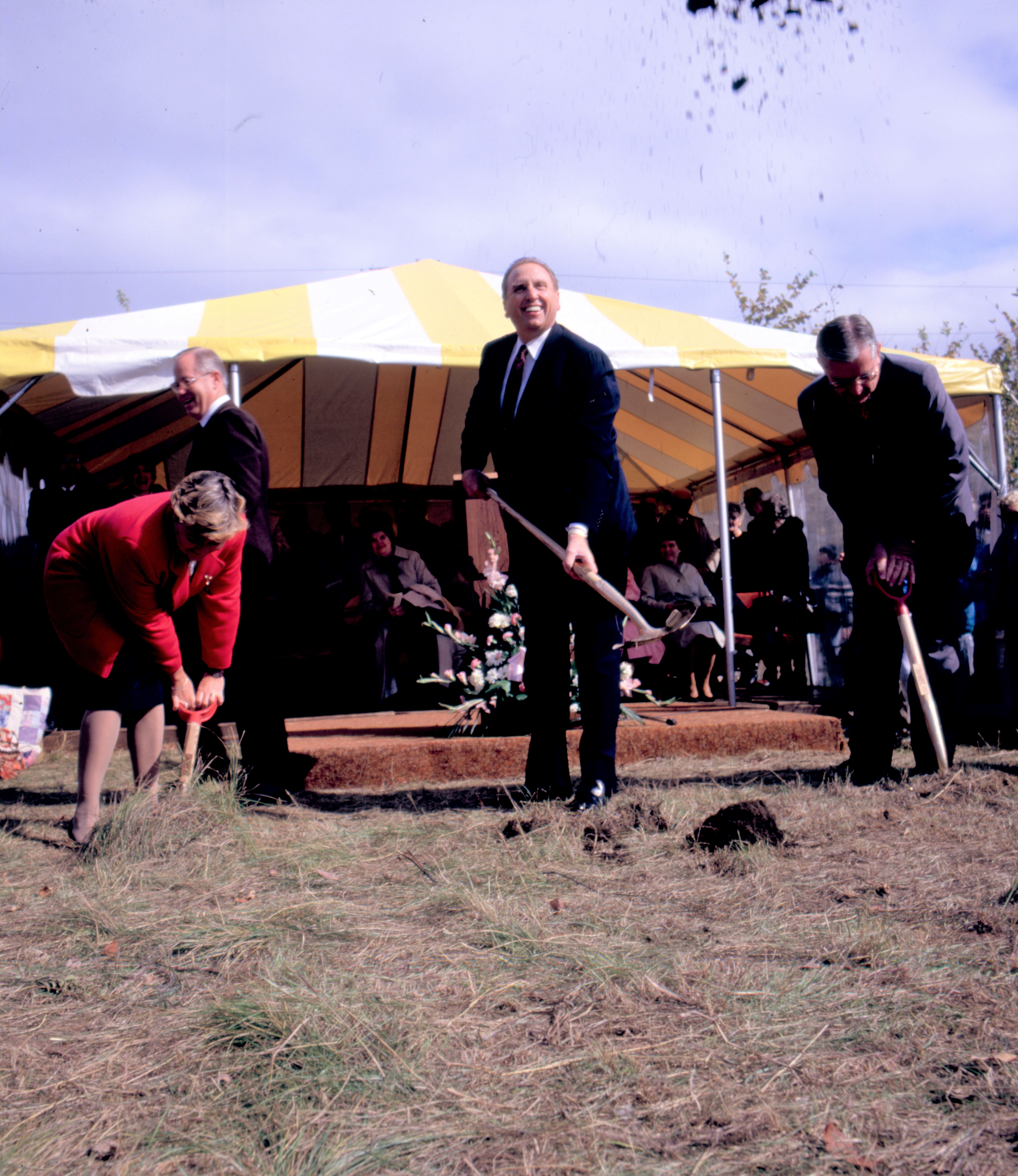 President Thomas S. Monson throws a shovelful of earth in the air at the groundbreaking of the Toronto Ontario Temple.[202] (Warren Mark Staff)
President Thomas S. Monson throws a shovelful of earth in the air at the groundbreaking of the Toronto Ontario Temple.[202] (Warren Mark Staff)
A strike of construction workers caused concern that the temple would not be completed in time for the dedication, and contractors and unions gave permission for qualified members of the Church to work under the direction of Jerry Sears, the project manager, to complete jobs such as mechanical work for the air conditioning and wiring and hanging chandeliers. Everett Pallin, who had served as a counselor to President Monson when he was mission president and who became the temple president in 1999, spent hours working with his son John, who later became a counselor in the temple presidency and in 2016 president of the temple, to assemble and hang the chandelier in the celestial room of the temple.[204] Relief Societies made thousands of terrycloth slippers to go over the shoes of all visitors to protect the carpets.[205]
Special tours were held for dignitaries prior to the general open house. Elder M. Russell Ballard and Elder F. Enzio Busche took Lord and Lady Kenneth Thomson, through the temple on a private tour. The next day, 540 invited guests toured the temple with the two General Authorities.
At the public open house from 2–18 August 1990, a front-page story in the Brampton Guardian encouraged visitors to attend with a “Temple tours talk of town” headline. One of the visitors quoted in the article was Boyd McGinn, whose father, Doug, had been one of the pioneers of the Church in Timmins. He said that when he entered the temple, an overwhelming feeling hit him. “The finishing in the building was unbelievable. You don’t see work like that today. But the feeling was most profound.”[206]
Almost 62,000 people toured the temple during the open house, and visitors gave many expressions of thanks for the beauty and spirit of peace they felt. One woman wrote, “I have been so impressed with your building and the message. How can I join your church?”[207] Although a group of protesters set up a display outside the entrance to the property protesting the Church and the temple, visitors to the new temple indignantly told the dissenters that Latter-day Saints had every right to worship in their temple.
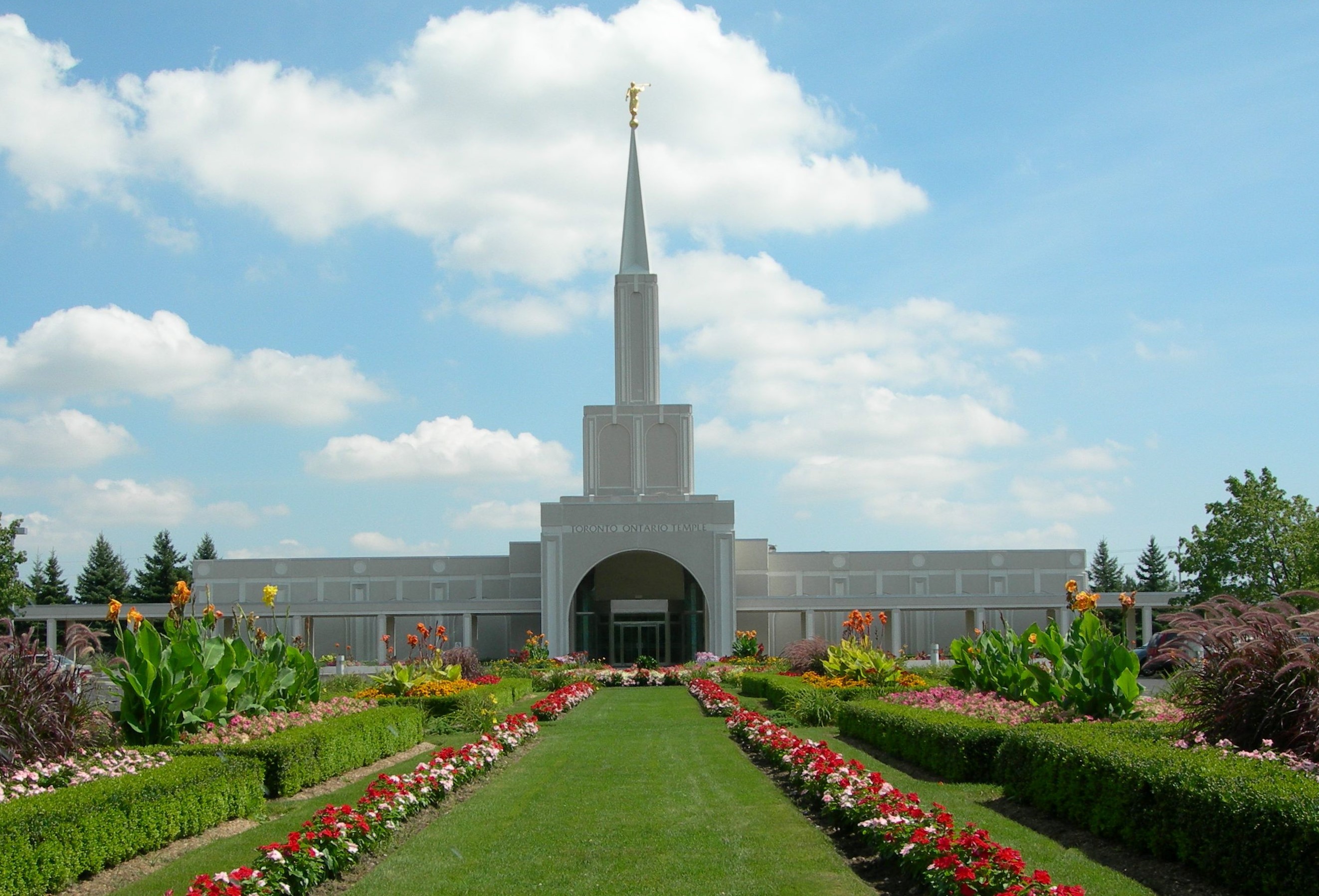 The dedication of the Toronto Ontario Temple in August 1990, by President Gordon B. Hinckley, was a great spiritual experience for those who attended. No longer would members of the Church have to drive several hundred kilometres to Washington, DC to receive the blessings of the temple. The beauty of the well-kept gardens and grounds has attracted widespread admiration. (Elena Figuracion)
The dedication of the Toronto Ontario Temple in August 1990, by President Gordon B. Hinckley, was a great spiritual experience for those who attended. No longer would members of the Church have to drive several hundred kilometres to Washington, DC to receive the blessings of the temple. The beauty of the well-kept gardens and grounds has attracted widespread admiration. (Elena Figuracion)
The first temple presidency and their wives were all stalwarts of the Church. Arnold Roberts, who had been a leader of the Church in Ottawa, was called as the first temple president with Hans Peets from Montreal, and Gordon Finnigan from Timmins and Brampton, as counselors. Their wives—Elsa Peets and Ethel Finnigan—were assistants to Audrey Roberts, the first matron. The temple district initially included thirty-two stakes covering most of Ontario and the provinces of Quebec, Nova Scotia, New Brunswick, Prince Edward Island, and Newfoundland in Canada, and parts of Michigan, Ohio, New York, Vermont, and Pennsylvania in the United States.
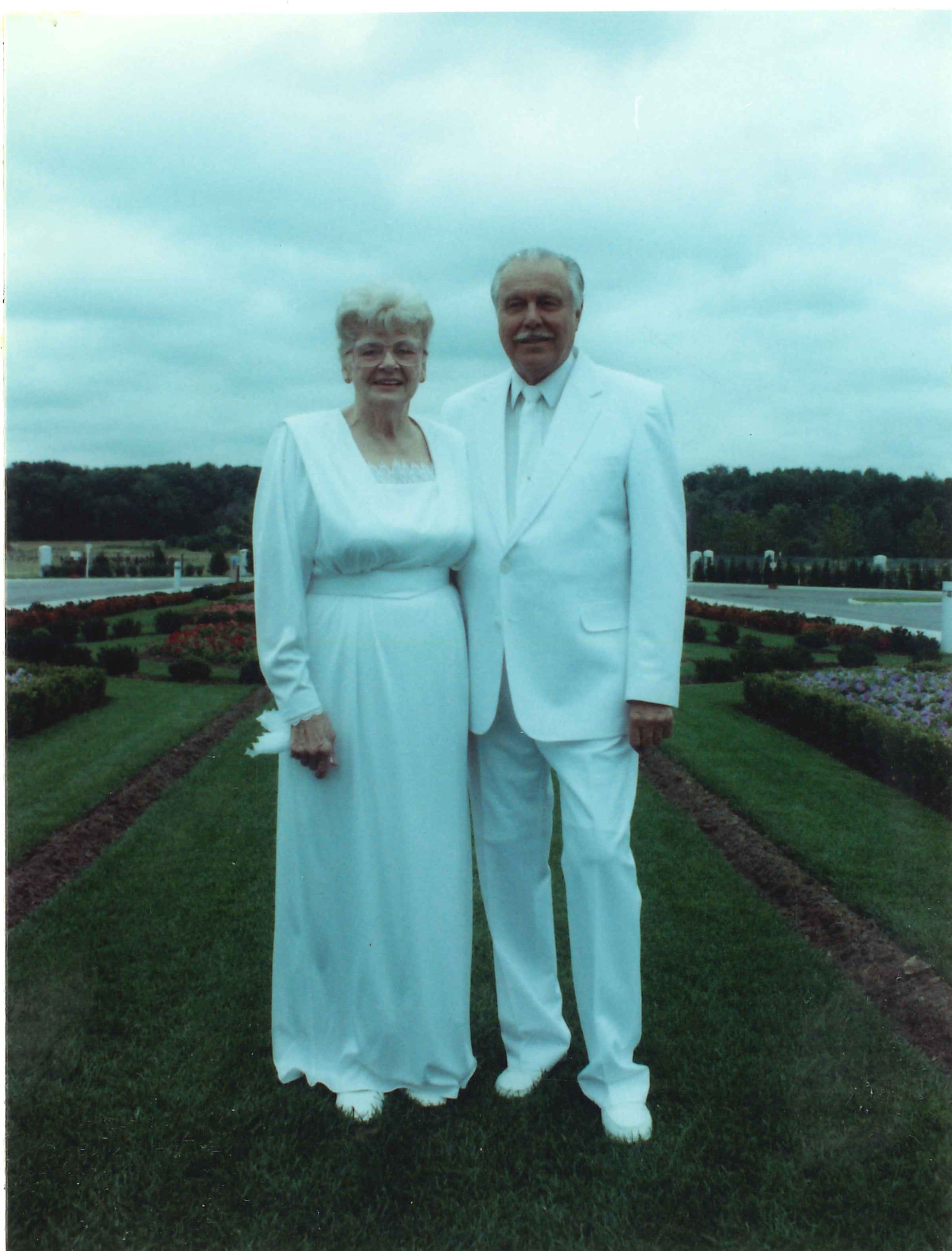 Arnold Roberts was the first president of the Toronto Ontario Temple, and his wife, Audrey, was the first temple matron. President Roberts had a thirty-year career in the Canadian military and retired as a lieutenant colonel. He served as mission president of the Indiana/
Arnold Roberts was the first president of the Toronto Ontario Temple, and his wife, Audrey, was the first temple matron. President Roberts had a thirty-year career in the Canadian military and retired as a lieutenant colonel. He served as mission president of the Indiana/
The Toronto Ontario Temple was the forty-four temple of the Church, and there were eleven dedicatory sessions during 25–27August 1990 with close to 17,000 in attendance. Every room in the temple was filled with chairs and had a television monitor so everyone could experience the dedication. The dedicatory prayer was prepared under the instruction of President Ezra Taft Benson, who was not well enough to attend, and it was read by President Gordon B. Hinckley, whose great-grandmother Lois Judd and grandfather Ira Nathaniel Hinckley were both born in Ontario. The dedicatory prayer was published in its entirety in the Church News and said, in part:
We thank Thee for this day when we dedicate Thy holy house. Its construction has been made possible by the consecrations of Thy faithful Saints. Bless them, Father, and open the windows of heaven and shower down blessings upon them, both spiritual and temporal.
We thank Thee, Father, for this good land, where stands Thy house—this great nation of Canada whose people enjoy the blessings of liberty and peace, with full freedom to worship Thee according to Thy revealed pattern. We are mindful that the Prophet Joseph Smith walked in this area and bore testimony of the gifts, the knowledge, and the authority received from Thee in opening this, the Dispensation of the Fulness of Times.
This nation has become a gathering place for people from scores of other lands. In their veins flows the blood of Israel. Many have hearkened to the testimony of Thy servants and have been favoured with a knowledge of the principles and ordinances of Thine everlasting gospel. May their numbers increase and may Thy holy work grow in strength here and across the world.[209]
Immediately after the last dedicatory session, a crew of hundreds removed chairs, vacuumed, dusted, waxed and polished every inch of the temple. They expected to work through the night, but all was completed by early evening when President Monson came to inspect the temple before the first endowment session the next morning, 28 August 1990. Later that evening, as David Finlayson, a carpenter from the Oshawa Stake, walked through the completed temple with its exquisite wood trim, he said, “Christ will love walking through this temple.” When he was asked why he thought that, he replied, “He was a carpenter. He knows good wood.”[210]
The temple not only brought blessings to the members, but also became a blessing to the City of Brampton as well. Visitors often came to the temple grounds and sat on the benches beside the fountains. In spite of being situated at a busy intersection, it is a place of peace and refuge. In 2003, the City of Brampton Parks Department asked that the outstanding temple gardens created by temple gardener, Owen MacLean, be part of the city’s submission to Communities in Bloom,[211] an international garden competition. For several years, judges toured the temple gardens, and the gardens became one of five listed among the city’s tourist attractions. In 2005, the city won the prestigious Communities in Bloom International Award, and the temple leaders were honoured in appreciation for their participation. The mayor said she brought visiting dignitaries to see the gardens.[212] For many years, the City of Brampton brought busloads of newcomers to the city to tour the gardens.
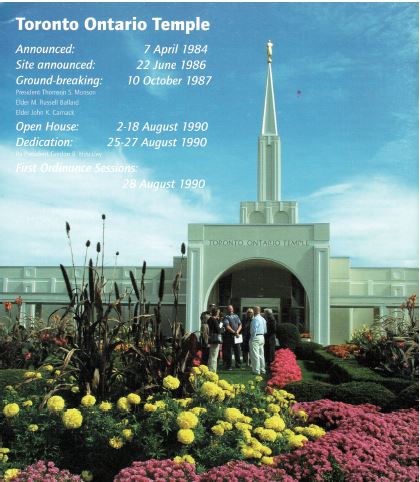 Judges for Communities in Bloom review the grounds of the Toronto Ontario Temple. (John Farrington)
Judges for Communities in Bloom review the grounds of the Toronto Ontario Temple. (John Farrington)
Continued Growth and Development, 1990–2016
The Canada Toronto Mission was divided on 1 July 1993, and became the Canada Toronto East Mission and the Canada Toronto West Mission.[213] It should be noted that several mission presidents who presided in these missions and its predecessor, had served their first missions in Ontario years before. Presidents Carl W. Bacon, John W. Hardy, Paul R. Sampson, Brent H. Satterthwaite, Stephen M. Hadley, John D. Hart, Paul K. Sybrowsky, G. Ward Taylor, and Bradford J. Brower all returned to their former mission field, and those they taught and baptized on their missions welcomed them back. Sister Tamara Brower, the daughter of M. Russell and Barbara Ballard, had lived in the mission home when her father presided over the mission and had attended high school in Brampton, and now returned to serve with her husband. President Brent Scott, a descendant of early Ontario pioneers who were baptized in the Churchville area in the 1830s, could even visit the home his ancestors had built.
Mississauga Ontario Stake – 18 October 1992
The Mississauga Ontario Stake was created by Elder Rex D. Pinegar on 18 October 1992, with Lawrence R. Fuller as stake president. The Etobicoke Chapel, which had been built as the Toronto Stake Centre, became the new stake centre, with wards in Etobicoke, Weston, Mississauga, Oakville, and Black Creek. When Elder Henry B. Eyring spoke at their September 2002 stake conference, he promised, “The Lord’s hand is upon this area. . . . There will be miracles performed here.”[214]
Sudbury Ontario Stake – 5 May 1996
President Thomas S. Monson and Elder M. Russell Ballard returned to Ontario for the creation of the Sudbury Ontario Stake on 5 May 1996. The conference program recounted that the first recorded missionary activity in the area was in Bracebridge in about 1911, when an Elder Van Dyke visited the McCurby family. The new president was G. Boyd McGinn, son of Douglas McGinn who had served as district president in Timmins. In the new stake, Sudbury, Timmins, and North Bay Branches from the Northland District became wards, the Bracebridge Ward was moved from the Brampton Stake, and the Sault Ste. Marie Branch was moved from the Marquette Michigan District of the Wisconsin Milwaukee Mission, and made a ward. The Sault Ste. Marie Ward included Sault Ste. Marie, Michigan, so missionaries serving there proselyted in the United States as well.[215]
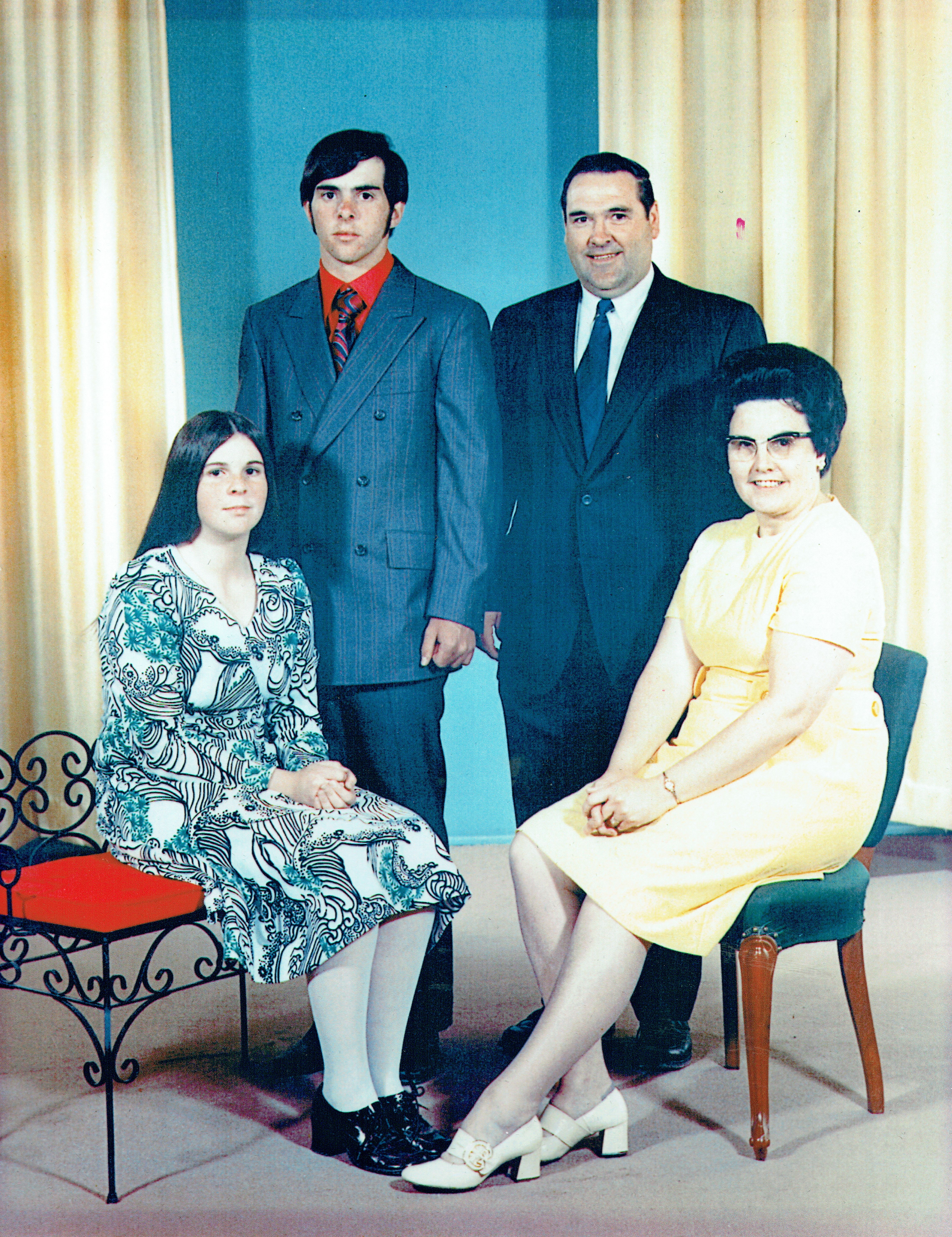 The Douglas McGinn family. Douglas McGinn served as first president of the Timmins District. After he retired, he and his wife, Joan, served eight missions including one at the Washington D.C. Temple and another at the Toronto Temple. Their son, G. Boyd McGinn, was the first president of the Sudbury Ontario Stake, and was later called as a mission president in Peru. Their daughter, Mary, married Stuart Finnigan, son of Gordon and Ethel Finnigan, other great leaders in Northern Ontario and Toronto. (Douglas McGinn)
The Douglas McGinn family. Douglas McGinn served as first president of the Timmins District. After he retired, he and his wife, Joan, served eight missions including one at the Washington D.C. Temple and another at the Toronto Temple. Their son, G. Boyd McGinn, was the first president of the Sudbury Ontario Stake, and was later called as a mission president in Peru. Their daughter, Mary, married Stuart Finnigan, son of Gordon and Ethel Finnigan, other great leaders in Northern Ontario and Toronto. (Douglas McGinn)
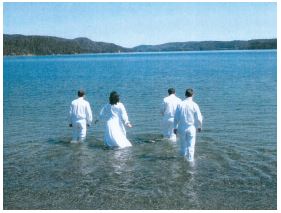 In Wawa, two missionaries and a young woman wade out into the beautiful but cold waters of Lake Superior for a baptism. (Toronto Ontario Mission History)
In Wawa, two missionaries and a young woman wade out into the beautiful but cold waters of Lake Superior for a baptism. (Toronto Ontario Mission History)
At President Howard W. Hunter’s death in 1995, Gordon B. Hinckley became President of the Church, and President Monson was called as his first counselor. In August 1998, President Hinckley went on a Canadian tour and visited six provinces. On 5 August, he came to Ontario and met with members of the Sudbury Stake at Laurentian University, and on 8 August, twelve thousand Saints gathered to hear him speak at the Copps Coliseum in Hamilton in what was reported to be the largest meeting of members of the Church ever held in Ontario.[216]
Before a conference in Ottawa, President Hinckley was presented with a history of his family in Ontario, which was prepared by President Bruce Wilson, a counselor in the Ottawa Stake presidency, and his wife, Ruth. President Hinckley asked if he could visit the family burial site of his Ontario ancestors the next morning before proceeding to Montreal. The farm, in which the cemetery was located, had belonged to Arza Judd Sr., his second-great-grandfather, and is located near the hamlet of Chantry, Ontario (south of Smiths Falls). None of the graves had lettering that was readable, but it was presumed that President Hinckley’s great-grandfather Erastus Nathaniel Hinckley, who died of smallpox in 1831, was buried at the site. His widow, Lois Judd, and her sons, including Ira Nathaniel Hinckley, later joined the Church and went west with the Saints.[217]
President Hinckley said of the event, “Three days ago, I stood at what we presume to be (my great-grandfather’s) grave in that part of the country. I walked out through a cow pasture to get to it, to find it. It is a little fenced-in cemetery there, and I had a thousand feelings of reverence and respect and gratitude and thanksgiving.”[218]
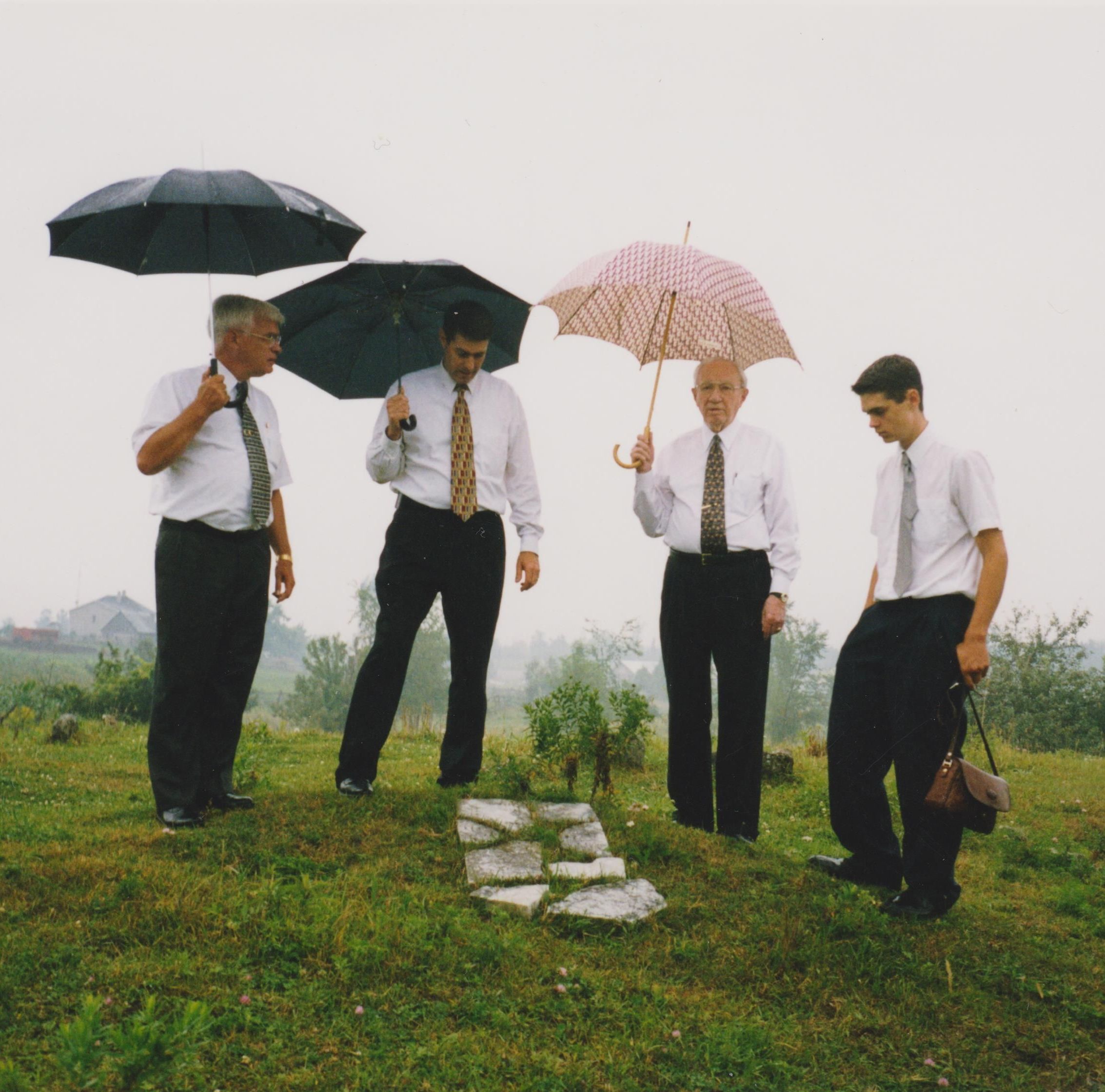 President Gordon B. Hinckley visiting the presumed gravesite of his great-grandfather, Erastus Nathaniel Hinckley, near Chantry, Ontario. Left to right: Gary M. McRae, counselor in the Ottawa Stake presidency; Ottawa Stake President Gordon de Savigny; President Hinckley; Stefan de Savigny, Gordon’s son. (Gordon de Savigny)
President Gordon B. Hinckley visiting the presumed gravesite of his great-grandfather, Erastus Nathaniel Hinckley, near Chantry, Ontario. Left to right: Gary M. McRae, counselor in the Ottawa Stake presidency; Ottawa Stake President Gordon de Savigny; President Hinckley; Stefan de Savigny, Gordon’s son. (Gordon de Savigny)
The Kingston Ontario District—1996
The Trenton Ontario District was formed in 1996, from units of the Oshawa and Ottawa stakes, with branches in Trenton, Belleville, Kingston, Napanee, Campbellford and Bancroft, and was part of the Canada Toronto East Mission. The Trenton District became the Kingston District in 2000, with the addition of the Smiths Falls and Trenton Branches.[219]
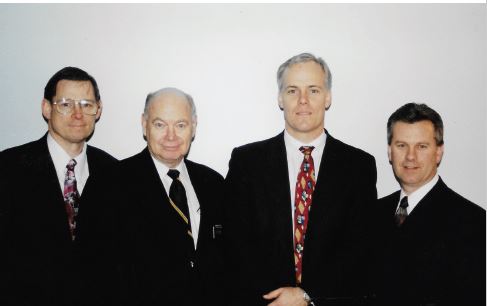 President Steven M. Hadley, president of the Toronto East Mission (second from left) with the Trenton District presidency, about 1998. In the district presidency, Left to right; A. Michael Shumate, first counselor; Daren K. Heyland, president (third left); Joseph E. Davis, second counselor. (Shirley Hadley)
President Steven M. Hadley, president of the Toronto East Mission (second from left) with the Trenton District presidency, about 1998. In the district presidency, Left to right; A. Michael Shumate, first counselor; Daren K. Heyland, president (third left); Joseph E. Davis, second counselor. (Shirley Hadley)
In 1997, when the Church celebrated the sesquicentennial of the arrival of the Mormon pioneers in Utah in 1847, the Kingston District sponsored events to commemorate the first preaching of the gospel outside United States in the Kingston area in 1832. President Thomas S Monson, accompanied by his wife, Frances, dedicated a historic marker for that purpose in the village of Bath, Ontario. The day included a parade with five hundred participants; Scott Fraser, a Latter-day Saint town crier; a Pioneer Brass Band; a bagpiper; handcarts; missionaries carrying a giant Canadian flag; and floats portraying Church history. President Monson said, “The honour that we pay those pioneers is going to include all the pioneers who have lived in this land, some who are members of the Church and some who aren’t. We recognize we’re part of a great community, and there is room for every person’s faith and every person’s service, wherever that might be given. I believe that we have seen in our lifetime a great movement toward an understanding that we’re all God’s children, whatever our colour, whatever our faith, whatever our background.”[220] Paul Gilmore, reeve of the Township of Ernestown, told the gathering, “You folks are a credit to your communities, wherever you live. You are solid citizens.”[221]
Lest We Forget
In 1999, Copps Coliseum in Hamilton was the scene of a Toronto Regional Conference, with President and Sister Monson and 8,000 Saints in attendance. After thanking the sisters who made the lunch for the leaders, President Monson turned to the brethren and said, “Be careful lest you make a woman cry, for God counts the tears.”[222]
President and Sister Monson were back in Ontario on 29 August 2000 for the fortieth anniversary of the formation of the Toronto Ontario Stake. A Church News article stated that when he arrived as the mission president in 1959 there were six districts, fifty-five branches and just over 5,000 members in Ontario and Quebec and that there were now eleven stakes, 119 wards and branches, three missions and 48,789 members.[223] While he was in Ontario, President Monson participated in the dedication of a historic marker honouring the contributions of early missionaries and members, and met with the missionaries of both Canada Toronto Missions. The marker was placed near the entrance of the Black Creek Ward chapel, on Jane Street in Toronto, which is located near the site of some of the first baptisms of the Church in Canada in 1836.[224]
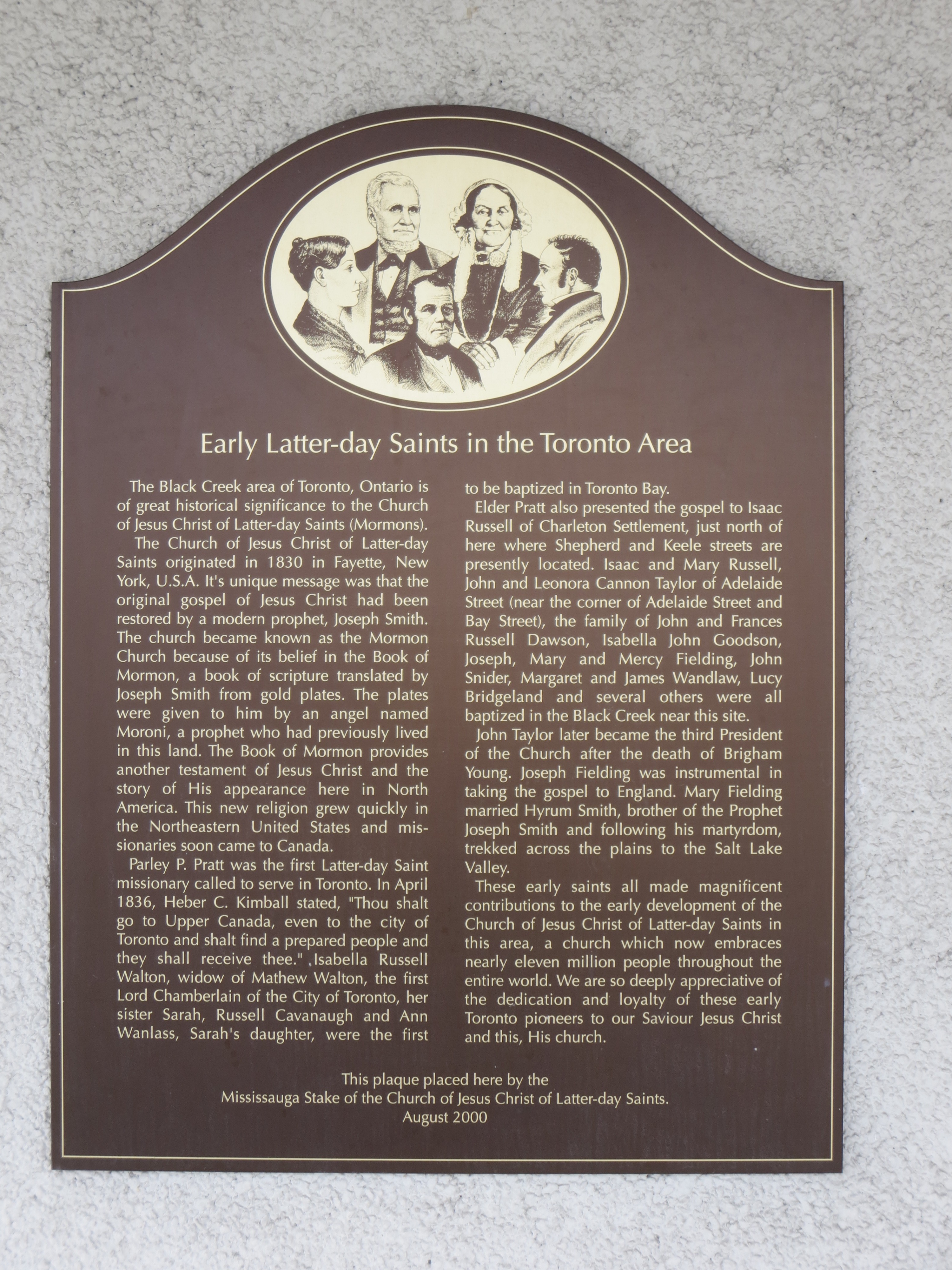 Thomas S. Monson dedicated an historical marker at the Black Creek Ward meetinghouse in 2000, near the site of the first baptisms in the Toronto area in 1836. (Malcolm Warner)
Thomas S. Monson dedicated an historical marker at the Black Creek Ward meetinghouse in 2000, near the site of the first baptisms in the Toronto area in 1836. (Malcolm Warner)
Saints in Ontario were delighted to welcome Thomas S. Monson of the First Presidency and M. Russell Ballard of the Quorum of the Twelve at a regional conference in May 2004, which was broadcast from Brampton to meetinghouses in Ontario, Quebec, and the Atlantic provinces via satellite transmission.[225] In March 2010, Elder Ballard, accompanied by Elder L. Whitney Clayton of the Presidency of the Seventy, returned to Toronto to speak at a regional priesthood leadership meeting and also spoke at a fireside in Brampton, attended by more than seven hundred young single adults.[226]
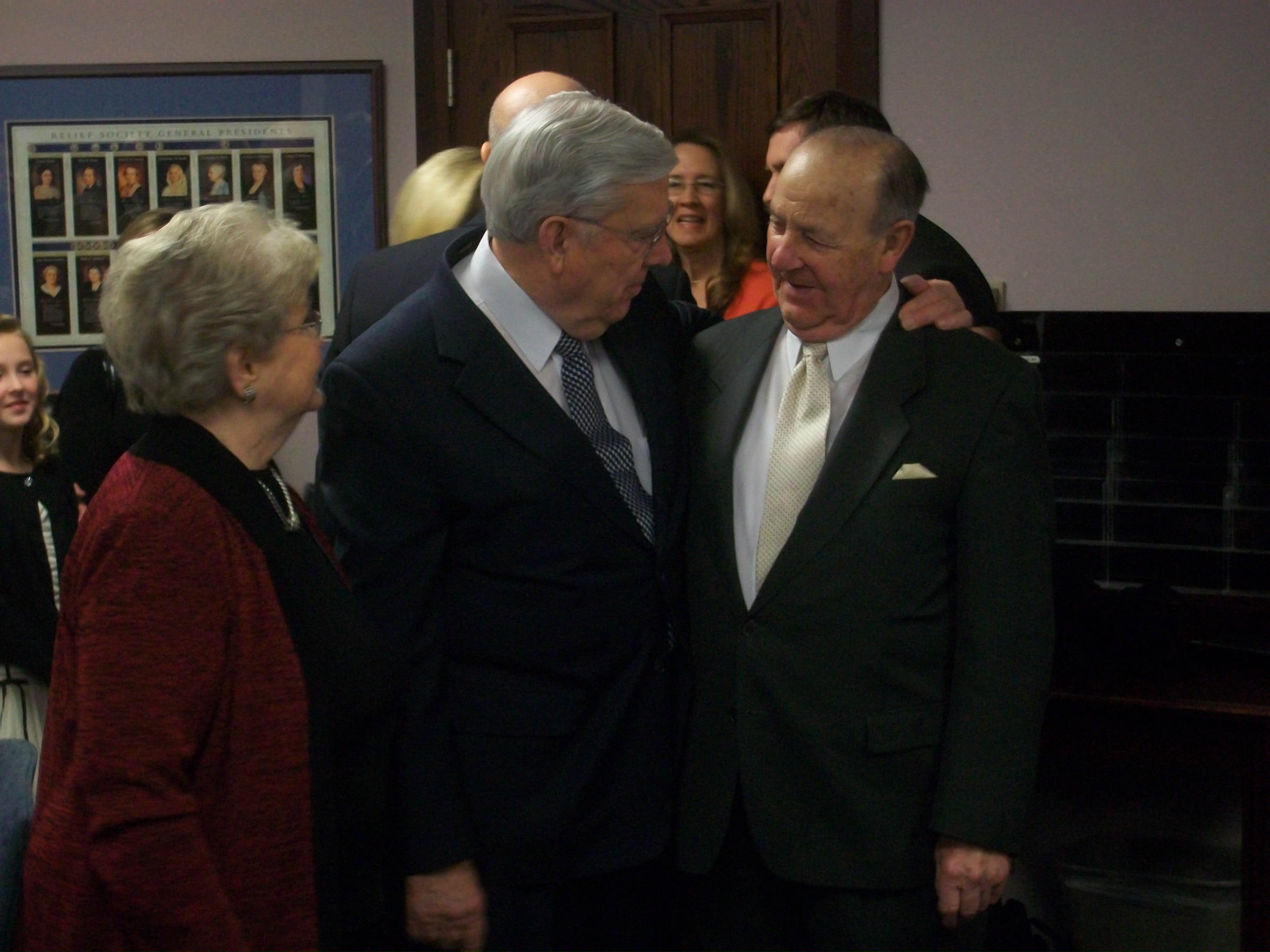 Left to right: Sister Barbara Ballard and Elder M. Russell Ballard of the Quorum of the Twelve greeting Joseph Willmott, former president of the Toronto Ontario Temple. On the evening of 5 March 2010, the Ballards dined with cherished friends they had made while Elder Ballard was mission president in Toronto (1974–76).[227] (Michael Clifton)
Left to right: Sister Barbara Ballard and Elder M. Russell Ballard of the Quorum of the Twelve greeting Joseph Willmott, former president of the Toronto Ontario Temple. On the evening of 5 March 2010, the Ballards dined with cherished friends they had made while Elder Ballard was mission president in Toronto (1974–76).[227] (Michael Clifton)
Expansion of Welfare Services
In 2002, a welfare facility was built in Toronto which served members west to Niagara, east to Cobourg, and north to Orillia and Barrie. A pamphlet distributed at the opening celebration said the facility “captured under one roof the four areas where members can learn how to become self-sufficient.” It included a home storage area for dry pack canning, LDS Family Services, an Employment Resource Services Centre to assist those looking for work or hoping to upgrade, and a bishops’ storehouse—called a “supermarket without a till” which provided food for needy families. When it opened, it was the only building of its kind in Canada. “Dry pack canning is no longer done on site, but can be purchased already packaged at the Home Storage Centre.
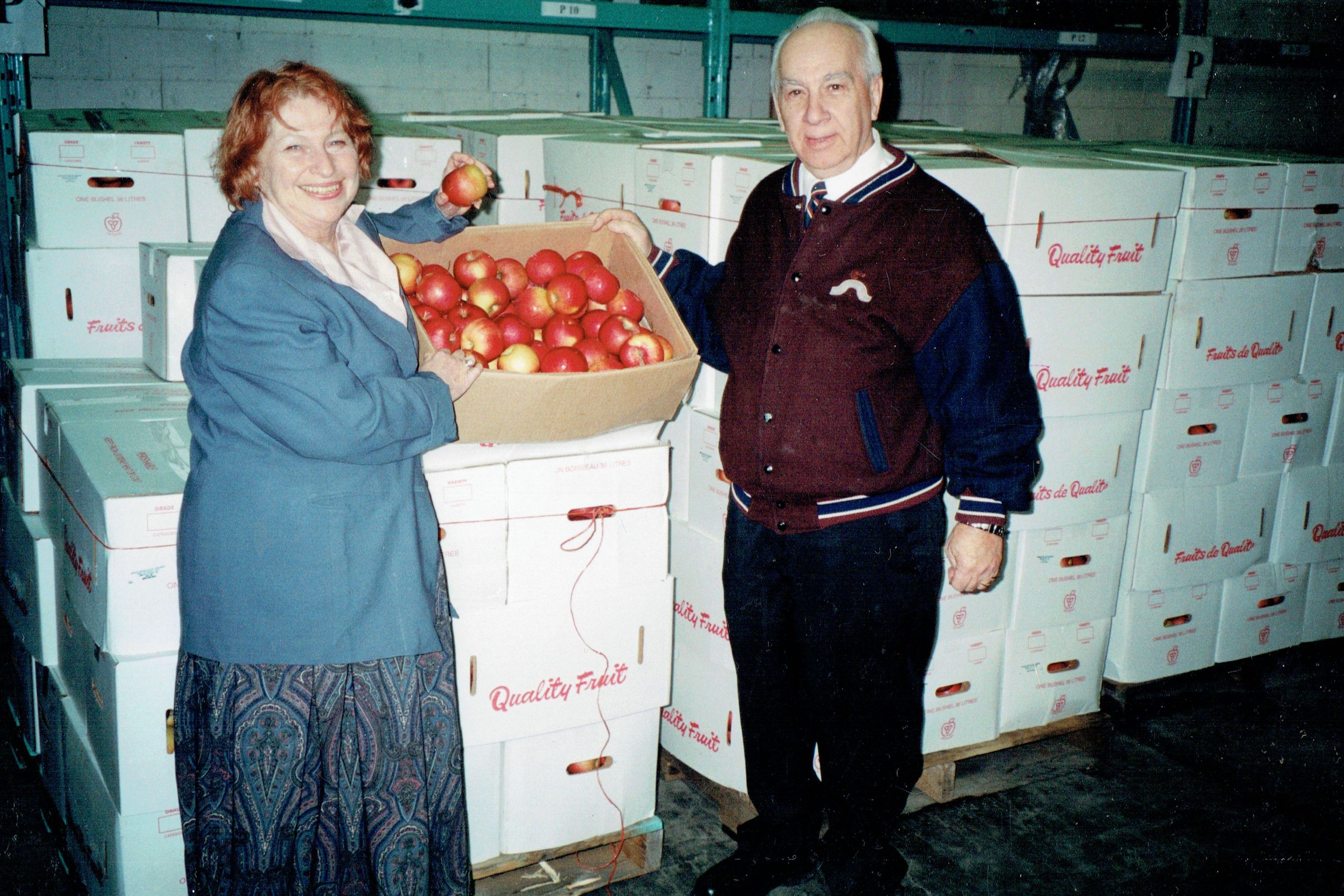 Sue Cox, executive director of the Daily Bread Food Bank in Toronto, accepts a large donation of apples from bishops’ storehouse manager Mike Quatrale in 2004. ( Tom Dalziel)
Sue Cox, executive director of the Daily Bread Food Bank in Toronto, accepts a large donation of apples from bishops’ storehouse manager Mike Quatrale in 2004. ( Tom Dalziel)
A Rich Cultural Heritage
Immigration in the Toronto area brought people from many countries into the Church. One sister missionary reported she had taught people from twenty-five different countries in the first six weeks of her mission,[228] and the baptisms in the Canada Toronto East Mission in 2004 came from seventy-six countries.[229] In response, the mission had twenty-two Mandarin-speaking missionaries, four Cantonese-, twenty-two Spanish-, four Korean-, four Portuguese-, and two Farsi-speaking, in 2006.
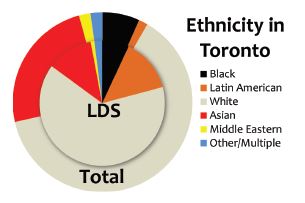
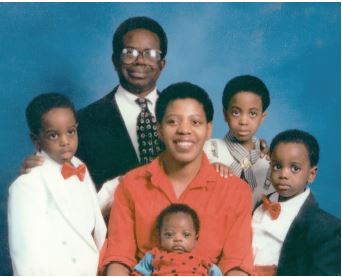 Oswald and Mary Almasi. The Almasi family, are among the many people from other lands and ethnic backgrounds who have joined the Church in Ontario in recent years. Oswald Almasi came to Canada from Tanzania in 1988 to study for a PhD under the Canadian Commonwealth Fellowship and Scholarship Plan. He and his wife, Mary, saw a television program about the Church and called the missionaries which led to their family being baptized. He is a popular professor and has taught Swahili at the University of Toronto for more than twenty years and at York University for twelve years. He and two of his students have published a book on Swahili grammar. (Oswald Almasi)
Oswald and Mary Almasi. The Almasi family, are among the many people from other lands and ethnic backgrounds who have joined the Church in Ontario in recent years. Oswald Almasi came to Canada from Tanzania in 1988 to study for a PhD under the Canadian Commonwealth Fellowship and Scholarship Plan. He and his wife, Mary, saw a television program about the Church and called the missionaries which led to their family being baptized. He is a popular professor and has taught Swahili at the University of Toronto for more than twenty years and at York University for twelve years. He and two of his students have published a book on Swahili grammar. (Oswald Almasi)
At the death of President Gordon B. Hinckley on 27 January 2008, Thomas S. Monson was sustained as President of the Church, just as William Davies had predicted when he first met the Monsons in the Ossington Chapel in 1959. On 25 May 2008, President Monson and his wife, Frances; their daughter, Ann Dibb; M. Russell and Barbara Ballard; and Elder Steven E. Snow returned for an all-Canada Stake Conference held at the Brampton Ontario Stake centre, which was broadcast to stakes across the country.
Public Affairs and Community Service
A full-time LDS Public Communications office had been opened in Toronto with Richard R. Robertson as the national director in the early 1970s, and he served until after the temple dedication in 1990. Missionary couples followed, constantly building bridges of friendship in the community. William B. Smart, former publisher of the Deseret News, and his wife, Donna, worked with Toronto-based Vision TV to air a television series on the Church called For All Seasons, which was broadcast across Canada.
V. Dallas and Karen Merrell were serving as Public Affairs missionaries when Pope John Paul II came to Toronto for World Youth Day in 2002. Elder Merrell had been a member of the Second Quorum of the Seventy, and he and his wife approached Youth Day organizers with an
offer to provide volunteers to assist their Catholic neighbours. Over 350 LDS volunteers completed many assignments and worked closely with Father Thomas Rosica, the national director for the event. He brought Flora Nabrotzky, a florist from Walkerton, to provide magnificent fresh flower arrangements at every place the Pope was speaking. When the Merrells were asked why they were doing this, they explained, “We love the Saviour, and we want to serve Him.”[230] In 2003, the Merrells arranged for the presentation of Family Values Awards to Father Rosica, George Haley—US Ambassador to the Gambia and brother of Alex Haley of Roots fame—Mississauga Mayor Hazel McCallion, and Dolina Smith, the wife of Bruce Smith and an LDS antipornography activist who had spent twenty-five years defending youth against sexual exploitation.[231]
In 2005, the film Joseph Smith in Upper Canada, was produced by the Toronto area stakes with the inspired supervision of Toronto Key City Public Affairs Director, Terry Smith, to commemorate the 200th anniversary of the birth of Joseph Smith and his missions to Ontario. In 2008, Helen Warner, who became Public Affairs Director for Ontario, Quebec, and the Atlantic Provinces, arranged that one thousand letters from Ontario Primary children, carefully displayed in scrapbooks, be presented to Premier Dalton McGuinty, thanking him for proclaiming an annual February Family Day holiday in the province. One young letter writer suggested, “If you have any other ideas for holidays, go for it.”[232]
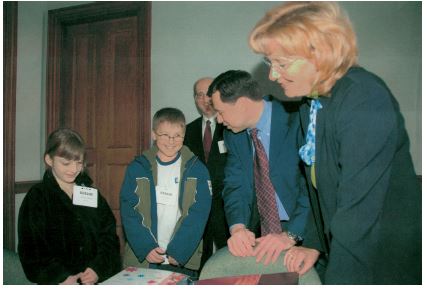 Two Primary children, Rebekah Murray and David Aguiar, presented 1000 letters, written by Primary children across the province, to Ontario Cabinet Minister Brad Duguid and Member of the Provincial Parliament Linda Jeffrey, asking them to thank Premier Dalton McGuinty for proclaiming the new February Family Day holiday. (Tom Dalziel)
Two Primary children, Rebekah Murray and David Aguiar, presented 1000 letters, written by Primary children across the province, to Ontario Cabinet Minister Brad Duguid and Member of the Provincial Parliament Linda Jeffrey, asking them to thank Premier Dalton McGuinty for proclaiming the new February Family Day holiday. (Tom Dalziel)
In 2006, women from the Brampton and Mississauga Stakes, and later the Hamilton and Kitchener Stakes, began an ongoing program at the Vanier Centre for Women, the provincial jail in Milton, Ontario. They donated children’s books and went to the jail weekly to record women reading to their children and grandchildren. A CD of the recording and the book are sent to the children. Over 300 CDs and books are sent every year to children as far away as Florida, Alberta, and the East coast of Canada. The program has won several awards and one woman wrote, “In this rough period of my life, where my freedoms are taken away, the group of wonderful ladies who faithfully come in every second Wednesday[233] are not only a ray of sunshine and hope, you are my voice, my connection to my most precious possession, my little girl . . . . There are not enough words to express how grateful I am for the difference you are making for my daughter and me.”[234]
In 2008, a television production company phoned the Public Affairs office and invited the Church to be included in a thirteen-part television series on the “rites of passage” in different faiths. The production team were told that the “rite of passage” for Latter-day Saints was when our young men and women go on missions, which prepares them to return as leaders in our Church communities. The producers decided to devote a complete half-hour segment to the Church and the preparation of our young men and women from birth for lives of service. The series was aired on BYU-TV and other stations in North America, and in Europe, Asia, and Russia.[235]
In 2009, a Humanitarian Award was presented by Public Affairs to the Toronto-based charity Sleeping Children Around the World, where Consuls General from India and the Philippines joined Church leaders in celebrating the one millionth bed kit that the charity had donated to children in third world countries. Missionaries served as volunteers at their office.[236]
President Monson’s reminder that members of the Church are the Lord’s hands on the earth and the purchase of 300 Mormon Helping Hands vests encouraged Ontario wards and stakes to reach out to communities with service projects from tree planting to spring clean-ups. When severe flooding took place along the Richelieu River in Quebec, 550 youth from Quebec, Ontario, and the Atlantic provinces answered an appeal from Area Seventy, Elder W. T. David Murray, to meet at the St. Jean-sur-Richelieu Chapel on Saturday, 11 June 2011, to help with cleanup.[237]
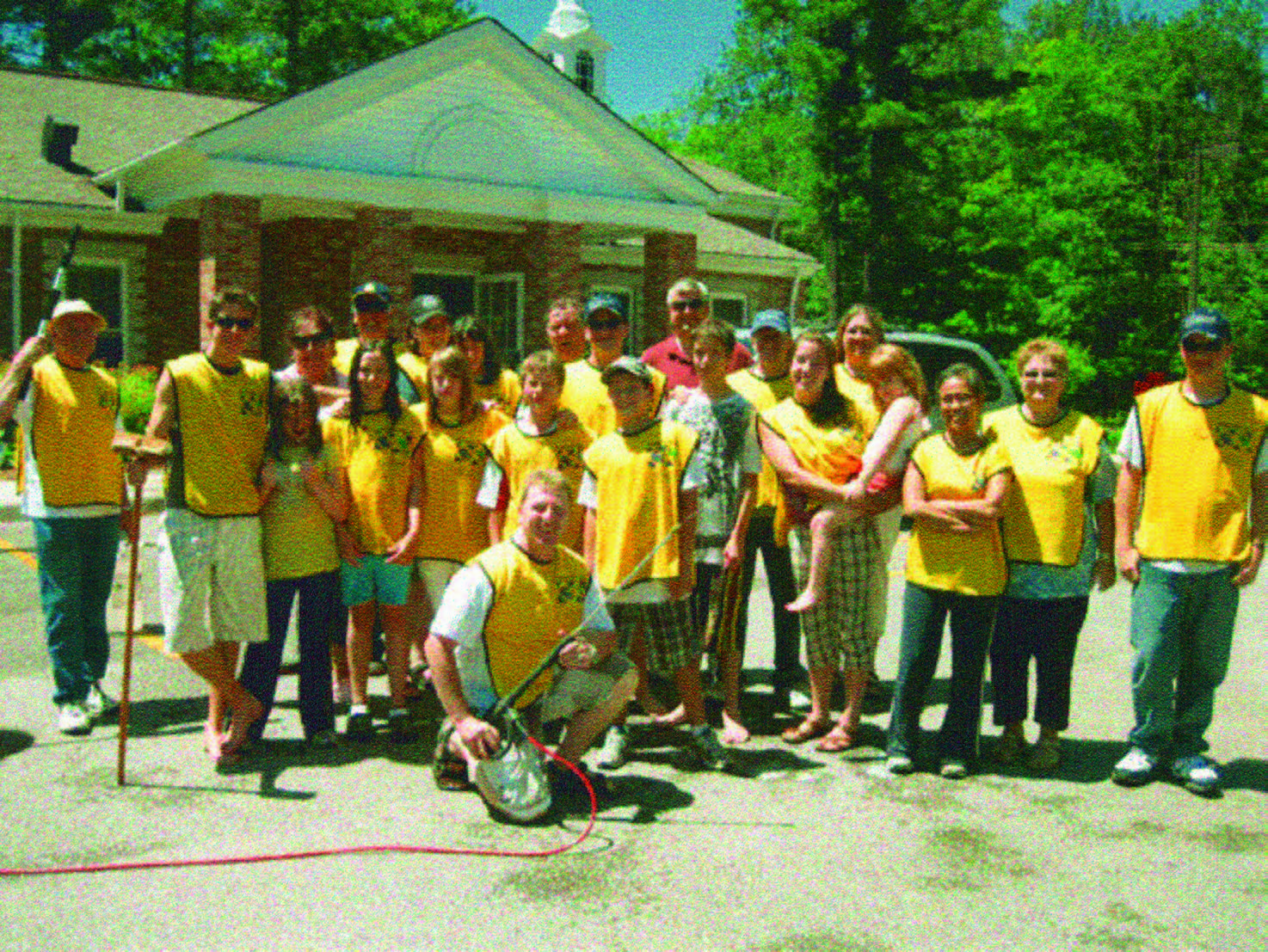 Members of the Midland Branch, wearing Mormon Helping Hands vests, gathered in June 2010 to be of assistance to the victims of a tornado, which had caused much devastation in their community. (David Kunkel)
Members of the Midland Branch, wearing Mormon Helping Hands vests, gathered in June 2010 to be of assistance to the victims of a tornado, which had caused much devastation in their community. (David Kunkel)
Latter-day Saints throughout Ontario participate in many Christ-centred events each year at Christmas. Live outdoor nativity pageants are held in Kingston, Kitchener, London, Ottawa, Newmarket, and Brampton. In Kingston, the pageant celebrated it fortieth year anniversary in 2016 and has been a long-standing Christmas tradition for the several thousand who attend each year. Adapted from the Calgary nativity pageant, it served as a model for pageants in Ottawa and Newmarket.[238] The Newmarket Pageant includes the mayor and members of the town council acting as wise men. So far, during the twenty-seventh years of its run, four mayors have participated. After one nativity pageant in Brampton, held in front of the barn in a city park with live animals, the program supervisor for the city wrote, “I cannot express to you and your team how absolutely AMAZING your contribution was to our Winter Lights. . . . I can’t even express the deep gratitude that I personally feel.”[239]
Flora Nabrotzky organized the largest crèche display in Canada in the Walkerton Branch chapel of the Kitchener Ontario Stake with 2,300 crèches loaned by people in the community, and the event attracted thousands of visitors and widespread media coverage. The Ottawa stake joined various Christmas parades with a simple float with a stable, bales of hay and a manger on a flatbed trailer. Members wore costumes used in the stake’s nativity pageant, and Mormon Tabernacle Choir Christmas music played on large speakers. At the Parade of Lights in Orleans, the float from Ottawa’s Chapel Hill Ward won the “Best Christmas Spirit” trophy, and many onlookers applauded when they saw the float celebrating the birth of Christ instead of a commercialized Christmas.[240]
The “One World, One Family” conference held yearly since 2010 in the Greater Toronto Area invites hundreds of family history enthusiasts to Latter-day Saint meetinghouses with classes on research from countries around the world. A letter of welcome from the Prime Minister of Canada is read every year, and senators, Members of Parliament and mayors have all addressed the conference.
President Monson and his daughter, Ann, returned again on 25 June 2011, for the dedication of the Thomas S. Monson Recreation Camp, a beautiful 161-hectare (398-acre) site purchased on the shores of Little Bald Lake, near Buckthorn, Ontario.
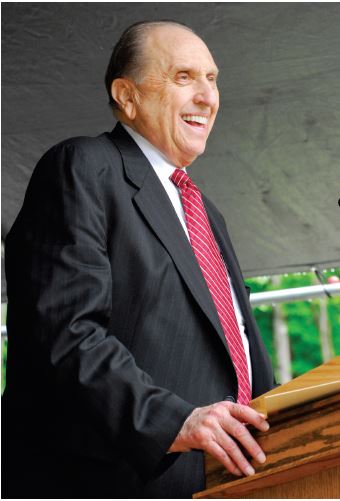 President Monson speaking at the dedication of the Thomas S. Monson Recreation Camp on 25 June 2011. At the beginning of the service, there was heavy rainfall, which stopped just as the first speaker concluded. President Monson acknowledged that “he had offered a little prayer, ‘Please don’t let it rain on their event.’”[241] (Kevan Ashworth)
President Monson speaking at the dedication of the Thomas S. Monson Recreation Camp on 25 June 2011. At the beginning of the service, there was heavy rainfall, which stopped just as the first speaker concluded. President Monson acknowledged that “he had offered a little prayer, ‘Please don’t let it rain on their event.’”[241] (Kevan Ashworth)
Right after the dedication, they attended a performance of the Mormon Tabernacle Choir at Roy Thomson Hall. Father Thomas Rosica, Chief Executive Officer of the Catholic Salt and Light television network and past manager of World Youth Day in Toronto with Pope John Paul, was guest conductor for one of the performances. Jerry Gray, of the folk singing group “The Travellers,” was guest conductor in the evening performance leading the Canadian version of “This Land Is Your Land,” which the group had popularized in the 1950s.
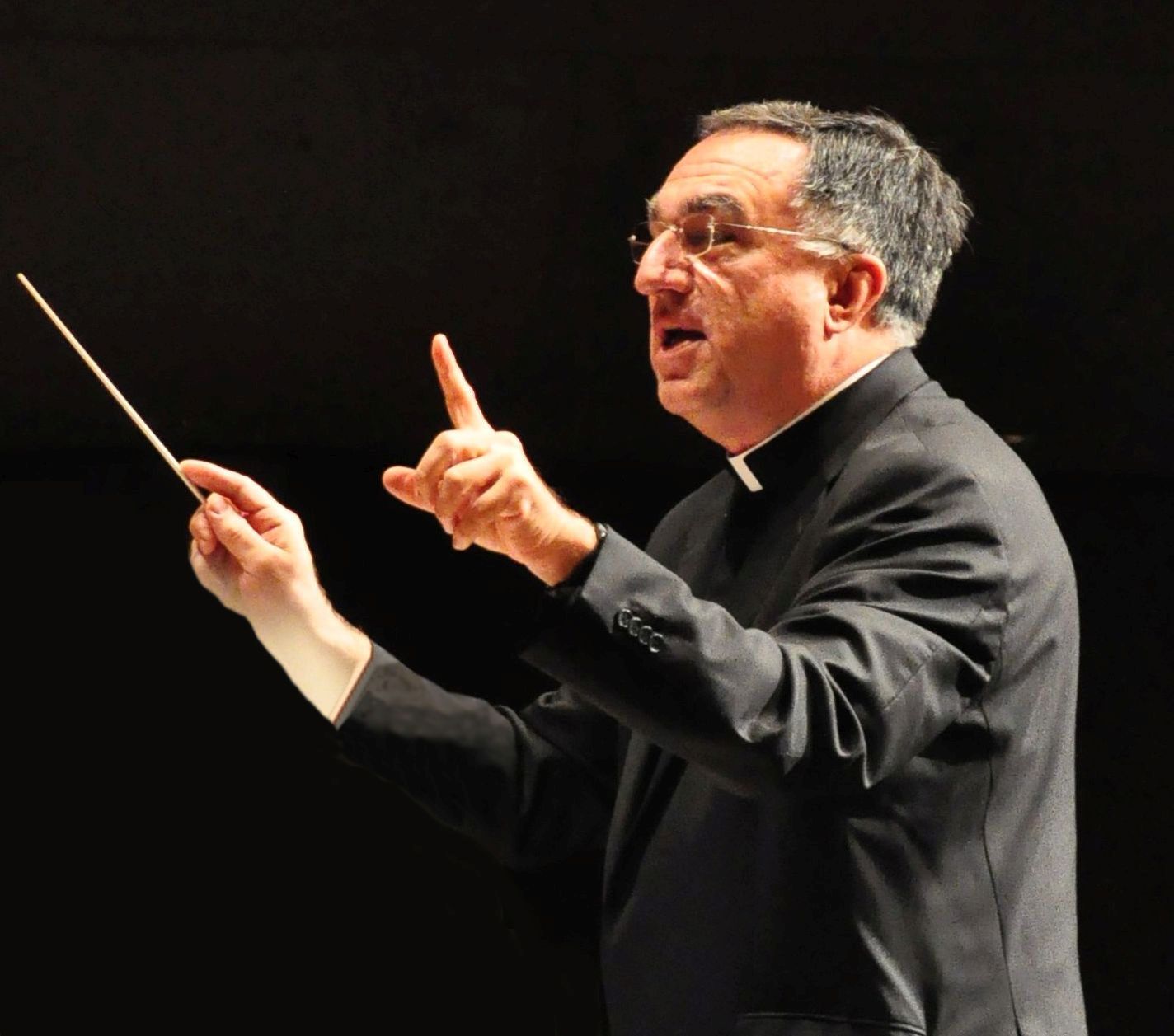 Father Thomas Rosica, a revered Catholic leader, was a guest conductor at a performance of the Mormon Tabernacle Choir in Toronto’s Roy Thomson Hall in 2011. (Deb Gehris)
Father Thomas Rosica, a revered Catholic leader, was a guest conductor at a performance of the Mormon Tabernacle Choir in Toronto’s Roy Thomson Hall in 2011. (Deb Gehris)
On 27 June 2011, it was announced that the two missions based in Toronto would be combined and become the Canada Toronto Mission with headquarters in Brampton. The mission president was Brandon J. Brower, who as a missionary in Ontario had been an assistant to M. Russell Ballard when he served as mission president in Ontario and who had married Tammy Ballard.
Barrie Ontario Stake – 19 February 2012
The Barrie Ontario Stake was created with units from the Brampton and Kitchener Ontario Stakes at a historic multistake conference under the direction of Elder Paul E. Koelliker, accompanied by Elders Stanley G. Ellis and W. T. David Murray, in the Brampton Stake Centre. Wesley D. Smith was called as the stake president, with wards in Barrie, Lake Simcoe, Newmarket, Orangeville, and Owen Sound, and branches in Midland, Stayner, and Orillia. At the same conference, units in the Brampton, Hamilton, Kitchener, and Mississauga Ontario Stakes were realigned. The Mississauga Ontario Stake was dissolved, and the Black Creek, Etobicoke, Mississauga, and Weston wards were reassigned to the Brampton Ontario Stake. The Oakville Ward went to the Hamilton Ontario Stake, and the Brantford Ward was transferred to the Kitchener Ontario Stake.[242]
What about northwestern Ontario and Bergland, home of the first chapel in Ontario? The Canada Winnipeg Mission, formed in 1976, includes the Fort Frances District with branches in Atikokan, Bergland, Dryden, and Fort Frances in Ontario and the International Falls Branch in Minnesota. Robert Olson, Bergland’s current branch president, is the grandson of Peter John Olson, the first branch president. The old one-room chapel dedicated in 1925 was torn down to make way for a new one.
On 9 May 1993, the Duluth Minnesota Stake was created with Thunder Bay, Ontario, as one of its wards. The city holds the record for reaching the coldest temperature with wind chill ever recorded in the area in January 1982 when the temperature dropped to –36°C (–33.3°F) with wind chill temperature at –58°C (–72.4°F).[243] Spencer W. Kimball gave the dedicatory prayer for Thunder Bay’s Moodie Street chapel in 1951, and promised the Saints that if they were faithful and dedicated, there would be a stake with a stake centre in the city.[244] The Kenora Branch, close to the Manitoba border, is part of the Winnipeg Manitoba Stake. Central and eastern Ontario are in the North America Northeast Area of the Church. Northwestern Ontario is in the North America Central Area.
Communication in the stakes changed as national Church websites became available to members in Ontario: www.mormonnewsroom.ca and www.presse-mormon.ca are the Canadian newsroom sites and https://
Lawyer Sandra Pallin became the National Director of Public Affairs for Canada in 2011 when the various public affairs councils across the country were brought together under one roof. The national office is in the Etobicoke chapel in Toronto where provincial directors gather for training from Salt Lake City and from North America Northeast Area leaders.
The October 2012 announcement that missionary service age would change from nineteen to eighteen for elders and from twenty-one to nineteen for sisters created logistical challenges for mission president Brent Scott. The mission complement went from 205 to 285 missionaries, and forty new areas were opened. Some missionaries who had been in the mission only five weeks were training new missionaries and some were training more than one missionary at a time. It took months for new cars to be delivered, so walking, biking, busing, or sharing a car became the norm in many areas. President Scott directed the missionaries to be positive and that this was “another testimony that the Lord is hastening his work. . . . You are literally making history. What an opportunity! The Lord will bless us. This is His work. He knows what needs to be done.”[245]
Later that year, Elder Tyler James Johnson returned to complete his mission. He had been hit by a car the previous year while serving in Toronto and had sustained severe head trauma, brain injury, and multiple bone fractures. He had spent weeks in a medically induced coma with his parents at his side until he was well enough to return to Alberta, where he spent three months in the hospital and another year in treatment and rehabilitation. On his return to Ontario, he said, “I was always planning on coming back; I can’t think of anything else that would be better than serving my mission.”[246]
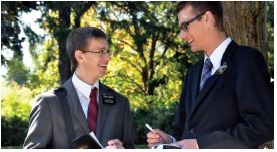 Missionaries Tyler James Johnson, left, from Taber, Alberta, and Paul McMullin from Raymond, Alberta. In 2012, Elder Johnson returned to finish his mission in the Canada Toronto Mission, after having been severely injured in an accident the previous year. (Lori LaFrance)
Missionaries Tyler James Johnson, left, from Taber, Alberta, and Paul McMullin from Raymond, Alberta. In 2012, Elder Johnson returned to finish his mission in the Canada Toronto Mission, after having been severely injured in an accident the previous year. (Lori LaFrance)
Conclusion
Elder Johnson’s attitude sums up the dedication and devotion of the thousands of members and missionaries who have served in Ontario since Nephi Jensen opened the mission in 1919. Today we reap the benefits of their faith and sacrifice. The few isolated branches in Ontario have grown to one-hundred congregations with over 52,000 members.[247] Members from Ontario have served as mission presidents in other countries and as General Authorities. Visitors to Latter-day Saint chapels on Sundays are greeted by members who have gathered from every corner of the globe.
When President Monson spoke of the members who gathered for the dedication of the Toronto Ontario Temple in 1990, he said he reflected on the many nationalities represented by our members, and said it was an example of the promise in Jeremiah: “I will take you one of a city, and two of a family, and I will bring you to Zion” (Jeremiah 3:14).[248]
The members in Ontario have built their Zion as they have built a temple, chapels, and stake centres and reached out in their communities to serve their fellowmen. We have seen the fulfillment of the Lord’s prophecy in Doctrine and Covenants 100:3, “I have much people in this place, in the regions round about; and an effectual door shall be opened in the regions round about in this eastern land.”
Notes
[1] Richard E. Bennett, “A Study of the Church of Jesus Christ of Latter-day Saints in Upper Canada 1830–1850” (unpublished Masters Thesis, Brigham Young University, 1975).
[2] 1861 Canadian Census. Note that the Community of Christ, formerly The Reorganized Church of Jesus Christ of Latter Day Saints, used The Church of Jesus Christ of Latter Day Saints at their name also from 1860 to 1874, so some on the census could have been members of that church.
[3] Journal of New York Conference of The Eastern States Mission of The Church of Jesus Christ of Latter-day Saints (hereafter JNYC, ESM), Commencing March 3-1912, Canadian Mission historical reports (hereafter CM-hr), box 1, folder 1, 20, 27 April 1912, 5–6, Church History Library, Salt Lake City (hereafter CHL), LR 6520 31; Liahona, The Elders’ Journal, 21 November 1916, 332–34, in Eastern States Mission, New York New York South Mission manuscript history and historical reports (hereafter NYNYSM-mh&hr), box 2, folder 3, 21 November 1916, CHL, LR 2475 2.
[4] J. Melville Warwick, “The Earliest Branches of The Church of Jesus Christ of Latter-day Saints in the Province of Upper Canada (1832–1844) and of the Reorganized Church of Jesus Christ of Latter Day Saints in the Same Area (1862–1888), 1952, 17–19, CHL, M277.1 W299e; JNYC, ESM, Commencing March 3-1912, CM-hr, box 1, folder 1, 19, 26 October 1912, 31–32, November 1913, CHL, LR 6520 31.
[5] R. C. Miller, Liahona, The Elders’ Journal, 30 May 1911, 796; Clara Aletta Kindig, FamilySearch, L49M-5NK, accessed 12 November 2014, www.familysearch.org.
[6] “Funeral Service—The Work in Toronto,” Liahona, The Elders’ Journal, 22 June 1907, 24, in Eastern States Mission (hereafter ESM), NYNYSM-mh&hr, box 1, folder 2, 22 June 1907, CHL, LR 2475 2.
[7] “A conference of the Toronto Branch of the Church of Jesus Christ of Latter-day Saints was held at the Labor Temple (a building used by unionized labor, the location of which has not been determined) on [29 September 1907]. President G. C. Turner of the New York Conference presided.” Liahona, the Elders’ Journal, 5:502 quoted in Everitt Pallin, The Toronto Branch 1836–1960, 7.
[8] ESM, NYNYSM-mh&hr, box 1, folder 2, 31 December 1907, CHL, LR 2475 2.
[9] Pallin, Everett, p. 6
[10] Francis G. Weeks and Roderick W. McLeod, Our Covenant Heritage: A history of The Church of Jesus Christ of Latter-day Saints in Fort William and Port Arthur (Thunder Bay), and the North of Lake Superior, (Thunder Bay, Ontario: Thunder Bay Ward, 1999).
[11] Bergland Branch general minutes, 1, CHL, LR 681 11.
[12] JNYC, ESM, Commencing March 3-1912, CM-hr, box 1, folder 1, March 1912, 1, CHL, LR 6520 31.
[13] JNYC, ESM, Commencing March 3-1912, CM-hr, box 1, folder 1, 30 March and 6 April 1912, 2–3, CHL, LR 6520 31.
[14] JNYC, ESM, Commencing March 3-1912, CM-hr, box 1, folder 1, 4 May and 20 July 1912, 7, 21, CHL, LR 6520 31.
[15] JNYC, ESM, Commencing March 3-1912, CM-hr, box 1, folder 1, 2 November 1912, 37, CHL, LR 6520 31.
[16] Evelyn Thompson, History of the Bracebridge Ward, unpublished manuscript.
[17] JNYC, ESM, Commencing March 3-1912, CM-hr, box 1, folder 1, November 1913, CHL, LR 6520 31; Liahona, The Elders’ Journal, 6 October 1914, 235–37, in ESM, NYNYSM-mh&hr, box 2, folder 2, 6 October and 7 November 1914, CHL, LR 2475 2.
[18] Liahona, The Elders’ Journal, 21 November 1916, 332-34, ESM, NYNYSM-mh&hr, box 2, folder 3, CHL, LR 2475 2; Liahona, the Elders’ Journal, 23 July 1918, ESM, NYNYSM-mh&hr, box 2, folder 4, CHL, LR 2475 2; Canadian Mission Historical Reports, box 1, folders 2 and 3, 28 November 1916 and August–October 1918, CHL, LR 6520 31.
[19] Margaret Jensen, wife of Nephi Jensen, mission president, to Amy Brown Lyman, Relief Society General Board, 12 October 1921, Canadian Mission Relief Society Correspondence, 1920-1925, CHL, LR 6520 27.
[20] Liahona, The Elders’Journal, Vol. 11, p, 347.
[21] Goddard, William D. A History of the Mormons in the Hamilton Area, 1833–1990, 1990, 24–25.
[22] Ibid.
[23] JNYC, ESM, Commencing March 3-1912, CM-hr, box 1, folder 1, 4 April 1913, 62, and [insert day] April and 8 August 1914, CHL, LR 6520 31.
[24] JNYM, ESM, Commencing March 3-1912, CM-hr, box 1, folder 1, 8 August 1914, 15–30 January 1915, CHL, LR 6520 31.
[25] JNYC, ESM, Commencing March 3-1912, CM-hr, box 1, folder 1, 13–29 April 1915, CHL, LR 6520 31.
[26] Liahona, The Elders’ Journal, 11 May 1915, 736–39, in Northern States Mission (hereafter NSM), Illinois Chicago Mission (hereafter ICM), mh&hr, box 2, volume 4, folder 1, 11 May 1915, CHL, LR 6227 2.
[27] JNYC, ESM, Commencing March 3-1912, CM-hr, box 1, folder 1, 8 August 1914, CHL, LR 6520 31; CM-hr, box 1, folder 2, 31 May 1916, CHL, LR 6520 31; Liahona, The Elders’ Journal, 4 April 1916, 651–53, in ESM, NYNYSM-mh&hr, box 2, folder 3, 4 April 1916, CHL, LR 2475 2.
[28] Liahona, The Elders’ Journal, 21 September 1915, 201, in ESM-mh&hr-mh&hr, box 2, folder 3, 21 September 1915, CHL, LR 2475 2. CMHR, box 1, folder 2, 1 September 1915, 30 April 1916, CHL, LR 6520 31. CM-hr, box 1, folder 2, 30 April 1916, CHL, LR 6520 31. Burns’ given name initials are from CM-hr, box 1, folder 3, 18 June 1917, CHL LR 6520 31.
[29] CM-hr, box 1, folder 3, 4 November 1917, August – October 1918, CHL, LR 6520 31.
[30] CM-hr, box 1, folder 3, 26 October 1918 and n.d., but after 27 November 1918, CHL, LR 6520 31.
[31] CM-hr, box 1, folder 2, 12 August, 5 and 16 September, 1 November 1916, and box 2, folder 3, 18 September 1917, CHL, LR 6520 31.
[32] Liahona, The Elders’ Journal, 7 March and 10 October 1916, 587–89 and 237–39, in ESM, NYNYSM-mh&hr, box 2, folder 3, 7 March 1916, CHL, LR 2475 2.
[33] Evelyn Thompson, History of the Bracebridge Ward.
[34] CM-hr, box 1, folder 3, 30 July, 20 August 1917, CHL, LR 6520 31.
[35] The Great Canadian Mission: A Jubilee History, (Toronto: The Canadian Mission of The Church of Jesus Christ of Latter-day Saints, 1969), 29.
[36] CM-hr, box 1, folder 3, June 1918, CHL, LR 6520 31; Liahona, The Elders’ Journal, 23 July and 27 August 1918, ESM, NYNYSM-mh&hr, box 2, folder 4, 23 July and 3 August 1918, CHL, LR 2475 2.
[37] Heber J. Grant, in Conference Report (hereafter CR), June 1919, 117.
[38] Nephi Jensen, in CR, June 1919, 118.
[39] Library and Archives Canada, 1911 Canadian Census, bac-lac.gc.ca, shows 7,204,838 population for Canada and 2,523,274 in Ontario; Canadian Encyclopedia, 2nd Ed., vol. III, 1567, 1569, 1572.
[40] See Nephi United States Centennial Jensen (1876–1955), The Strangest Names in American Political History, http://
[41] demographia.com data from United States Census Bureau.
[42] 1920 statistical results of 1920 Salt Lake City, census.gov United States Census Bureau Statistical Abstract, 2003.
[43] 1911 Ontario census results, Canadian Census on bac-lac.gc.ca. Canada’s population was 7,204,838 in the same year.
[44] demographia.com Canada City Population History.
[45] Canadian Encyclopedia, 2nd ed., vol. III, 1569.
[46] Improvement Era, May, 1919.
[47] Letter dated 12 September 1921, from President Nephi Jensen quoted in Great Canadian Mission, 29.
[48] Melvin S. Tagg, “A History of The Church of Jesus Christ of Latter-day Saints in Canada, 1830–1963” (A Dissertation Submitted to the Department of History and Philosophy of Religion, Brigham Young University, Provo, Utah, May, 1963), 246.
[49] When it was built in 1911–1914 by Sir Henry Pellat, the 98 room Gothic Revival castle was the largest private home in Canada and is now a museum and tourist attraction owned by the City of Toronto.
[50] Mark E. Peterson’s mission is covered at length in the Atlantic Provinces chapter.
[51] Tagg, 246, quoting History of the Canadian Mission, MS.
[52] Great Canadian Mission, 29.
[53] Alva O. Jones, quoted in A History of the Mormons in the Hamilton Area, 1833–1990, William D. Goddard, 1990, 47–48.
[54] Effela Rosevear Dyson, Rosevear Family History, quotes in Pallin, The Toronto Branch, 12.
[55] Centre Island is one of a chain of small islands in Lake Ontario offshore of downtown Toronto and accessible by a ten to fifteen minute ferry ride and providing popular parkland, beaches and recreation. TorontoIsland.com
[56] Liahona, May 8, 1921
[57] Liahona, Nov. 5, 1921
[58] Charlotte Taylor, quoted in A History of The Church of Jesus Christ of Latter-day Saints in Brantford & Area, 1833–2004, compiled by Allen N. Hampshire, 99.
[59] Tagg, 249.
[60] Tagg, 249.
[61] Conference Report, Saints Herald, V. 24 no. 9 (May 1, 1877), 131.
[62] Although the city where this interchange took place is not noted, there was a Grand Opera House in Toronto at the time, and none of the other large cities had a building with a similar name, so it is assumed this event occurred in Toronto.
[63] Great Canadian Mission, 28.
[64] Alva O. Jones, quoted in A History of the Mormons in the Hamilton Area, 1833–1990, William D. Goddard, 1990, 28.
[65] Ibid. 28.
[66] William Ayers, quoted in Goddard, 36.
[67] Telephone conversation with Arnold Goodchild Sr., 10 November 2014, with Helen K. Warner.
[68] Orson F. Whitney, “Editorial: Stay Where You Are,” The Latter-day Saint Millennial Star, 15 September 1921, 585.
[69] Bergland Branch general minutes, 1, CHL, LR 681 11.
[70] Ibid.
[71] Great Canadian Mission, 35.
[72] (For entire sidebar) Francis G. Weeks and Roderick W. McLeod, Our Covenant Heritage: A history of The Church of Jesus Christ of Latter-day Saints in Fort William and Port Arthur (Thunder Bay), and the North of Lake Superior, copyright 1999 by the Thunder Bay Ward of the Duluth Minnesota Stake of The Church of Jesus Christ of Latter-day Saints, printed in Thunder Bay, Ontario, Canada, 24–29.
[73] Quarterly Historical Report, Canadian Mission, June, 1960.
[74] Pallin, The Toronto Branch, 19, quoting Bob Mark, son of William and Johan Mark.
[75] Pallin, The Toronto Branch, 25.
[76] Pallin, The Toronto Branch, 27.
[77] General Conference, April, 1931
[78] Pallin, The Toronto Branch, 18.
[79] Pallin, The Toronto Branch, 17–25.
[80] Goddard, 156, “In 1920 the Church was calling 800 missionaries a year and this number had increased to 1200 missionaries per year when the “Depression” began. For the next few years only 400 missionaries per year were able to respond to the mission call. Economic hardships required that most sons stay home to work thus reducing the number available for service.”
[81] Pallin, 24, quoting Canadian Mission Quarterly Report, 95, 96, 99.
[82] David R. Crocket, quoting General Conference, April 1936.
[83] Recollection of author
[84] Pallin, 25.
[85] Alva O. Jones, transcription of tape recording, Goddard, 43.
[86] Records of the Toronto Branch, Church Archives. This reference should have more specific information.
[87] History of the Canadian Mission, 1938.
[88] Deseret News, 25 June 1938.
[89] Pallin, 26.
[90] Pallin, 276–77.
[91] Pallin, 27.
[92] Pallin, 30–31.
[93] Undated page in scrapbook sent to Relief Society members by Jessie R. Ursenbach, Relief Society President of the Canadian Mission, 31 December 1943 to 14 August 1947.
[94] A Brief History of the London Ontario Stake as Part of the Pioneer Sesquicentennial Celebrations, August, 1997 (n.p.: n.d.), 13 states that “the Nauvoo Road was strip of road extending for a distance of five miles, fifty-six rods, which was in November 22, 1851 legally sanctioned by the Brooke Township Council as a township road extending from the road allowance between Concessions 8 and 9 to the Northern Boundary of the Township, its central line being that between Lots 17 and 18.”
[95] Nauvoo Road monument, at http://
[96] Canada Census, 2006.
[97] www1.toronto.ca. Toronto Demographics, Census 2011 Backgrounds, Languages, 2.
[98] 2011 National Household Survey, www.ontarioimmigration.ca.
[99] Bruce C. Hafen, A Disciple’s Life (Salt Lake City: Deseret Book, 2002), 136.
[100] Hafen, 137, 138.
[101] Hafen, 138.
[102] The Presiding Bishopric, Directory of the General Authorities and Officers of The Church of Jesus Christ of Latter-day Saints, 1948.
[103] Quarterly Historical Report, Canadian Mission, 31 March 1961.
[104] Ibid., 30 September 1962.
[105] Talk by Reed A. Benson, “Ezra Taft Benson: The Eisenhower Years,” in Out of Obscurity, the LDS Church in the Twentieth Century, The 29th Annual Sidney B. Sperry Symposium (Salt Lake City: Deseret Book, 2000), with quote from Sheri L. Dew, Ezra Taft Benson: A Biography (Salt Lake City: Deseret Book, 1987), 297, 298.
[106] LeRoy E. Whitehead, “The Kingston Branch, 1920–2002,” in Roy A. Prete, ed., Legacy of Faith, Kingston and Area, 1830 to 2002, 36.
[107] J. Melvin Toone, transcription of undated address to missionaries in the Canadian Mission, in possession of Merrill T. Maxfield, who served as a missionary in the Canadian Mission and was a descendant of 3rd Church President, Pres. John Taylor, one of those who left Toronto in the pioneer exodus.
[108] Irving R. Wilson, The Church in St. Thomas, Recollections of Irving R. Wilson (1920–1991), 2. Unpublished manuscript.
[109] William D. Goddard, A History of the Mormons in the Hamilton Area, 1833–1990 (Hamilton: Self-published, 1990), 70.
[110] Conversation with Russell M. Davies (Pat) and Helen Warner, 2008.
[111] Quarterly Historical Report, Canadian Mission, 31 December 1961.
[112] Heidi S. Swinton, To the Rescue: The Biography of Thomas S. Monson (Salt Lake City: Deseret Book, 2010), 188.
[113] Quarterly Historical Report, Canadian Mission, 31 December 1959. The meeting took place on 28 December of that year.
[114] Swinton, 173.
[115] Quarterly Historical Report, Canadian Mission, 31 March 1961.
[116] Recollection of author
[117] Church News, 23 July 1960.
[118] Recollection of author, who sat in the congregation that day.
[119] Swinton, 121.
[120] Swinton, 162.
[121] Swinton, 118.
[122] Ibid., 193.
[123] Swinton, 192–193.
[124] Personal information of the author. (June Pallin is the author’s sister.)
[125] Quarterly Historical Report, Canadian Mission, 30 September 1960.
[126] Quarterly Historical Report, Canadian Mission, 30 September 1960.
[127] Telephone conversation between Douglas McGinn and Helen Warner, January 2015.
[128] Sudbury Daily Star, article about new chapel and photo, Saturday, 7 January 1961; St. Thomas Times Journal, article about missionaries and new chapels, 17 January 1961; St. Thomas Edition of the London Free Press, photo of workmen on roof of St. Thomas Chapel, 17 January 1961.
[129] Quarterly Historical Report, Canadian Mission, 31 March 1961.
[130] Ibid. March 30, 1960 and Church News article, January 30, 1960)
[131] Quarterly Historical Report, Canadian Mission, Dec. 1969
[132] Ibid., 29 October 1961.
[133] Quarterly Historical Report, 31 March 1963.
[134] Ibid., 30 September 1963.
[135] The Growth of the Church in Thunder Bay, Section III, 71.
[136] Quarterly Historical Report, 31 December. 1964.
[137] Both Orville Tustian and Arthur Murray related the experience to C. Malcolm Warner, a member of the Kitchener Ward.
[138] The Windsor Star, Windsor, Ontario, Saturday, 13 February 1960.
[139] Tom Hawthorn, Special to The Globe and Mail, 20 December 2011.
[140] Quarterly Mission Reports, June, 1964.
[141] Quarterly Mission Reports, 1967.
[142] Quarterly Mission Report, 31 March 1965, with copy of the Toronto Star article with no date attached.
[143] Quarterly Historical Report, 31 March 1967.
[144] Quarterly Historical Reports, March to December, 1969.
[145] Quarterly Historical Report, 30 September 1969.
[146] Quarterly Historical Report, 30 September 1969.
[147] Quarterly Historical Report, December 1969.
[148] Ibid.
[149] Article dated 8 March 1969. Newspaper is not named, but Brampton was written on the clipping in the Quarterly Historical Report, 1969. The only Brampton newspaper at the time was the Brampton Daily Times & Conservator which operated from 1960 to 1971.
[150] “Churchville was officially made a Heritage Conservation District on October 10, 1990” email sent by Antonietta Minichillo, Heritage Coordinator, City of Brampton, 2 February, 2017.
[151] Peel County became the Regional Municipality of Peel in 1974.
[152] Recollections of C. Malcolm Warner and Seminaries and Institute directories in his possession.
[153] Interview between Jean Borrows, Cape Croker and Helen Warner, 2014.
[154] Hampshire, A History of the Church of Jesus Christ, 184.
[155] Quarterly Historical Report, June, 1968
[156] Memory of C. Malcolm Warner, who was travelling with President and Sister Davey.
[157] Personal recollections of the author.
[158] See Ontario, Canada, LDS Historical Country Profile, Church History Library,49
[159] Recollections of C. Malcolm Warner and Kenneth Shoesmith, former stake presidents.
[160] Helen Warner, Toronto Key City Public Affairs Newsletter, Vol. 1, Issue 1.
[161] Unidentified London ON news clipping, 29 April 1978
[162] Church Almanac 2013, 450
[163] See Ontario, Canada, LDS Historical Country Profile, Church History Library 54
[164] Boyden E. Lee, “Achieving Stakehood, The Ottawa Ontario Stake, 1974–1980,” in Zion Shall Come Forth, A History of the Ottawa Ontario Stake, Roy A. Prete, editor, 1995, 47–50.
[165] Ibid., 51.
[166] Liahona, The Elders’ Journal, 31 December 1915 and 15 February 1916, 492–94, 540, in Eastern States Mission, New York New York South Mission manuscript history and historical reports, box 2, folder 3, 31 December 1915 and 15 February 1916, Church History Library, Salt Lake City (LR 2475 2).
[167] See Helen K. Warner, “Ontario,” herein.
[168] Terry Livingstone, interviewed by Matthew K. Heiss, 25 February 2014, CHL, OH 8676.
[169] Walter Brown, “History of the Church in Potsdam,” in Mark Prescott, “The Montreal Quebec Mount Royal Stake,” in Zion Shall Come Forth: A History of the Ottawa Ontario Stake, ed. Roy A. Prete (Kingston, ON: Ottawa Ontario Stake, 1995), 216-17.
[170] From an interview with Karl Jacob, former Branch President in Temiskaming and Helen Warner, 2015.
[171] Quoted by John Farrington in 40th Anniversary, Mississauga Stake Centre, 26.
[172] Ensign, May 1976. Online.
[173] Copy of program in the C. Malcolm Warner collection.
[174] Ibid.
[175] Ibid.
[176] Quarterly Historical Report, Canada Toronto Mission, September 1985.
[177] Gerry Avant, Church News, 26 June 2011.
[178] Church News, 16 August 1997.
[179] “Mormon Partnership Creates 280,000 Life-Saving Meals,” 18 August 2015, www.mormonnewsroom.ca
[180] President Spencer W. Kimball, New Era, April 1980, 36.
[181] Interview with Walter O. Saunders, July 2015, by Helen K. Warner.
[182] Ibid.
[183] Ibid.
[184] Ronald C. Seebach, letter to Helen Warner, 8 September 2015.
[185] Date of sale confirmed by Real Estate Services Division, The Church of Jesus Christ of Latter-day Saints.in telephone conversation by Helen Warner, 1 Feburary 2016
[186] Stephen ZoBell, email to Helen Warner, 3 March 2017, with information from ZoBell’s personal journal.
[187] Ensign, October 1979, “Eastern Canadian Saints Recommit at Toronto” Online.
[188] Ensign, October, 1979 “Eastern Canadian Saints Recommit at Toronto.” Online .
[189] LeGrand Richards, “The Gift of the Holy Ghost,” Ensign, November 1979. Online
[190] Letter to Presidents of Hamilton, Toronto East, Toronto Ontario stakes from Presidents Spencer W. Kimball and Marion G. Romney, dated 10 December 1980, in possession of C. Malcolm Warner.
[191] Personal Journal entry, C. Malcolm Warner
[192] Ensign, May 1984. Online
[193] Quarterly Historical Report, Canada Toronto Mission, 27 September 1985.
[194] Ensign, August 1973. Online
[195] Glenn T. Potter, Historical Events, Canada Toronto Mission, July 1992.
[196] Historica Canada, Thomas Wakeling, Sunday Shopping 25 Jan. 2007,(thecanadianencyclopedia.ca)
[197] United Church Observer, May, 2014 “The United Church is closing congregations at a rate of more than one a week. Dozens, maybe hundreds, of pastoral charges are wondering what comes next. In an Observer readership survey conducted last year, close to half of respondents said their congregation’s membership is shrinking, and a third believed that by 2025, their congregation probably wouldn’t still be using its current building.”
[198] Bruce Smith, email message to Helen Warner, 12 November 2015.
[199] Pallin, The Toronto Branch, 299.
[200] Personal information from C. Malcolm Warner
[201] John L. Hart, Church News, 17 October 1987, 3.
[202] John L. Hart, Church News, 17 October 1987, 3; also Mark Alan Staff photos.
[203] George Beshiri, Brampton Guardian, undated.
[204] Recollections of Everett and John Pallin.
[205] Recollection of author who was involved in the production of the slippers.
[206] Brampton Guardian, 12 August 1990, 1, 4.
[207] From a comment card list from C. Malcolm Warner.
[208] From obituaries, Lindquist Mortuaries and Cemeteries, Layton Utah, and Ottawa Citizen, 12 Dec. 2007.
[209] "Toronto Ontario Temple: Sacred Day of Dedication in Canada," Church News, 1 September 1990, 6.
[210] Conversation with Helen Warner on August 27, 1990.
[211] Temple President C. Malcolm Warner and Helen Warner, Matron, served on the City’s Communities in Bloom Committee.
[212] Personal conversation with author and Brampton Mayor Susan Fennell.
[213] The Harvester, newsletter of the Canada Toronto Mission, President Glenn Potter, 7 June 1993.
[214] Quoted by John Farrington in 40th Anniversary, Mississauga Stake Centre, 29.
[215] Notes from the official program for the Organization of the Sudbury Ontario Stake and the Canada Toronto West Mission Historical Record, May 1996.
[216] Church News, 15 August 1998.
[217] Church News, 15 August 1998; familysearch.org, Erastus Nathaniel Hinckley, L8QW-MVQ; Lois Judd, 9CHB-8R2; Ira Nathaniel Hinckley, KWNV-L3N.
[218] Church News, 15 August 1998.
[219] Information from Roy and Carma Prete, 12 December 2016.
[220] Gerry Avant, Church News, 16 August 1997.
[221] Ibid.
[222] Canada Toronto West Mission Historical Record, September 1999.
[223] Gerry Avant, Church News, 26 August 2000.
[224] Ibid.
[225] John Farrington, “Return to Canada,” Church News, 8 May 2004, www.ldschurchnewsarchive.com/
[226] Michael H. Clifton, “Elder M. Russell Ballard and Sister Barbara Ballard Are Reunited with Friends in Ontario, Canada,” Church News, 8 March 2010, www.ldschurchnewsarchive.com/
[227] Ibid; Michael Clifton, email to Roy Prete, 23 March 2017.
[228] Canada Toronto East Mission History, 2003.
[229] Ibid., 2004
[230] Email correspondence with Karen Merrell, October 2015.
[231] 40th Anniversary Mississauga Stake Centre Commemoration Book, Farringtonmedia, 33
[232] Written by Eli Bishun, Brampton Ontario Stake.
[233] The women visit two units at the jail, so each unit is visited every second Wednesday.
[234] Letter sent to Helen Warner. For security reasons, the letters are never signed or dated.
[235] A telephone call from Michael Judson, Public Affairs Department in Salt Lake City, told the author that they had heard from the Church in Russia that the Rites of Passage program on the Church was aired on television and that “it was very positive.”
[236] Toronto Multi-stake Public Affairs Newsletter 3, no. 4 (2009)
[237] Ontario, Quebec and Atlantic Provinces Public Affairs Newsletter, Vol. 5, Issue 4, 2011
[238] Information from Roy A. Prete, 25 January 2017.
[239] Roberta Canning,, email to Helen Warner., 4 December, 2009
[240] Toronto Key City, Public Affairs Newsletter, Vol. 3, No.1,January–February, 2009 pg.4
[241] Roy A. Prete, unpublished Journal, vol. 46, 1 July 2011; Cf, Gerry Avant, “Pres. Monson in Canada to dedicate Young Women camp named in his honor,” Church News, 25 June 2011. The author was present on the occasion.
[242] Program from Multistake Conference, Sunday, February 19th, 2012, and notes taken by the author.
[243] Airport Data Report, 10 January 1982 , Environment Canada .
[244] The Growth of the Church in Thunder Bay, Section III, 8, reference, 94, Gladys (Winter) Vesina (1997), Information Sheet for History of the Church of Jesus Christ of Latter-day Saints in Thunder Bay.
[245] President Brent Lewis Scott, Letter to Canada Toronto Mission, 13 January 2013, Canada Toronto Mission History, 2013.
[246] www.mormonnewsroom.ca/
[247] Facts and Statistics, Ontario, mormonnewsroom.ca.
[248] President Thomas S. Monson, General Conference, October 1990, “Days Never to Be Forgotten.”
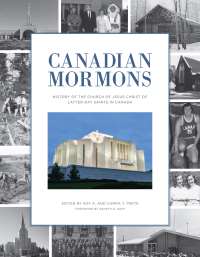
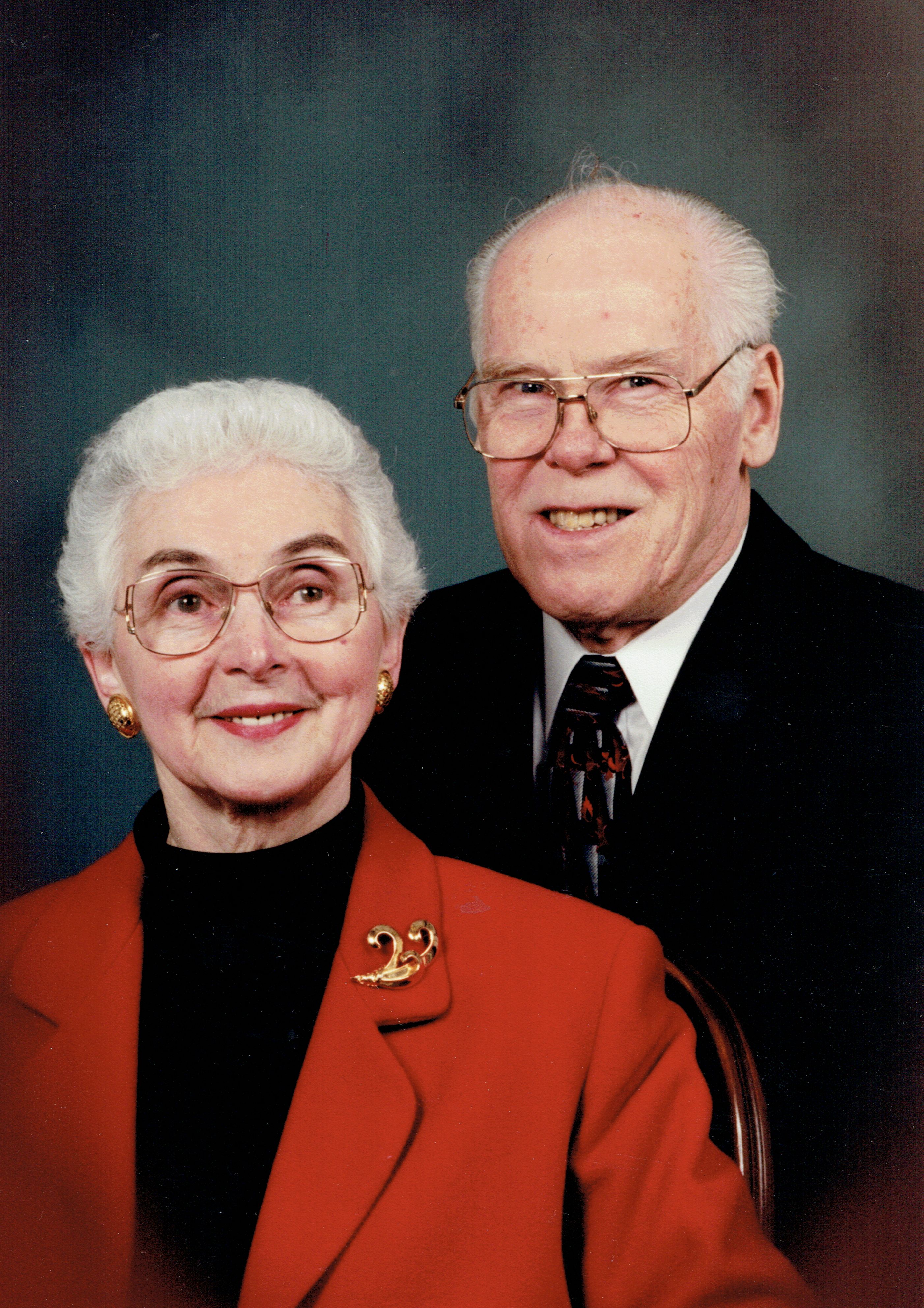 Everett and June Pallin. (Everett Pallin)
Everett and June Pallin. (Everett Pallin)